
STORIES FROM HAWAIIAN AIRLINES






The Launiu Ward Village residences in Honolulu are an artful blend of inspired design and timeless sophistication. Expansive views extend the interiors and a host of amenities provide abundant space to gather with family and friends.
Studio, One, Two, and Three Bedroom Residences INQUIRE
thelauniuhawaii.com | +1 808 470 8066 Offered by Ward Village Properties, LLC RB-21701
THE PROJECT IS LOCATED IN WARD VILLAGE, A MASTER PLANNED DEVELOPMENT IN HONOLULU, HAWAII, WHICH IS STILL BEING CONSTRUCTED. ANY VISUAL REPRESENTATIONS OF WARD VILLAGE, INCLUDING WITHOUT LIMITATION, RETAIL ESTABLISHMENTS, PARKS, AMENITIES, OTHER FACILITIES AND THE CONDOMINIUM PROJECTS THEREIN, INCLUDING THEIR LOCATION, UNITS, VIEWS, FURNISHINGS, DESIGN, COMMON ELEMENTS AND AMENITIES, DO NOT ACCURATELY PORTRAY THE CONDOMINIUM PROJECTS OR THE MASTER PLANNED DEVELOPMENT. ALL VISUAL DEPICTIONS AND DESCRIPTIONS IN THIS ADVERTISEMENT ARE FOR ILLUSTRATIVE PURPOSES ONLY. THE DEVELOPER MAKES NO GUARANTEE, REPRESENTATION OR WARRANTY WHATSOEVER THAT THE DEVELOPMENTS, FACILITIES OR IMPROVEMENTS OR FURNISHINGS AND APPLIANCES DEPICTED WILL ULTIMATELY APPEAR AS SHOWN OR EVEN BE INCLUDED AS A PART OF WARD VILLAGE OR ANY CONDOMINIUM PROJECT THEREIN. WARD VILLAGE PROPERTIES, LLC, RB-21701. COPYRIGHT ©2024. EQUAL HOUSING OPPORTUNITY.
WARNING: THE CALIFORNIA BOARD OF REAL ESTATE HAS NOT INSPECTED, EXAMINED OR QUALIFIED THIS OFFERING.
THIS IS NOT INTENDED TO BE AN OFFERING OR SOLICITATION OF SALE IN ANY JURISDICTION WHERE THE PROJECT IS NOT REGISTERED IN ACCORDANCE WITH APPLICABLE LAW OR WHERE SUCH OFFERING OR SOLICITATION WOULD OTHERWISE BE PROHIBITED BY LAW.
NOTICE TO NEW YORK RESIDENTS: THE DEVELOPER OF THE LAUNIU WARD VILLAGE AND ITS
 THE LAUNIU WARD VILLAGE
THE LAUNIU WARD VILLAGE


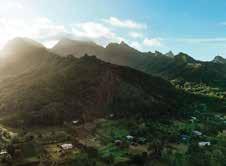
DEPARTMENTS & FEATURES
36 /
Land of the Wayfarers For centuries, Polynesian navigators trained at Mahukona. Now a new generation is finding the way.
STORY BY CONNER GORRY
PHOTOGRAPHY BY MEGAN SPELMAN
STORY BY PETER ROSEGG
PHOTOGRAPHY BY IJFKE RIDGLEY
STORY
STORY BY YVONNE HUNTER PHOTOGRAPHY BY TIM HENNESSY
46 / Wonders of Radiance Hawai‘i’s endemic lobeliads represent one of the most astonishing examples of plant evolution in the world. What will it take to save them?
STORY BY MADDIE BENDER
PHOTOGRAPHY BY OLIVIER KONING 54 / The O‘ahu Nine The long overdue O‘ahu Historic Preservation Commission is determined to protect the island’s historic treasures
STORY BY DW GIBSON
PHOTOGRAPHY BY DESMOND CENTRO
76 / Piled Higher and Deeper Hawai‘i high school graduation lei go over the top
STORY BY DAVID THOMPSON
PHOTOGRAPHY BY MARIE ERIEL HOBRO
88 / The Queen’s Wild Ride For Moana Jones Wong Pipeline is more than a wave, it’s a way of life
STORY BY BEAU FLEMISTER
PHOTOGRAPHY BY ARTO SAARI
96 / The Food of Love After the Maui fires, Chef Hui got cooking
STORY BY SARAH BURCHARD
PHOTOGRAPHY BY J MATT

STORY BY STU DAWRS
PHOTOGRAPHY BY BLAKE ABES
STORY BY DEREK FERRAR
PHOTOGRAPHY BY MATT MALLAMS


PEOPLE OF THE VAKA / For many who live in the Cook Islands, the vaka (canoe) is a way of life. Visit the island of Rarotonga for Vaka Eiva, an annual outrigger canoe paddling festival that draws competitors from around the world to this tiny archipelago between Sāmoa and French Polynesia, a dreamscape of islands and atolls where everything moves at a slower pace—except, of course, for the canoes.
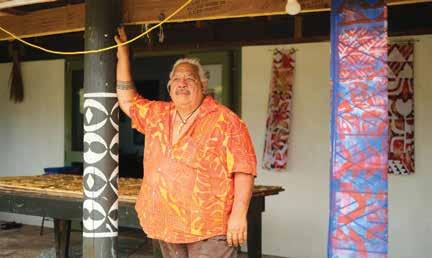
THE WISDOM-KEEPER OF RAROTONGA / From modern art to woodblock-printed pareu to canoe building, Mike and Awhitia Tavioni perpetuate the peu (culture) of Kūki ‘Airani, the Cook Islands. Join Mike in his Gallery Tavioni and Vananga to learn about Cook Island Māori traditions and how he’s passing them on to the next generation.
Forget to take your copy of Hana Hou! from the seat pocket? Miss a story from a back issue? Want to share a story or a video you’ve seen on the in-seat media player or on the Hawaiian Airlines app? Hana Hou! is now online as well as on-screen. Visit our new web site at the link below or scan the QR code to view the current issue and selections from our archive.


hawaiianairlines.com/hawaiistories/hana-hou


PUBLISHER & CEO
Jason Cutinella
PARTNER/GM —HAWAI‘I
Joe V. Bock
GLOBAL EDITORIAL
DIRECTOR
Brian McManus
EDITOR
Michael Shapiro
DIRECTOR OF PHOTOGRAPHY
Matt Mallams
MANAGING DESIGNER
Taylor Niimoto
DESIGNERS
Eleazar Herradura
Coby Shimabukuro-Sanchez
VP FILM
Gerard Elmore
FILMMAKERS
Blake Abes
Romeo Lapitan
Erick Melanson
VIDEO EDITOR
Jhante Iga
STUDIO DIRECTOR/ PRODUCER
Kaitlyn Ledzian
DIGITAL CONTENT MANAGER
Brigid Pittman
DIGITAL PRODUCTION DESIGNER
Arriana Veloso
PRODUCER
Taylor Kondo
HAWAIIAN CULTURAL ADVISER
Kahōkū Lindsey-Asing
OPERATIONS
VP ACCOUNTS RECEIVABLE
Gary Payne
OPERATIONS DIRECTOR
Sabrine Rivera
TRAFFIC MANAGER
Sheri Salmon
CLIENT SERVICES
DIRECTOR
Kristine Pontecha
ADVERTISING
SENIOR DIRECTOR, SALES
Alejandro Moxey
VP SALES
Mike Wiley
ADVERTISING DIRECTOR
Simone Perez
DIRECTOR OF SALES
Tacy Bedell
HEAD OF MEDIA SOLUTIONS & ACTIVATIONS
Francine Beppu
ACCOUNT EXECUTIVE
Oliver Ankar
JUNIOR ACCOUNT
EXECUTIVE
Rachel Lee
SALES COORDINATOR
Will Forni
CONTACT
EDITORIAL INQUIRIES editors@NMGnetwork.com
SALES INQUIRIES sales@NMGnetwork.com
CONTRIBUTORS
Arto Saari
Beau Flemister
Ben Davidson
Blake Abes
Conner Gorry
David Thompson
Derek Ferrar
Desmond Centro
DW Gibson
IJfke Ridgley
J Matt
Jesse Recor
Lesa Griffith
Maddie Bender
Marie Eriel Hobro
Matt Mallams
Megan Spelman
Olivier Koning
Peter von Buol
Peter Gorman
Peter Rosegg
Sarah Burchard
Stu Dawrs
Tim Hennessy
Yvonne Hunter
Published by: NMG Network
36 N. Hotel St., Ste. A Honolulu, HI 96817
©2024 by NMG Network, LLC. Contents of Hana Hou! are protected by copyright and may not be reproduced without the expressed written consent of the publisher. Hana Hou! assumes no liability for products or services advertised herein.

3375 Koapaka Street, G-350 Honolulu, HI 96819 Phone: 808-835-3700
Fax: 808-835-3690
Mailing Address: PO Box 30008 Honolulu, HI 96820
For questions related to travel, visit us online at HawaiianAirlines.com or contact us at any of the following numbers:
UNITED STATES / CANADA 1-800-367-5320
Monday-Sunday, 24 hours Text 38285 Monday-Sunday, 5:00am - 11:00pm HST
AUSTRALIA (61) 1-800-955-912
CHINA (86) 10-6502-6766
JAPAN (81) 570-018-011 Monday-Sunday
NEW ZEALAND (64) 0800-449-415
AMERICAN SĀMOA (684) 699-1875
SOUTH KOREA (82) 2-775-5552
TAHITI (689) 40-866-000
CONSUMER AFFAIRS HawaiianAirlines.com/CAO
BAGGAGE INQUIRIES 1-866-389-6654 Monday-Sunday, 8:00am - 4:30pm HST
H awaiian M iles
For information on our frequent flyer program, please contact our HawaiianMiles Service Center Monday-Friday, 7:00am - 4:30pm HST 1-877-HA-MILES or 1-877-426-4537
HAWAIIAN AIR CARGO INQUIRIES 1-877-422-2746 HawaiianAirCargo.com

ON THE COVER Blue Drift
A paddleboarder glides by the islet of Taakoka in Muri Lagoon, Rarotonga, Kūki ‘Airani (Cook Islands).
PHOTOGRAPH BY BLAKE ABES
 OAHU: ALA MOANA CENTER OUTRIGGER WAIKIKI BEACH RESORT HILTON HAWAIIAN VILLAGE ROYAL HAWAIIAN HOTEL KAILUA VILLAGE SHOPS KAHALA MALL
OAHU: ALA MOANA CENTER OUTRIGGER WAIKIKI BEACH RESORT HILTON HAWAIIAN VILLAGE ROYAL HAWAIIAN HOTEL KAILUA VILLAGE SHOPS KAHALA MALL

“If you want to see what Hawai‘i might have been like back in the day when there were no tall buildings, no stoplights and fewer people, you have to visit the Cook Islands,” says filmmaker and photographer Blake Abes, who captured images and video of Rarotonga, the nation’s largest island for “People of the Vaka.” Made up of fifteen atolls and islands in the South Pacific, the country is home to a population of just under fifteen thousand, about ten thousand of whom live on Rarotonga. “The Cook Islands offer so much beauty no matter what you do or see—from the singing in their historic churches to the turquoise waters of Aitutaki.” Abes was born and raised in Hawai‘i and studied film production at the University of Hawai‘i at Mānoa. When he isn’t editing or on a film shoot for an NMG Network publication, you can find him trying out a new restaurant he found on Instagram.

“I worked for Chef Hui during the pandemic, when we coordinated food drives and stipends for restaurants to make meals for communities in need,” says Sarah Burchard, who wrote about the group of chefs and volunteers delivering meals to the victims of the Lāhainā fires in “The Food of Love.”
“During the fires, many local chefs assembled to cook the first emergency feedings. Eventually, Chef Hui was able to arrange stipends for some of the chefs making meals. Thousands of people sent checks, cards and drawings their kids made. It was difficult to report on a tragedy as devastating as this one, listening to people I know describe losing their homes, restaurants, jobs, and not being able to find loved ones for days. My hope is that Chef Hui will continue to support the chefs, restaurants and farms still struggling and the communities still in need of food.” Burchard is a freelance food and travel writer who champions small farms, mom-and-pop spots and local ingredients. Her work has been featured on Forbes.com, in FLUX Hawai‘i, edible Hawaiian Islands, HONOLULU and more.
Maddie Bender
“The threats to Hawaiian lobeliads are substantial, but they’re not new,” says Maddie Bender, who wrote “Wonders of Radiance” about these endangered plants. “The folks I met who work to conserve Hawai‘i’s endemic lobeliads are themselves a small group, but they’re a winning combination of passionate and competent. They’re doing an amazing job of keeping these species alive in the short- and midterm. I met Lucas Fortini of the US Geological Survey, who carried a piece of a Cyanea calycina plant he was monitoring out of the forest on his shoulders after an invasive Brazilian pepper tree fell and decapitated its main stem. The plant survived and was outplanted months later! To see lobeliads thrive again requires buy-in from even more stakeholders, as well as kama‘āina and visitors—the Lobelia oahuensis outplantings I saw are evidence that these big swings can pay off if we all do our part.” Bender is a science, health, and technology reporter and a recent transplant to Honolulu.
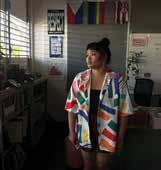
“Growing up in Hawai‘i, lei ceremonies seemed like such a normal part of graduation,” says photographer Marie Eriel Hobro, who shot “Piled Higher and Deeper” for this issue. “But I later realized how special the tradition is and that it really doesn’t exist anywhere else at this same level of extravagance. While photographing my sister’s graduation in 2018, I realized what an amazing subject it could make, and I began documenting the graduation season the following year. In 2020, during the pandemic, families found ways to bring this tradition to their graduates at home. Some went all-out and had drive-by lei ceremonies reminiscent of celebrity meet-and-greets. It was beautiful to see so many people go out of their way to give graduates that experience. So many youths in Hawai‘i look forward to it, and they got to do it in their own, unique way.” Hobro is a documentary photographer, writer, filmmaker and educator from O‘ahu. See more of her work at marieerielhobro.com.




Hawaiian Airlines is committed to achieving net zero greenhouse gas emissions by 2050. One way we’ll get there is to work with suppliers like Par Hawaii (pictured) to increase the availability and use of sustainable aviation fuel.
Our aircraft often approach Honolulu by descending over O‘ahu’s southwestern coast, giving guests spectacular views of the turquoise surf and the towering Wai‘anae mountain range. Looking out the window, they may also see Par Hawaii, the largest supplier of energy products in the state. The 130acre refinery in Kapolei shares more than just our flight path—it also shares our vision and commitment to build a more sustainable future for air transportation to, from and among our Islands.
What does that vision look like? For us, as Hawai‘i’s largest and only major airline, it is to bring our greenhouse gas emissions to net zero by 2050. Although commercial aviation is an energyintensive sector, airlines account for just about 2 percent of global greenhouse gas emissions, thanks to our industry’s investments in fleet and engine modernization along with operational efficiencies. Driven by the urgency of climate change, we are constantly
looking to reduce our environmental impact, and sustainable aviation fuel, or SAF, is the most promising opportunity to help us achieve our goals.
Made from more sustainable feedstock (think plant-based and waste oils, or even municipal waste) SAF can have a life-cycle carbon intensity that is 50 to 80 percent below traditional petroleum jet fuel, making it the best available technology to lower our emissions. SAF is also a “drop-in fuel,” meaning it can be safely used with existing infrastructure, like storage tanks, and in our aircraft and engines when blended up to 50 percent with conventional jet fuel. However, as a nascent industry, SAF can be three to five times more expensive than conventional fuel, and it is so far unavailable in Hawai‘i. We are working with Par Hawaii to change that. Together, we are studying the commercial viability of developing SAF in our home state. Par is investing $90 million to convert a diesel-producing
unit into one that would instead make some 60 million gallons of renewable fuels as early as next year.
In parallel, Par Hawaii is also collaborating with Pono Pacific, Hawai‘i’s largest private natural resource conservation company, to identify and develop local sources of plant-based oil for renewable diesel and SAF. Pono Pacific is conducting crop trials of potential biofuel feedstocks across the Islands, including one involving the camelina plant on O‘ahu’s North Shore. Developing an economical oil crop in Hawai‘i will provide a quality local biofuel supply and usable byproducts, such as animal feed, that support Hawai‘i’s sustainability goals as well as its agricultural, ranching and dairy sectors. This will also advance our state’s energy security and independence.
As these studies progress, we are not sitting idle on our net-zero emissions journey: We have committed to sourcing SAF for 10 percent of our fuel needs by 2030. To get us started, we agreed to purchase 50 million gallons of SAF from biofuel company Gevo, Inc., with deliveries beginning in 2029.
Our decarbonization path is as challenging as it is exciting, with innovation, partnerships and new discoveries constantly re-energizing our work and giving us more confidence that we can succeed. We look forward to continuing to collaborate with fuel producers, states and the federal government to accelerate SAF production and availability so that we can become an even more sustainable company for our guests, employees and communities.
From our ‘ohana to yours,



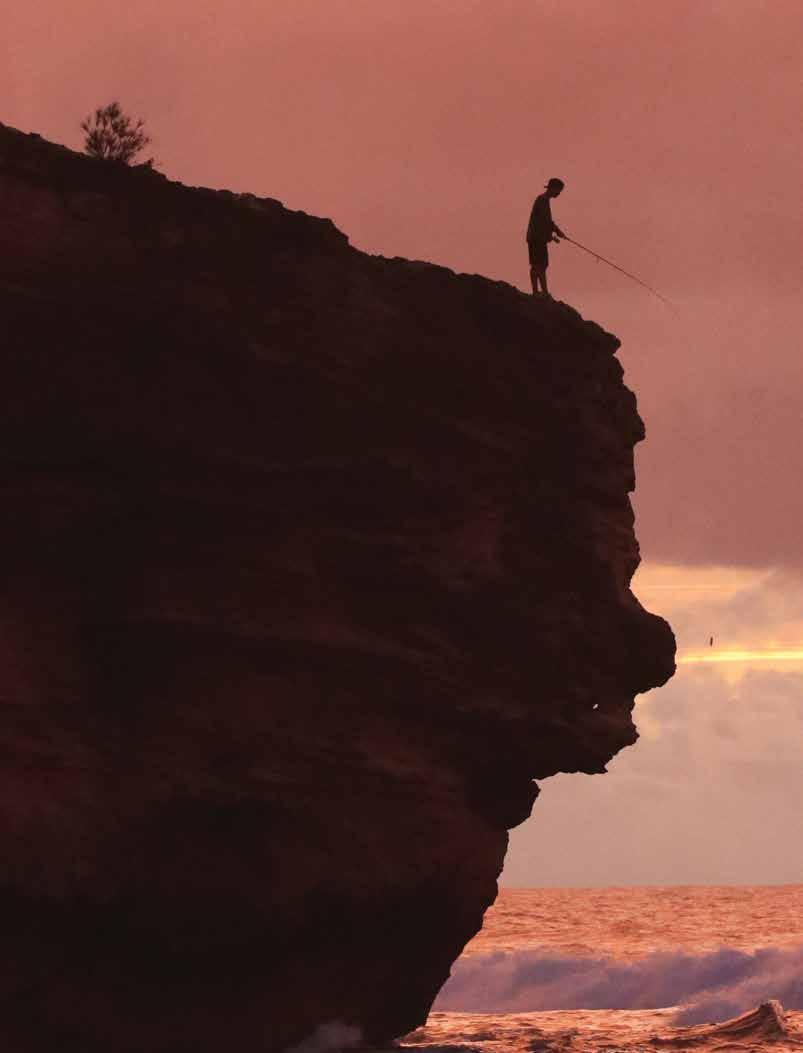

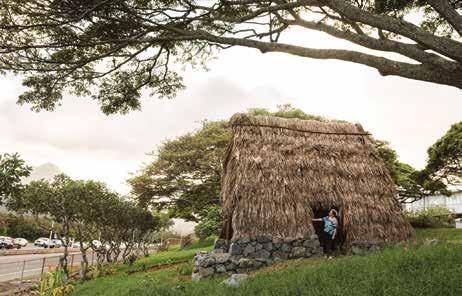
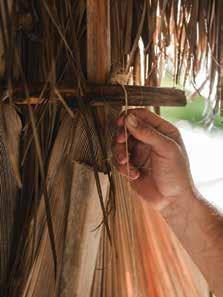
You can’t miss it as you pass Kalāheo High School on the north end of Kailua’s Kawainui Marsh: a hale hālāwai, or Hawaiian meetinghouse. It might be the only full-size traditional Hawaiian structure on a public school campus in the state. The hale is a pu‘uhonua, or “place of refuge,” for students who need a quiet break—that is, when it isn’t being used for teaching hula or other subjects.
The driving force behind the project is Tara Keanuenue Gumapac, who was an art teacher when it began and is now Kalāheo’s vice principal. Though Islandborn and raised, Gumapac learned some Hawaiian culture from her family, she says, but not enough. As an educator, she seeks to integrate Hawaiian culture into the life of every student, Native or not.
The project began early in the Covid pandemic; Gumapac was supposed to teach hula but had no suitable outdoor space, and indoors was a nonstarter. With the support of then-vice principal Resha Ramolete, another hula-dancing educator, Gumapac gathered support,
raised money and secured the approvals and permits to do something no public school had done before.
Virtually every student and staff member helped, from carrying stones donated from nearby Kapa‘a Quarry to debarking and lashing logs gifted from Paepae o He‘eia, a nonprofit that cares for nearby He‘eia fishpond. Marines from Kāne‘ohe MCBH pitched in (many Kalāheo students are from service families). A GoFundMe campaign raised more than $6,000. Keahi Piiohia, a specialist in traditional Hawaiian construction with Paepae o He‘eia, provided the mana‘o (knowledge) to build the structure.
The hale’s name, Kaleilenaokealoha, “means ‘the yellowing lei of love,’” Gumapac says. “It represents the community that came together in aloha to build the hale. Yellow refers to the mo‘o Hauwahine, the lizard-woman deity who protects Kawainui.”
Completed in April 2023 after two years of work, the hale might have an impact far beyond Hawai‘i. “In April we
will go to the National Arts Education Association annual conference in Minneapolis to show others what is possible,” Gumapac says. “A friend of mine, a Lakota Indian who also teaches art, has already been inquiring how she can integrate her culture into academics. That makes me happy.”
Student Mahina Palea, now 18, was part of the project from start to finish. “There aren’t many Hawaiian kids and few options for us to practice our culture at school. To actually go to Paepae o He‘eia, carry each log out from the kneedeep mud and learn the different lashing techniques all made me grow a greater appreciation for my culture,” says the 2023 grad, who’s danced hula since age three. “This is something not many Hawaiians nowadays have the chance to experience. It gave me confidence as a Hawaiian that I am good enough and lit a fire in me to learn more.”
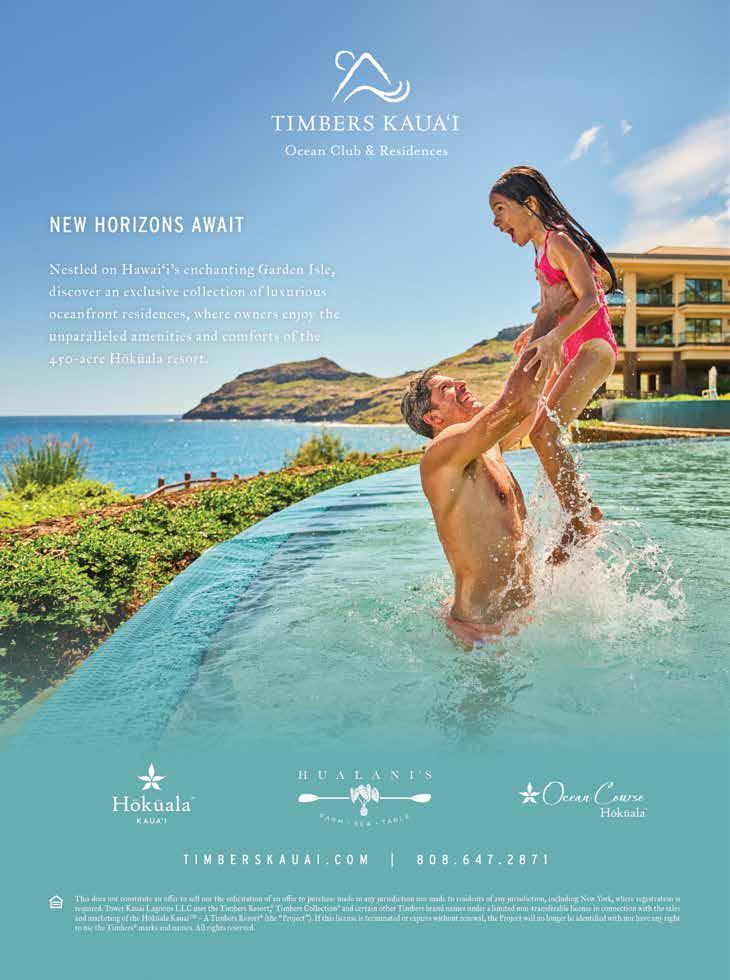 STORY BY YVONNE HUNTER
STORY BY YVONNE HUNTER

Anything you can do, she can do it in a mu‘u. Once a month, Kaua‘i fashionistas don their mu‘umu‘u and get togther for tea, lei making or, seen above, skeet shooting at Petal & Pistol. Begun by mu‘u enthusiast Jamilee Jiminez (fourth from left), the Monthly Mu‘u events are bringing mu‘u back into the mainstream.
Jamilee Jimenez is on a mission to bring back mu‘umu‘u as daily wear in Hawai‘i. She’s one of a collective of young women revitalizing vintage Island fashion, including the much beloved (and sometimes maligned) mu‘u. A year ago she decided to “go for it” by inviting women to wear their mu‘u to gatherings, from walking tours and fashion shows to line dancing and skeet shooting. “We do things people already do,” says Jimenez. “Just add mu‘u.”
A Native Hawaiian, Jimenez believes mu‘u should be celebrated, from $10 thrift-store to $1,000-plus Etsy and eBay finds. Christian missionaries introduced mu‘umu‘u, which means to “cut off” or “shorten,” in the 1820s; originally they were worn as a chemise. Over time the breezy garments came out of hiding and were designed for all occasions. Jimenez’s favorites include Tahiti imports, Pegge Hopper prints, some wow pieces by Allen Akina and contemporary designers Nake‘u Awai, Bete Mu‘u and Princess Kaiulani.
At the Monthly Mu‘u events on Kaua‘i, women show up in an array of vintage and modern mu‘u. The common denominators are creativity and whimsicality. At a recent skeet shooting meetup at Petal & Pistol, Jimenez wore a rare gardenia print by Nake‘u Awai. Petal & Pistol is a French country market, gun club and rose farm where women can cultivate their love of heirloom roses while blowing clay pigeons out of the sky with a sporting shotgun. “Only one of us had ever shot a gun before,” Jimenez laughs. “We all hit the target. We became so dangerous.”
The month after skeet it was wreath making at Melrose, a heritage property built by Honolulu architect Guy Nelson Rothwell, restored from ignominy as a gas station to the kind of café and fine goods emporium one might find along Paris’ 8th arrondissement. Passersby at Mu‘u Melrose would have been treated to a postcard moment: a dozen women in flowing mu‘u, seated at a rustic table surrounded by botanicals and chatting
over Turkish coffee, with nary a gas pump in sight.
“Hawai‘i is experiencing a mu‘umu‘u revival,” says Keane Akao, COO and godson of designer Nake‘u Awai, Jimenez’s friend and collaborator. “People who have grown up with their grandparents wearing mu‘u are embracing their heritage.”
Jimenez’s own love for aloha wear is generational. Her grandmother had a shop called Shanora in the 1970s and ’80s where garments would be handmade while women waited, and fastened with coconut-shell buttons. “My grandparents really believed you had to make what you sell,” says Jimenez. “I am always on Etsy and eBay looking for her label,” She’s reclaimed two Shanora mu‘u, an aloha shirt and one of her grandmother’s pareo designs. “Every mu‘u has a story,” she says, “and every story is an opportunity to honor our kūpuna [ancestors] and share cherished memories.”
 STORY BY YVONNE HUNTER PHOTOGRAPHY BY TIM HENNESSY
STORY BY YVONNE HUNTER PHOTOGRAPHY BY TIM HENNESSY


If you go birdwatching at Hōkūala, prepare to be inspired. Alan Silva, the resident naturalist for Timbers Resort at Hōkūala on Kaua‘i’s southeastern shore, isn’t called “the Birdman” for nothing. He spent thirty years as a biologist technician for the Hawai‘i state Division of Forestry and Wildlife, working in Midway and the Marianas as well as Hawai‘i. Now the warm and engaging biologist shares his extensive knowledge at Hōkūala.
But Silva isn’t just helping birders tick species off their life lists; he’s been growing the flock: He nurtured a group of fifteen endemic nēnē—Hawaiian geese— to a mighty gaggle of more than eight hundred. (In the 1980s, there were fewer than thirty of the Hawai‘i state birds living on all of Kaua‘i).
Binoculars and bird identification sheet in hand, Silva leads groups around the grounds of a mega resort formerly roamed by zebras, monkeys and gazelles. Today, on 16.5 acres of rewilded land that was once an eighteen-hole golf course,
you might see some sixty bird species, six of which are endemic and endangered: koloa (ducks), ae‘o (stilts), ‘alae ‘ula (mud hens), pueo (short-eared owls), ‘alae kea (gallinules) and, of course, his beloved nēnē. Silva once rescued an abandoned egg and raised the gosling, teaching it to eat and swim, he says. It slept next to his ear and talked all night. “But I had no idea I would be doing this as a career,” he says.
There are plenty of introduced species as well: zebra doves, Brazilian cardinals, nutmeg mannikins, strawberry finches. Noisy as the mynah birds are, Silva says they can have a 120-word vocabulary. Hōkūala abuts Līhu‘e Airport, and keeping the birds off the runway is a career in itself. “It’s a good job if you can get it,” Silva laughs. “A lot of your time is literally sitting in one spot watching a flock of birds.”
Silva’s work is one part of a propertywide conservation and sustainability effort at Hōkūala. Mike Yulo, a local beekeeper, maintains twenty hives on the property, pollinating Hōkūala’s organic
farm and orchard. The bees literally saved Yulo’s life. When floods swept his truck off the road near Keālia in 2018, he escaped through the window, anchoring himself with a five-pound pail of honey until he was able to pull himself out of the raging current. Today Yulo supplies the farm with jams and balms produced from the nectar of coffee, macadamia, lemon, basil, spinach, rosemary and thyme and even native ‘ōhi‘a trees growing at higher elevations in Kōke‘e State Park. With all of Kaua‘i’s abundance, it’s not uncommon for Yulo’s hives to produce four or five hundred pounds of honey.
Hōkūala’s meandering walking paths are open to the public, and Silva leads his free tours four days a week. “It’s gratifying to see both kids and adults become excited about what they’ve experienced,” Silva says, “and ignite a passion for conservation.”
 STORY BY PETER VON BUOL
COURTESY PETER GORMAN
STORY BY PETER VON BUOL
COURTESY PETER GORMAN

Several years ago while living in Boston, artist Peter Gorman decided to take a really long bicycle ride—a year-long circuit of North America that would eventually cover eleven thousand miles. Traveling under pedal power, Gorman experienced places in a new way. Cities, roads, bridges, expressways, railroad tracks and even highway intersections became places he wanted to share. He found
inspiration from various sources, like color-coded transit maps of New York City and Chicago, as well as the 1960 book The Image of the City by urban theorist Kevin Lynch.
“Lynch describes how people make mental maps of where they live,” Gorman says, “experiential representations of a place as it is perceived, as opposed to an objective representation.” Gorman started creating his own experiential
representations of the places he biked through; his quirky, often whimsical “minimalist maps” were well received by friends and family. When he returned, Gorman had enough material for Barely Maps: The Book, published in 2019.
After his epic journey, Gorman moved to Seattle, where he met and fell in love with architect AJ Taaca, who had grown up on O‘ahu. The couple moved to Hawai‘i following an extended stay during the 2018 eruption. “Things just came together for us. We had really fallen in love with Hawai‘i Island, and it became a possibility about a year later,” says Gorman, who now lives in Waikoloa Village.
Living on Hawai‘i Island meant exposure to yet another way of looking at cartography, and more maps. “In the book Kanaka Hawai‘i Cartography by Renee Pualani Louis with Moana Kahele, I learned about the Hawaiian understanding of cartography, how it combines navigation and verbal arts along with a much more metaphorical and multisensory approach,” Gorman says. “It gives a unique perspective on place.”
Naturally, Gorman started making Hawai‘i maps: stops along the defunct Hāmākua Coast railroad, Halema‘uma‘u in Kīlauea Caldera, the Kahuku Unit of Hawai‘i Volcanoes National Park and Kona cloud forests, among many others— enough for a second book, which Gorman plans to publish in the near future.
Gorman sells his work online, at the Hilo Farmers Market and the monthly Kokua Kailua village stroll on Ali‘i Drive, where he sets up in front of Hulihe‘e Palace. For Gorman, sharing his artful maps has been as rewarding as creating them. “It’s been fun making these maps and meeting the people who buy them,” he says. “I get to share what I’m learning—I can show them how the island is formed by the different volcanoes, for example. And they give me information that I can incorporate into future maps. There’s a lot of give-and-take.”
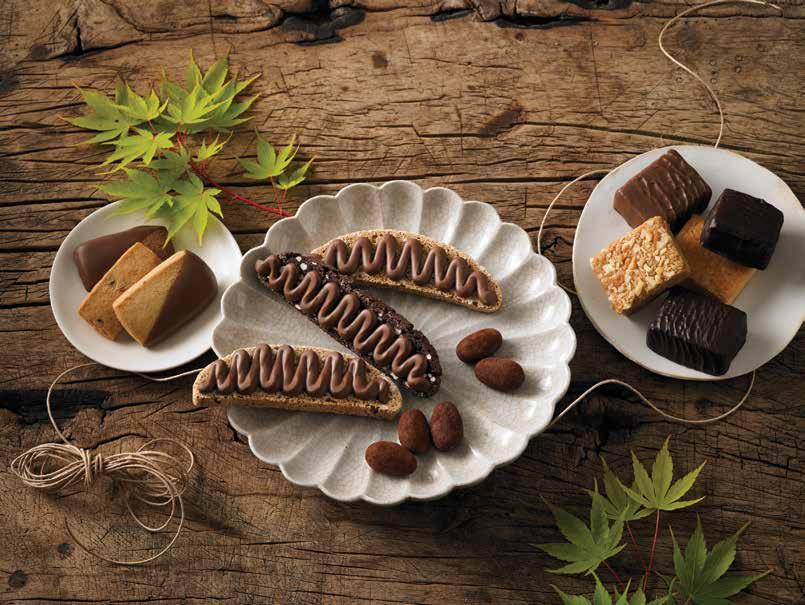

 STORY BY LESA GRIFFITH PHOTOGRAPHY BY MEGAN SPELMAN
STORY BY LESA GRIFFITH PHOTOGRAPHY BY MEGAN SPELMAN
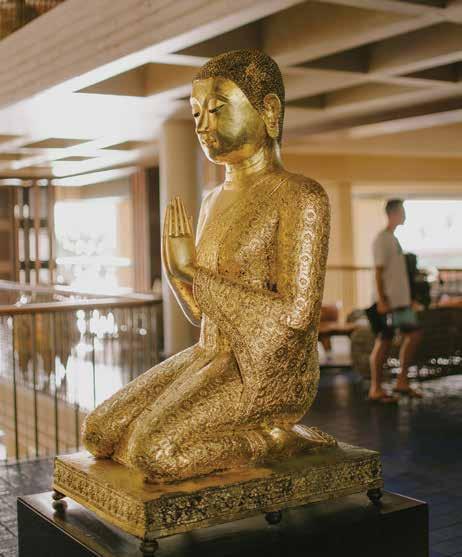
One of Hawai‘i’s most impressive art collections isn’t in a museum but a hotel: the Mauna Kea Beach Hotel, developed by Laurance S. Rockefeller, grandson of John D. Rockefeller. When it opened in 1965, MKBH was groundbreaking not only as the first hotel to be built on Hawai‘i Island’s Kohala coast, but also as one of the first US hotels with a museum-quality art collection.
Rockefeller grew up around art and was a serious collector. He appointed a team to assemble a collection of Pacific and Asian art for the resort and made some of his own selections while traveling in Asia from 1962 to 1963, including a Papua New Guinea ancestor figure and a twelfth-century granite Indian Buddha. Rockefeller also made two key commissions—
master kapa (bark cloth) maker Malia Solomon created fourteen pieces, and quilter Meali‘i Kalama, with the help of Kawaiaha‘o Church parishioners, sewed thirty quilts—highlights of the collection. The hotel opened with a collection of more than 1,600 works.
Rockefeller envisioned the art as an integral part of the hotel, displayed in public, open-air spaces. But more than fifty years of salt air and sunlight have taken a toll. In 2017 the hotel reached out to Bishop Museum for help. The steward of Hawaiian cultural material took on the conservation of the kapa, which dates back earlier than the 1960s. Solomon had acquired hundred-yearold sheets of kapa moe, or bedding, and decorated them using traditional ‘ohe kāpala (hand-carved bamboo stamps).
The Bishop team also mapped out a re-display project, creating custom, protective frames and designing new faux-basalt plinths fabricated by a California-based company specializing in set design. “We used gaskets and special materials to make [frames and vitrines that are] economically viable and effective from a conservation standpoint,” says Brad Evans, Bishop Museum’s director of exhibits. Now most of the pieces are back on view, still accessible to guests, but sealed off from the ravages of UV rays and bugs. Quilts and statues have also been restored, and moving forward, MKBH is working with Waimeabased Island Eclectic, the art restoration firm of Hawai‘i artists Margo Ray and Scott Yoell. Next up for some TLC are Papua New Guinea masks, Japanese tansu (cabinets) and more statues.
“We don’t take this responsibility lightly,” says MKBH manager Kansas Henderson, who oversees the $1 million project, which also includes digitizing the collection and creating an app. “We’re bringing the collection into the next century. It has been an honor to keep Laurance Rockefeller’s vision alive.”























The Māhā‘ulepū Coastal Heritage Trail on Kaua‘i begins at Shipwreck Beach (seen above left) and climbs the Makawehi Cliffs (seen on pages 18-19). The route passes Makauwahi Cave Reserve, one of the richest fossil sites in the Islands. Above right, riders from CJM Country Stables tour Māhā‘ulepū Beach.
Walking the Māhā‘ulepū Coastal Heritage Trail on Kaua‘i’s south shore is like traveling back in time. Starting at Shipwreck Beach, you ascend the Makawehi Cliffs—125,000year-old lithified sand dunes—following an unmarked but easy-to-follow trail. At the top you’re greeted by an ancient landscape sculpted by wind, surf, salt spray and rainfall.
The trail continues to the Makauwahi Cave Reserve, Hawai‘i’s largest limestone cave and one of the richest fossil sites in the Islands, revealing flora and fauna from as far back as 6,500 years ago, including over forty bird species (nearly half of them extinct) and evidence of coastal plants thought to live only in upland areas. The cave trail is lined with native flora—more than fifty species have been planted throughout the reserve’s dry forest—one of the rarest habitat types in the Islands.
Across a stream just beyond the cave, Māhā‘ulepū Beach is a two-mile-long stretch of wild, remote coastline, magical in its isolation. Māhā‘ulepū means “falling together”; the beach is named for a battle that took place here in the fourteenth century, when Kaua‘i repelled invaders from Hawai‘i Island. The beach goes from Punahoa Point, made of dunes formed about 350,000 years ago, to Pā‘o‘o Point. Here on the whitesand beaches, you might see volunteers from Mālama Māhā‘ulepū maintaining the native plantings and restoring ‘opihi (limpet snail) communities in the rocky tidepools. The nonprofit is dedicated to preserving this last stretch of accessible undeveloped coastline on Kaua‘i.
Communities around the state are working to preserve more land in the face of development pressures, but few of these areas are as unique—and accessible—as Māhā‘ulepū. Apart from Ni‘ihau, Kaua‘i is geologically the
oldest of the main Hawaiian Islands, and richest in paleoecology. “From the peak of Mount Hā‘upu to the limestone headlands, beaches, Māhā‘ulepū is a living museum where we can be immersed in the five-million-year sweep of natural and human history,” says Beryl Blaich, board president of Mālama Māhā‘ulepū. “As Kōloa and Po‘ipū have urbanized since the 1970s, protecting undeveloped Māhā‘ulepū is ever more important. This storied place is critically important as a rest stop on the superhighway of modern life.”


Nestled at the doorstep of Diamond Head, Kuilei Place offers the perfect blend of relaxed living and city vibrance. This residential community in the heart of Honolulu brings you closer to the very best of the island.

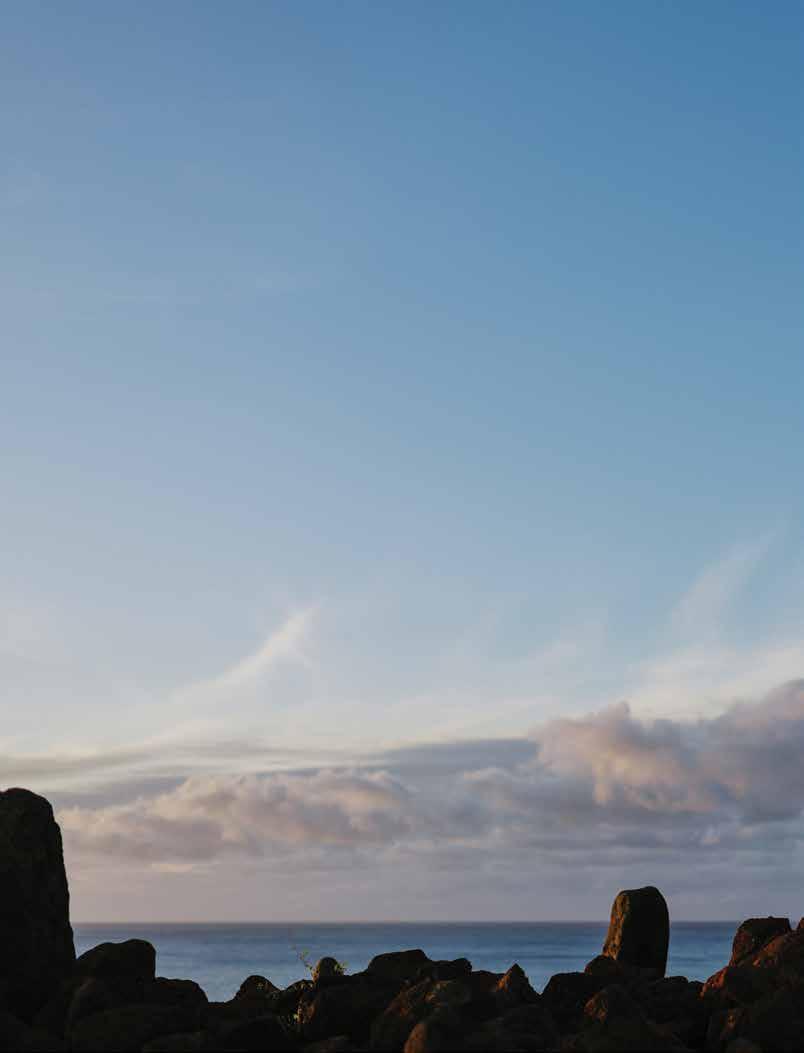



For centuries, Polynesian navigators trained at Mahukona. Now a new generation is finding the way.

People in Hawai‘i “talk story.”
Funny story. Chicken-skin story. Mythical story. The pidgin phrase, though, hardly captures the profound knowledge and kuleana (responsibility) the stories of Mahukona carry. Here, people hold story, bridging generations and epic distances, preserving the past while navigating toward the future—one shaped by stewardship, sustainability and collective action. For the families
rooted in Mahukona, on Hawai‘i Island’s parched Kohala coast, mālama ‘āina (caring for the land) is not merely a phrase; it’s a way of life.
The stories told in Mahukona (literally, “leeward vapor”) are potent. Guided by the stars, sun and moon, by ocean currents and flight paths of seabirds, ancient voyagers sailed thousands of miles from throughout Polynesia to Ko‘a Heiau Holomoana,
the navigational temple located here. Though long-distance voyaging between Hawai‘i and the rest of Polynesia had ceased before Western contact, the descendants of Mahukona preserved stories of a tradition that had been mostly lost in Hawai‘i by the time Europeans arrived in the eighteenth century. Or almost lost: In the early 1970s a cultural revival known as the Hawaiian Renaissance washed through

For centuries, families descended from Hawai‘i’s last line of ancient voyagers have stewarded Ko‘a Heiau Holomoana, the navigational heiau (temple) at Mahukona. “Today, canoes pursuing the art of noninstrumental navigation all stop here to honor this heiau,” says master navigator Chadd ‘Ōnohi Paishon, seen at the heiau above and on pages 34–35. On page 36, lineal descendant Kama‘alea Emeliano-Solomon plays with his children Leo and Kauanani in the tidepools of Mahukona.
the Islands. Hawaiians revived ‘ōlelo Hawai‘i (Hawaiian language), hula and oli (chants), traditional farming and land management—and voyaging. A handful of visionaries set out to design, build and sail a wa‘a kaulua (traditional double-hulled voyaging canoe) to prove that their Polynesian ancestors crossed the Pacific intentionally, guided only by nature. Naysayers abounded. Academics dissented. But the visionaries persevered, founding the Polynesian Voyaging Society in 1973 to save this nearly extinct cultural practice. When the canoe they built, Hōkūle‘a, sailed from Hawai‘i to Tahiti in 1976 without the use of modern technology, it proved that wayfinding worked and carried that wave of cultural pride to the rest of Polynesia.
But the kahu of Ko‘a Heiau Holomoana, the lineal descendants responsible for its safekeeping, already knew it worked: Oral histories passed down through generations said so. “The navigational heiau was always in my grandma Marie Solomon’s stories,
her mo‘olelo,” says Hinano Lewis, eldest of the Solomon ‘ohana, who have stewarded the heiau for six generations; Lewis herself is a lineal descendant from the Paliku line of navigators, Hawai‘i’s last known voyaging apprentices. “Stories about Ko‘a Heiau Holomoana started coming out in the 1980s, when this whole area was going to be developed into resorts, including Mahukona. That’s when Grandma Marie, Grandpa Sonny and the rest of my family got really involved protecting this place and its sacred sites.”
In ancient times, children were chosen at birth to learn the art of wayfinding. So it was with the last male from the Paliku line of navigators, who began his education at Ko‘a Heiau Holomoana, sometime around first Western contact. His teachers, kūpuna (elders) who safeguarded the heiau, taught their charges how to navigate, but also to honor the land, ocean and traditions so that they may be preserved for future generations. Becoming a
wayfinder is no easy task, and the young navigator had to pass many tests before earning the right to voyage. It’s said that he got tangled in the mess of wind and currents crossing the infamously turbulent ‘Alenuihāhā Channel on the way to Kaho‘olawe and failed the test. Instead, his descendants joke, he took up Kohala’s second-best profession: sweet potato farming.
Passed down by Auntie Marie’s great-great-grandfather, likely sometime in the mid-1800s, the story of the last navigator was held kapu (secret), hidden from missionaries and sugar bosses, from World War II strategists who used the bluff as a lookout, from developers with dream schemes of golf courses and condominiums running along the coast. “For Hawaiians, certain places are very sacred,” says Kealoha Sugiyama, born and raised in Mahukona back in its postcontact heyday as a sugar port. “If they felt the time and place was not right for the heiau to be exposed, they wouldn’t say anything.”


And they didn’t, until that magic moment when circumstances and community activism converged to help save both traditional navigation and the cultural practices linked to Mahukona. “Things don’t happen when you want them to happen. It’s never up to us,” says master navigator, canoe builder and original Hōkūle‘a crew member Shorty Bertelmann. “It takes patience to wait for that window. It’s a feeling or spirit, that collective coming together when everything is in place—that’s when these things are revealed.”
By the time artist-historian Herb Kawainui Kāne drafted the plans for Hōkūle‘a from a scattering of petroglyphs and a few eighteenth- and nineteenthcentury drawings, the knowledge of
voyaging canoe design and building had died out in Hawai‘i. Once Hōkūle‘a was built, no one quite knew how to sail it. Kāne, along with a handful of other, nowvenerated Hawaiian voyagers, including Clay and Shorty Bertelmann, Nainoa Thompson, Chadd Paishon and others, were hell-bent on learning.
“We looked all over the world for someone with that traditional knowledge—how to use the stars and ocean and elements of land and universe to navigate. In our generation there was no one with that knowledge,” says Bertelmann. Then one day, an unimposing man from Satawal, Micronesia, walked into a room of would-be voyagers. Chalk it up to coincidence or, in the Hawaiian
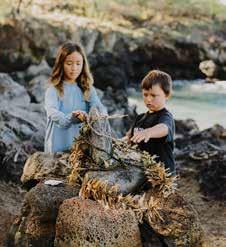

BOTTOM / One of Mahukona’s trails, formerly a railway, is now protected by a recent land purchase that will preserve the area for future generations.
AT LEFT / Shae Kamaka‘ala of Hawai‘i Land Trust plants an ‘ulu (breadfruit) tree as part of the restoration effort at Mahukona.
worldview, the intercession of unseen ancestors. Regardless, the time was right: Mau Piailug, an old-school master navigator, crossed paths with the Hōkūle‘a ‘ohana just as they were struggling to reinvent noninstrumental navigation. “Mau was afraid,” recalls Bertelmann, who was at that first meeting. “He saw the tradition dying out on his island and wanted that knowledge to be passed on.” Which he did: After Hōkūle‘a’s successful voyage to Tahiti legitimized traditional wayfinding, Papa Mau, as he is affectionately known, continued teaching Hawaiian voyagers, with five achieving the status of pwo, master navigators.
Two of Mau’s students, Shorty and his late brother Clay Bertelmann, went
TOP / Loli‘i Barron (left) and Nāke‘u Hudgins, the next generation of stewards and voyagers, freshen up lei offerings at Mahukona.

“Preserving the traditional ways is about the strength of our ancestors, the strength of our origins and the strength of our children,” says canoe builder and navigator Shorty Bertelmann. “That was always the promise.” Today, that promise is kept by Kohala residents like Emeliano-Solomon and his son Leo, seen above.
on to establish Nā Kālai Wa‘a (canoe builders), an educational nonprofit and navigation academy, in 1993 to perpetuate voyaging traditions for generations to come. Shortly thereafter they began constructing Makali‘i, a traditional double-hulled voyaging canoe, to serve as a floating classroom.
This hunger for ancestral knowledge breathed new life into Mahukona. And the Solomon family was ready: All this time, Auntie Marie and Uncle Sonny had continued passing down stories of the heiau while hosting visits and school programs; their daughter, Patti Ann Solomon, the first woman navigator from the Paliku line, began lobbying for a preservation plan. Together, they introduced Ko‘a Heiau Holomoana to Papa Mau, the canoe builders and Nā Kālai Wa‘a. Papa Mau shed light on the mystery of how the heiau worked, how it pointed the way to Tahiti, the ancestral home of Hawaiian voyagers. The heiau, the hallowed land on which it sits and the voyaging tradition it guides, were back online.
From all accounts, Auntie Patti— Mahukona caretaker and voyager—was larger than life, a funny, street-smart spitfire who dedicated her life to preserving Mahukona and nurturing
the traditions around the heiau. “Auntie Patti’s role, her work protecting this place, was very big,” says Keone Emeliano, ‘āina steward and educator for Hawai‘i Land Trust (HILT). “I am so grateful for her and her ‘ohana. If not for her, I wouldn’t be here, and the future of Mahukona would be a big question mark.”
“Auntie Patti’s goal was to protect Mahukona and the importance it has for the Kohala way of life,” Lewis recalls of her mother’s mission. With a voyager’s courage and tenacity, Auntie Patti worked tirelessly to preserve the land. But purchasing 642 acres, including some of Hawai‘i’s most desirable coastal real estate, spanning six ahupua‘a (traditional land divisions) seemed out of the question. For eight years in a row, the Kohala community presented an offer financed by the Hawai‘i County Public Access, Open Space and Natural Resources Preservation fund (2 percent of the county’s property taxes go to this fund) but failed to convince private developers to sell. Despite their determination, the purchase of these ancestral lands, containing one of Hawai‘i’s oldest and most active heiau, was in the doldrums.
Enter HILT, a statewide nonprofit dedicated to protecting and stewarding lands that sustain Hawai‘i. Shae Kamaka‘ala, director of ‘āina protection for HILT, was tasked in 2020 to “try and figure out why this place is so important to the community.” Initial inquiries led her to the canoe Makali‘i and Nā Kālai Wa‘a, which led her to the Solomons. “The Solomon ‘ohana provided a sense of clarity and hope for the path forward,” Kamaka‘ala recalls. “I believe that by passing down these ancient stories from generation to generation and waiting for the right time to share them, the Solomons contributed to Mahukona’s accumulated mana—an energy that never dissipates. That’s why we can feel their presence today.”
Nā Kālai Wa‘a, families and descendants were invited to Mahukona ‘Ohana Day to help HILT better understand why this place and the practices it supports are so critical to preserve. “There are families here that continue to pass down mo‘olelo within their ‘ohana. They speak of watching [King] Kamehameha grow up. In Kohala, people speak of the
beautiful and deep respect they have for this place,” says Kamaka‘ala. “So it’s really about listening and staying true to the place and the people who hold relationships to the seen and unseen, to birds and trees, to practices like navigation.” HILT sought permission from the families of Mahukona to work toward a land purchase that honors those relationships. Forces slipped into place, ushering in a new era in Hawaiian stewardship and voyaging.
HILT, in partnership with Nā Kālai Wa‘a, federal, state and county agencies, and the larger Mahukona community, undertook the monumental task of mapping the 642 acres slated for preservation, identifying hundreds of sacred sites within its boundaries and documenting the cultural practices tied to the land. Surveys for US Fish and Wildlife grants were conducted to identify endangered species and protect their habitat. Kohala families weighed in on daily use of the land, from fishing practices to learning to swim. “This is every day, this is our life. Mahukona is where we come when we need guidance or want to visit with those who came before us,” says Kailin Kim, 2009 Hōkūle‘a crew member, the youngest in its history at 17. “We feel and see them in all things. That’s why Mahukona is so special for our families. By sharing this space, we are connected to all the generations that came before, our kūpuna, their babies and their babies,” she says, bouncing 1-year-old Kekeha on her hip.
HILT mounted a campaign to raise $20 million, coupled with a massive community organizing effort to secure funding and argue for protecting Mahukona. They found endangered endemic species and sacred sites. They gained new knowledge, including an ingenious ancient water catchment system using concave rocks. The kūpuna stories living with Kohala families were documented. It worked, the sellers climbed aboard and the community’s hard-fought and long-awaited goal for the Mahukona Navigational and Ecological Complex became a reality in December 2023.
Future plans are lofty, and the work ahead will be hard, but Auntie
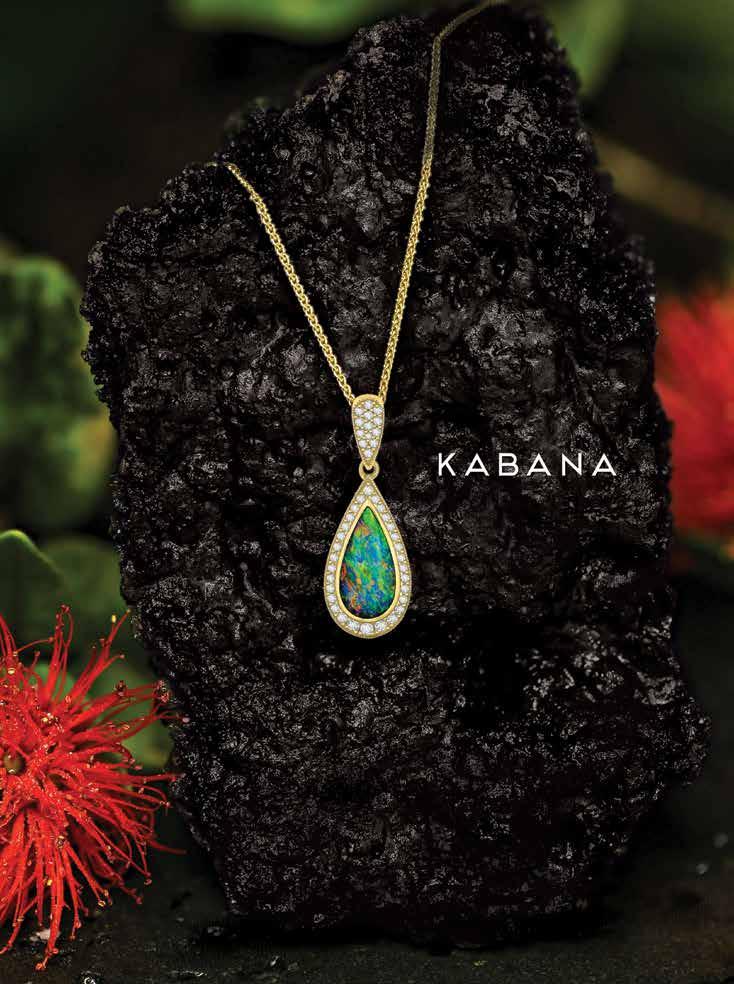


Ask anyone born and raised in Kohala where they learned to swim, and the answer is inevitably Mahukona. “The first time Kekeha entered the ocean was here. She was eight weeks old,” says Kailin Kim (right), seen here with Kamaka‘ala watching their children
the
The land purchase, says Kamaka‘ala, “is a beautiful and rare opportunity to protect the heart, soul and spirit of this place.”
Patti, who passed away in 2019, leaving a hole in Kohala’s heart, wouldn’t have had it any other way. Habitat restoration for at least thirteen endangered, threatened or rare endemic species, including the ‘ōpe‘ape‘a (Hawaiian hoary bat), the ‘ua‘u (Hawaiian petrel) and ‘iliahi aloe (coastal sandalwood) is already underway. “Periodically, youth from our local basketball program clean out kiawe [mesquite] trees and invasive grasses, and every week high school students do volunteer stewardship work,” says Emeliano. “In 2024 we’ll have volunteer days on the third Sunday of every month so people can learn about and help restore Mahukona.” The land purchase also contributes to four miles of contiguous protected coastline between Lapakahi State Historical Park and Kapa‘a Beach Park.
For the voyaging ‘ohana, the land purchase and new complex mean the heiau and the wayfinding traditions it
supports will be preserved. “Ko‘a Heiau Holomoana was a school of navigation in the past, and it continues to be a school today,” says pwo navigator and executive director of Nā Kālai Wa‘a, Chadd Paishon. “We honor our Mahukona kūpuna by studying and perpetuating this knowledge that has been within our culture for generations.” In addition to teaching navigation aboard Makali‘i, Nā Kālai Wa‘a has programs for traditional canoe building and restoration; reviving and perpetuating Native food systems; and ocean stewardship.
The fragility of Mahukona and the cultural significance of the heiau require that visitors respect the site and tread gently—if at all. “The heiau is very sacred. You have to have a meaningful reason to go,” says Emeliano. “Even living here all my life, I didn’t go there because I had no reason to be there.” Indeed, in his capacity as a HILT steward, Emeliano has visited only four times.
“Keeping our culture alive, thriving and strong by passing down these cherished stories and traditions— that’s the real opportunity here,” says Kamaka‘ala. Expanded educational programming for visitors is a possibility in the future, as long as it doesn’t interfere with Mahukona’s living cultural practices. “It’s only a little spot on the coastline, but the conservation purchase means we can manage and protect it and continue to learn,” says Shorty Bertelmann. “I know the ancestors are going to be happy.” hh
romp in surf.
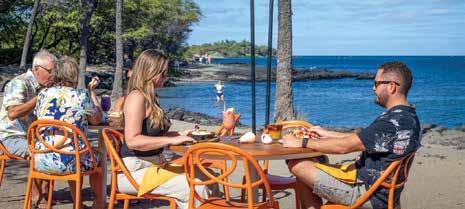
Savor Island style culinary creations from our collection of signature dishes, including fresh fish from our local waters. Every day our chefs go crazy with menu favorite Hook, Line and Sinker specials, delivering an ocean of flavors to your plate. Or try our signature sliced teriyaki steak, and don’t forget to sip and savor hand crafted cocktails to the sounds of live music.









Hawai‘i’s endemic lobeliads represent one of the most astonishing examples of plant evolution in the world. What will it take to save them?

Experience our Hawaii
Whether you want to fly high above the clouds, hike to a waterfall or snorkel with our sea life, adventure awaits.





Hawaii’s premier live music venue Year-round entertainment
Daily live island music paired with handcrafted beers and cuisine
Home of Duke’s on Sunday with the incomparable Henry Kapono 4–6pm
Come be here.
Discover our experiences and find the places where Hawai‘i’s most renowned artists come out to play. Scan

There’s no free ride to Ka‘ala,” Susan Ching likes to tell the passengers in her back seat, whether it’s her conservation colleagues, a reporter or her own two children. What she means is that everyone has to help out. She drives to the top of O‘ahu’s highest peak every six weeks to monitor a different group of keiki (children—in this case, young plants). Volunteers have outplanted 2,500 Lobelia oahuensis seedlings, to date the largest statewide effort to replenish the population of a rare plant. This record-breaking undertaking is the critically endangered species’ best hope for survival. Fewer than twenty plants had been thought to exist in the wild before the project to restore Ka‘ala’s slopes began.
There are so many dizzying turns on the one-lane road to the top of the mountain that it’s impossible not to stare out the window and watch the surrounding foliage transition from eucalyptus, grass and other introduced plants to a greener landscape of gnarled, moss-covered ‘ōhi‘a lehua trees and impressive ferns. Above four thousand feet, we enter an O‘ahu that existed before us. But even in the absence of nonnative and invasive plants, other humanintroduced invasives threaten the lobelia keiki. Left unchecked, slugs and vermin would make quick work of the plants’ long, leafless stems.
Ching, the O‘ahu botanist for the Department of Land and Natural Resources (DLNR), and Kobey Togikawa, the O‘ahu technician for the Plant Extinction Prevention Program (PEPP), have come up the mountain to replace the temporary defenses against these critters. They’re checking the air canisters of rat traps and scattering iron phosphate pellets, which kill slugs without harming other wildlife. According to Togikawa’s calculations, most of the keiki on this part of the mountain have survived since they were outplanted from a greenhouse a year ago. By contrast, fewer than a tenth of the lobelias planted in less accessible areas have persisted.
Even here, though, not all the keiki have thrived. Crouching to peer at a shriveled, ankle-high lobelia, its once-defiant crown of green leaves gone, Ching points out a handful of
seed pods adorning the upper part of the stem. This species, she explains, flowers once and dies. Normally, the plants would grow for decades, building up enough energy to eventually funnel into a spectacular display of hundreds of periwinkle-colored flowers, which give way to pods containing millions of tiny seeds. This lobelia bloomed prematurely, possibly because of the stress of its transition from a controlled greenhouse to the harsh realities of the wild. Of course, plants die for all sorts of reasons. Predation and the inconsistencies of a changing climate play a role, though the way these effects are distributed can be random. Still, with plants as rare as these, chance is often the difference between survival and extinction.
Ching gently admonishes the desiccated plant: “What are you doing? You’re too little,” she says. “You’re not going to contribute to the population— you’re going to maybe have three seeds in there.” Then she imagines the plant’s response: “But they’re like, ‘We couldn’t hold it in!’”
Hawai‘i’s lobeliads (a group that includes Lobelia and its five sister genera) tell a remarkable tale of adaptation. Within their diversity is a wealth of stories—geological ones, about the formation of the Hawaiian archipelago; evolutionary ones, about the animals they evolved defenses against and the ones they attracted to reproduce; and cultural ones, about the practices of Native Hawaiians. These stories are at risk of disappearing because of immediate threats—more species of Hawai‘i lobeliads are threatened or endangered than any other plant or animal lineage. As these rare, striking plants decline, botanists are working against the clock toward both a concrete and an intangible goal: to increase the populations of these plants in the wild and simultaneously preserve the stories woven into their roots, stems, leaves, flowers and fruit.
As with any rare plant, saving the lobeliads means saving humans from our own worst tendencies—of exploiting land and, alternately, of suffocating what we have by holding it too tightly. “Overloving,” as Ching calls it—seeking them out, visiting to take pictures, etc.—can be just as dangerous as not loving enough.

OPENING IMAGE / A critically endangered Cyanea grimesiana, one of the rarest plants in the world. The endemic lobelia has been extinct in the wild since 2004; the Plant Extinction Prevention Program (PEPP) is working to bring it and other Hawai‘i lobeliads back from the brink.
ABOVE / Botanist Susan Ching hikes to check on lobelias transplanted to native forest areas on O‘ahu’s Mount Ka‘ala.
It’s said that all of Hawai‘i’s native plants came to the Islands via one of three routes: wind, wave or wing. The lobeliads are no exception. Approximately thirteen million years ago, eons before the formation of any of the main islands we know today as Hawai‘i, wind-borne seeds from just one species of ancestral lobeliad likely landed on a now-underwater island near Gardner Pinnacles. Once a high island itself, this islet existed more than 550 miles northwest of where Kaua‘i is today, but millions of years before any of the eight main islands of modern-day Hawai‘i emerged. Once established, the plants evolved, changed and adapted. Today, scientists recognize at least 142 distinct species of Hawai‘i lobeliad, and a handful of new species are discovered or reclassified each year.
The lobeliads are the most successful example of “adaptive radiation” known in the world. It’s a phenomenon in which a single species evolves into many different ones after it colonizes new geographic and ecological areas. Islands, with their remoteness, variety and abundance, are hot spots for this kind of sped-up



adaptation—the Galápagos, with about a dozen unique species of both tortoises and finches, is the textbook example of adaptive radiation, literally: Charles Darwin formulated his theory of natural selection partly by observing Galápagos finches, and there were a mere thirteen species when the HMS Beagle visited in 1835. But that’s nothing compared with Hawai‘i lobeliads, a flashy exception to the classical theory of evolution as a slow, incremental force. Indeed, the plants had such an impact on Hawai‘i’s biodiversity that they catalyzed a secondary radiation among the insects and birds that pollinated them.
Three hundred thousand years after its arrival to the Islands—a blink of an eye in evolutionary time—that ancestor lobeliad spread throughout the existing islets and atolls, and two groups emerged. One grew solely in moist, high-elevation forests, while the other inhabited swamps, grasslands and eventually cliffs and alpine bogs. Just three million years after their introduction, the lobeliads had split into the six genera, ones that still exist: Lobelia, Cyanea, Clermontia, Trematolobelia, Delissea and Brighamia. It’s not too difficult to spot some of these plants if you know what you’re looking for: long, bare stems that lead to a shock of leaves, giving lobeliads a distinctly prehistoric or Dr. Seussian appearance. Within each genus, shared traits can be even odder. Many species of Cyanea have spikes adorning their bases and snaking partway up their stems—likely a defensive structure, but a perplexing one, as the plants would have had few natural predators. Scientists hypothesize that the spikes protected Cyanea from the moa nalo (lost fowl), an extinct, toddler-size,
flightless bird; the spikes rise only as high as the approximate height of the birds. Brighamia, on the other hand, baffled early botanists so much that the namesake of one of the genus’ two species, Joseph Rock, wrote that “it certainly is a most grotesque plant” and agreed with an earlier scientist’s assessment that it looked like a cabbage impaled on a fence post.
When Kaua‘i emerged approximately five million years ago, lobeliads were transported by wind, wave and wing to the new habitats, continuing to evolve based on the island’s unique pressures and resources. It’s barely hyperbolic to say that anywhere a new environmental region arose, so did endemic lobeliads. While the ancestor lobeliad grew dry pods that relied on the wind to scatter seeds, lobeliad descendants began to depend on birds and occasionally moths for dispersal. Around the time of Kaua‘i’s emergence, Hawaiian honeycreepers diverged from ancestral birds into their own lineage, developing their distinctive curved beaks that fit perfectly into the tubular flowers of lobeliads. Anything that impacts one affects the other, and the misfortunes of the lobeliads and honeycreepers today are inseparable.
When the Polynesians first arrived, they too must have been taken in by these strange and wonderful plants. Some may have felt familiar, as endemic lobeliads are found across the southern Pacific islands. There are multiple Hawaiian terms for lobeliads: Hāhā, the Hawaiian word for Cyanea, makes up part of the phrase “hāhā ‘ai a ka manu”—hāhā, eaten by the birds. That’s the refrain of a song taught to famed Hawaiian musician Eddie Kamae by kupuna (elder) William Kuwalu. Kuwalu recalled that when he was young, his father and uncle took him hunting in the cloud forest of Kaua‘i. “We went to this tree where the birds—only Hawaiian birds, like the ‘ō‘ō and the ‘i‘iwi—were eating this sweet fruit,” Kuwalu said in a documentary film. Asked about the tree’s identity, his uncle responded in song:
Sweet hāhā ‘ai a ka manu
O ka nani Wai‘ale‘ale i ka ‘iu
Hanohano e ho‘ohie a ‘e nei
E ki‘i nō wau e kui a lei (Sweet hāhā eaten by the birds
Of beautiful Wai‘ale‘ale so lofty In whose glory we delight I’ll gather and string a lei)
Another lobeliad, Lobelia hypoleuca, has at least four Hawaiian names. One, ‘ōpelu, directly compares the leaf’s silvery undersides to the mackerel scad, a fish known by the same Hawaiian name. Mo‘owahie is less glamorous: It means “fragments of burnable wood,” or kindling. It’s not much of a stretch to extrapolate that the meanings of these terms, and the existence of Hawaiian terms at all, are a metric of historical abundance. Even today, lobelias in untrammeled areas like Oloku‘i peak on Moloka‘i make up over a fifth of the forest canopy, says Sam ‘Ohu Gon III, the senior scientist and cultural adviser for The Nature Conservancy of Hawai‘i and Palmyra. “There the abundance of lobelioids is amazing,” he says.
Otherwise, it’s rare to see lobeliad groves, due to introduced pests and weeds. Though some species can produce millions of seeds per plant, ungulates like pigs and goats plow up the understory, while mice, rats and slugs nibble away at young plants. Elsewhere, invasive plants like Brazilian peppertree and Himalayan ginger outcompete native growth and increase the odds of landslides. Climate change threatens lobeliads, subtly at first. Cool cloud forests are not so rainy anymore—on the day we drove up Ka‘ala, there were no clouds to block the sun from drying up the muddy earth.
On Ka‘ala direct human impacts are palpable, too. As a pair of hikers passed by one of the L. oahuensis outplantings, Ching quizzed them on where they were from (Poland) and how they’d heard about the hike (Instagram). Togikawa hung back, bashful, but Ching was vindicated. She’d downloaded heat maps from Strava, a popular tracking app for running and hiking, as proof that people are hiking up the mountain and straying off the trail to see rare plants they’ve viewed on social media. Not all abide by the hiking mantra, “Leave no trace.” “We have found people who’ve gone to the bathroom right in our outplanting,” Ching says. “So gross.”
Publicizing conservation efforts can have these sorts of unintended consequences. When DLNR put


When Honolulu Beerworks in Kaka‘ako unveiled a partnership with the Hawai‘i Snail Extinction Prevention Program, the beer sold out in one day and attracted the highest number of visitors to the brewery since the start of the pandemic. With its lobelia-themed beer, produced in partnership with PEPP and O‘ahu’s Lyon Arboretum, the brewery nearly doubled production to ensure there would be plenty of Hāhā-loha to go around.
out a press release about the 2,500 outplantings, eagle-eyed viewers identified one of the sites from a picture and flocked to the plants. Tragically, overloving killed some of them.
“When we returned, they had stepped on all the seedlings,” Ching says. “It’s heartbreaking.”
Conservationists are working to educate the public without contributing to overloving. On a recent morning, Ching, Togikawa and botanists from PEPP and O‘ahu’s Lyon Arboretum gathered at a local brewery. Based on the success of a collaboration with conservationists of endemic kāhuli tree snails, Honolulu Beerworks in Kaka‘ako offered to create a themed beer for lobeliads. Staff marveled at model cans displaying the design of the Hāhā-loha beer (a portmanteau of hāhā and aloha), featuring illustrations of endemic Cyanea from each of the main islands. There were flowers ranging from crème to deep purple belonging to Cyanea rivularis from Kaua‘i, Cyanea konahuanuiensis from O‘ahu, Cyanea procera from
Moloka‘i, Cyanea horrida from Maui and Cyanea shipmanii from Hawai‘i Island. It didn’t escape notice that some of the flowering lobeliads looked like a cross between an orchid and the Demogorgon from Stranger Things.
In the spirit of a botanist who claimed the nectar of some lobeliads, including L. oahuensis, tasted like grape soda, brewers planned to create a sour beer with lemongrass, calamansi and Concord grape jelly. Honolulu Beerworks put PEPP and Lyon staff to work slicing citrus and crushing lemongrass, which they added to the grain and hops circulating in one of the brewery’s large vats. Each of the scientists took turns pouring in ingredients and stirring with a long wooden paddle. The mixture flowed into an even larger metal tankard to ferment, and in less than a week, the beer filled seven kegs and one hundred cases of cans, each illustrated with a composite image of four endemic lobeliads.
Despite grim conversation about recent invasive species sightings and the slow death of the lone surviving plant in a species, the mood was bright.
It reminded me of something Ching had said atop Ka‘ala about how she’s able to stay optimistic in the face of small disappointments—like seeing the damage to an outplanting site—and big ones: that despite her best efforts, she is witness to the extinction of species. “I can get really depressed about it, but I would say I come to work more positive than anything,” she says, “because we feel like we’re really making a difference, like every little bit counts.”
For the next month, Honolulu Beerworks will list PEPP and Lyon as partners on their website, and visitors to the brewpub will be able to donate directly to conservation efforts. Honolulu Beerworks co-owner Geoff Seideman says that the partnership with local businesses and nonprofits is a nobrainer. “We make good beer and we do good things,” he says.
The partners hope that their efforts can help people reconnect with these remarkable plants while also protecting them. If their hunch is right, they’ll be able to conserve the sweet hāhā and other lobeliads, preserving their stories for the future. hh

The long overdue O‘ahu Historic Preservation Commission is determined to protect the island’s historic treasures







For many, traveling long and far away is part of the ideal vacation—it’s about getting away. Not so for Kēhaunani Abad. Her father, Fred Keakaokalani Cachola, made recreational time all about understanding O‘ahu, where Abad’s family has lived for generations. “Growing up, he took me to a lot of places he was trying to protect,” she says, recalling her father’s work as a cultural advocate. “It was just a part of what we would do on a Saturday or on vacations.”
Their journeys around O‘ahu and Hawai‘i Island took them to heiau (temples), fishing shrines, hōlua (sled) slides, burial platforms, trails, petroglyphs and house sites. Abad’s father emphasized the importance of understanding archaeology and architecture, culture and history, particularly before contact with Western explorers. “I saw his frustration trying to protect places that shouldn’t have been that hard to protect,” she says.
At the time, there wasn’t a local government office with which Abad’s father could work to preserve the important places of O‘ahu. “We were the only county in the state of Hawai‘i that didn’t have a historic preservation commission,” recalls Honolulu City Council member Esther Kia‘āina. “In fact, we were the only city of comparable size in the whole country.”
But that changed at the beginning of 2023, when the island’s historic preservation commission was created after more than three decades of efforts to make it happen. When the nine members of the newly formed body were announced last April, just two months after Cachola passed away, his daughter was among them. “My highest hope for us as a commission,” Abad says, “is that we’ll be able to impact the historic preservation process so that communities, the government and private entities involved in development projects all feel like it’s a better process today than it has been in the past.”
Meeting for just the first time in July, the O‘ahu Historic Preservation Commission (OHPC) works with communities and grassroots organizations to identify and preserve places that matter to the people of the island—places that tell the story of
the land. Which places those are “has to come from the community,” says Kiersten Faulkner, executive director of the nonprofit Historic Hawai‘i Foundation. “The community has to have a voice. The O‘ahu Historic Preservation Commission can be that voice to all the decision-makers.”
Historic preservation is a complex, multilayered discipline, Faulkner says, and it includes various perspectives and specialties: history and architecture, archaeology and ethnography, permitting and development, real estate and technical trades, anthropology and museums, historic sites and tourism. The OHPC is made up of individuals from this spectrum of backgrounds, and most of them check more than one box— including Abad, who has worked as an archaeologist, educator and community advocate. It is a multifaceted group that includes two archaeologists, two architects, an architectural historian and four cultural historians, all with deep roots in Hawai‘i. “You need to have a way to bring all of these stakeholders to the table,” says Faulkner. “The commission is not going to be all things to all people, but it can be a place where all those different perspectives can come together and provide input in a timely way.”
Getting the commission established has been decades in the making. It’s been fifty-eight years since Congress passed the 1966 National Preservation Act, which laid out a national plan for historic preservation across the country—a plan rooted in a strong relationship among federal, state and local stakeholders working together. “All preservation is local, eventually,” says Faulkner. “So you need to have a local preservation program in cities and counties and townships all across the country, and they need to work closely with the state and agencies at the federal level.”
Hawai‘i established a State Historic Preservation Office in 1976, and four of the state’s five counties set up preservation commissions at the local level over the next two decades. Honolulu County, which includes all of O‘ahu, didn’t. Real estate interests have always played an outsize role on the island, which is home to nearly 70 percent of the state’s population and is the first landing spot for most visitors. Many feared a historic preservation commission would

ABOVE / Māhealani Cypher (right) and Kēhaunani Abad in the OMEGA building, a former Navy radio station. The new O‘ahu Historic Preservation Commission (OHPC), chaired by Abad, is considering the site— among many others—for special designation.
OPENING IMAGE / Cypher and Abad atop the OMEGA building, with H-3 behind them. Construction of the controversial interstate in the 1990s catalyzed the effort to establish the OHPC.
stymie development. “That ability to engage in this national framework was being denied to the people of O‘ahu,” Faulkner says. “And we were concerned about that.”
Things came close to fruition in the 1990s. At the time, advocates were raising concerns about the redirection of stream flows and underground water caused by the construction of Interstate H-3, which cuts through Ha‘ikū Valley. Out of those conversations, a 1993 ordinance established a preservation commission. But the mayor at the time, Frank Fasi, vetoed it.
Undaunted, the advocates pushed the council to override the veto. “We were able to show them that there were places in their own districts that were important and worth saving, and the council accepted that as a community value,” recalls Māhealani Cypher, a historian and cultural advocate who was involved in those first efforts and who, like Abad, is among the commission’s first appointees.

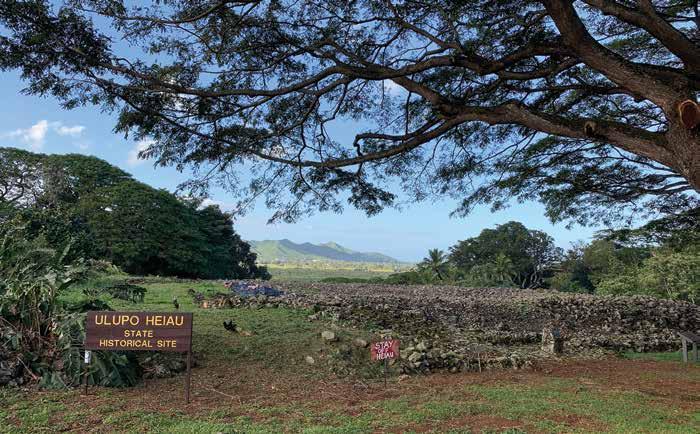
Ulupō Heiau (seen above) in Kailua is one example of a little-known gem that will be part of the commission’s comprehensive inventory of historic sites across O‘ahu. “There are so many state parks with archaeological sites,” says Kiersten Faulkner, executive director of the nonprofit Historic Hawai‘i Foundation. “Ulupō Heiau might be one of my favorites.”
But even after the City Council voted to override Fasi’s veto, he did not enact the ordinance before leaving office. His successor, Jeremy Harris, blocked implementation of the commission, and every mayor after him followed suit. “Most mayors didn’t want this commission to succeed because they claimed it could mean more delays and paperwork that would block development,” says Cypher. “Some mayors depend on development to get reelected.” But, she points out, the commission’s work can actually help developers save time and money. “It’s so important for landowners and developers to know early in their planning whether there are historic sites that might be affected,” she says. “It can avoid costly delays as well as the loss of treasured places of antiquity.”
The ordinance establishing the preservation commission sat on the books, completely inactive, until August 2020 when, as part of a
regular review, Honolulu’s Department of Planning and Permitting put forward a recommendation that the moribund commission be repealed. It was Cypher’s written testimony in favor of implementing the commission that caught council member Kia‘āina’s attention: “I was already inclined to question the repeal, but Māhealani is someone I’ve known for decades, I trust her judgment—and she’s one of my constituents,” says Kia‘āina. “So right there I protested in the hearing.”
It was the beginning of 2021, and Kia‘āina bought time by assembling a working group to update the language of the 1993 ordinance. “I gave them guidance,” she says, “because we wanted to make sure the responsibility of the commission would not be duplicative of other agencies and commissions, and we didn’t want the commission to be so onerous on the development community that it defeats the whole purpose of what we’re trying to do.”
Kia‘āina enlisted Faulkner, Abad and Cypher to look at the nearly thirty-year-old ordinance and update it for the twenty-first century. “When we first introduced the bill in the ’90s, we thought it was adequate as it was,” says Cypher. “But what we learned is that the council at the time amended it significantly, which made the language in the ordinance really confusing. We worked on improving the language so it was clearer and less confusing.”
Kia‘āina knew that to convince Rick Blangiardi to be the first mayor to support the creation of the commission, she needed to present a ready-to-go bill— one that clearly stated the commission’s purpose as a collaborative and not adversarial body. “Esther persuaded the mayor that if we work properly, as a commission should, we can help with a lot of projects where permitting takes a long time,” says Cypher. “We may be able to help reduce some of the wait time. We had to prove that we wouldn’t be there just to block projects but rather preserve things that are important.”




The Dillingham Transportation Building (seen above) in downtown Honolulu was designed by architect Lincoln Rogers, part of an Italian Renaissance Revival in the late 1920s. Built in 1929, it’s listed on the National Register of Historic Places, and it’s one example of a modern structure the OHPC hopes to better protect.
Once introduced, public support for the bill was strong. “I don’t know if any of us expected that level of support,” Kia‘āina says. “Testimony from the community was overwhelming.” The OHPC was activated at the beginning of 2023, and with just a few meetings so far, the possibilities of what it might accomplish are already coming into focus.
Faulkner notes that the OHPC is empowered to nominate specific locations to be registered with the state and federal government as historic sites, and she’s advocating for the commission to go a step further by creating an inventory of historic places on the island.
While the Office of Hawaiian Affairs maintains a database for cultural sites, and there is a list of properties included on the National Registry of Historic Places, Hawai‘i does not have a reliable, comprehensive database of all preserved sites, everything from Hawaiian cultural sites to the Mid-
century Modern architecture of Vladimir Ossipoff and CW Dickey. “You have to have an inventory of historic places to know what they are, where they are, why they are important and how they would be affected by different proposals,” says Faulkner. “And there are a lot of properties that could be listed, that meet the criteria for being listed or that maybe should be evaluated to see if they meet the criteria—but nobody has looked. An inventory like this has been a longtime goal for a lot of people.”
Creating such an inventory benefits not only O‘ahu residents but also the millions of annual visitors to the island. “It’s about the opportunity to go beyond a commercial lū‘au at a hotel,” says Faulkner, “and get to know the authentic places that tell the stories of Hawaiians, from early voyaging to pre-Western contact, through the monarchy period to the present day. This is a living culture—so where are the sites that are part of those stories? Which ones are appropriate for just
that community, which are appropriate for a larger community and which ones are appropriate for visitation? Those things all need to be identified and balanced.”
For Abad, one of the commission’s greatest assets is its ability to catch preservation issues that slip through the cracks. While city building and permitting departments are overwhelmed with a backlog of applications, the commission has the luxury of distance from that daily grind. And this distance, Abad says, allows them to make a difference. “We can take a step back and be circumspect about the whole,” she says, “and offer some recommendations.”
One of the commission’s first recommendations came after a review of the GPS data fields used by government agencies for issuing building permits. “Commissioners Thomas Dye and Richard Davis brought it to our
attention that the state commission and the city permitting office weren’t using the same data fields,” Abad says. “We want to make sure they are both seeing the same information and there is reliability on both sides.”
But the possibilities go beyond data fixes. There are abandoned historic structures, covered in vines and graffiti, such as the Boyd-Irwin-Hedemann Estate near the Waimānalo Forest Reserve, where Queen Lili‘uokalani enjoyed an extended stay before writing “Aloha ‘Oe.” There are dozens of neglected heiau, or ancient Hawaiian temples, scattered about the island, many in poor or unstable condition; some are just unassuming rock formations tucked away in a state or community park without any signage or protection.
Abad says that developing the island responsibly today is intertwined with understanding and preserving its history. “We have a deep belief,” she says, “that the integrity of who we are as a people today has much to do with the richness of our history. Having a tangible connection to that past to remind us and inspire us is a big part of who we are as a people who love this ‘āina [land] and our community. There’s a part of that motivating all of us on the commission.”
While Kia‘āina says she’s excited about the practical effects the commission will have, she’s also eager to see how it might provide encouragement to those who are preserving Hawai‘i’s history in other ways. “The commission can uplift voices and issues that people care about deeply, like the preservation of Hawaiian language and other important issues,” she says. “When people have been in the trenches for a long time, they lose faith in government. So, for me this wasn’t just about the issue but also the faith communities can have in government to do the right thing.”
Cypher points out that in some cases the commission can help the people of O‘ahu realize undiscovered treasures—and the effects of such discoveries can run deep: “There are places where neighbors didn’t even know there was a very important historic place there. And when we tell them, they get all excited about it. It uplifts the spirit of a community.” hh



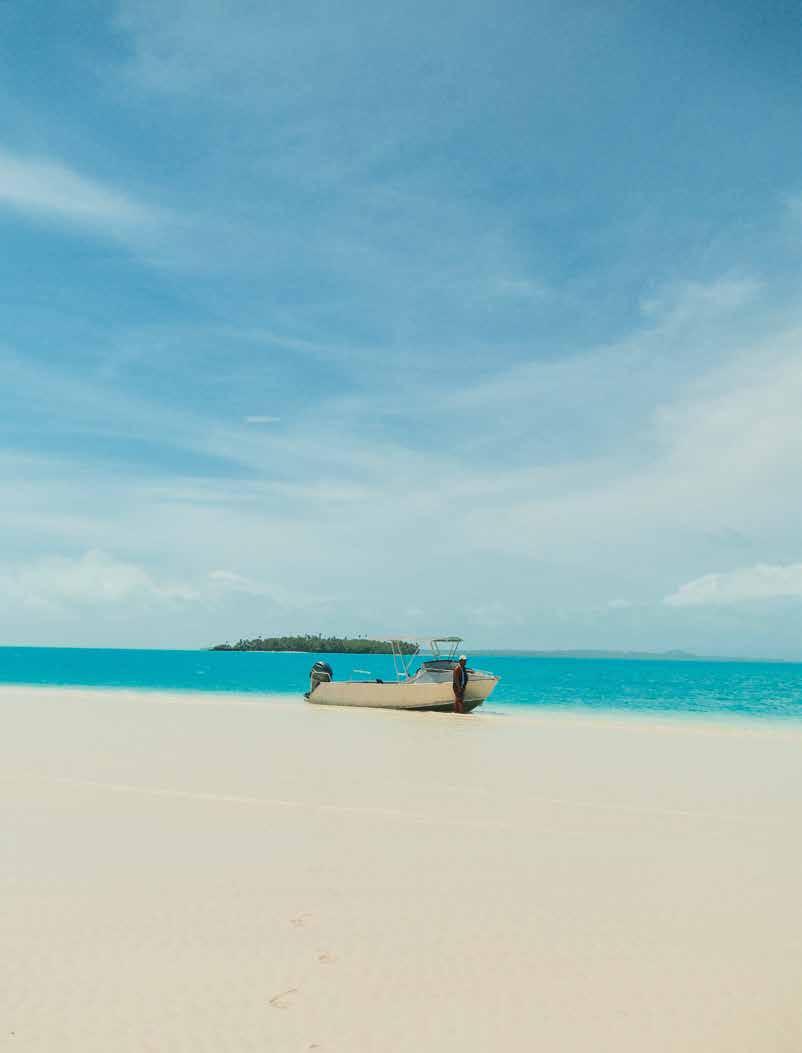
We’re near the head of the octopus,” says Deon Charles Wong, a metaphor about where the Cook Islands are in relation to the rest of Polynesia. More literally, though, we’re sitting on the patio of Trader Jacks, the waterside restaurant, bar and local mainstay in the heart of Avarua on Rarotonga, the capital island and population center of the Cook Islands. The Marumaru Atua, a double-hulled sailing vaka (canoe) owned by the Cook Islands Voyaging Society (CIVS), is moored at the edge of a concrete boat ramp just opposite the patio. A few hundred yards offshore, past the rusted remains of the cargo ship Maitai and through a break in the island’s fringing reef, is the deep blue sea. During whale season, July through October, humpbacks are right there. Sometimes at night, where the reef is even closer to shore, you can hear them singing.
In June, Deon and his wife, Evangeline, will be among those in line to sail the Marumaru Atua (“Under the Protection of God”) to Pape‘ete and then—after joining up with the Tahiti Voyaging Society canoe Fa‘afaite —on to Hawai‘i, where voyagers from throughout the Pacific will converge for the Festival of Pacific Arts and Culture (FESTPAC). Fitting, because CIVS was founded in 1992, after Rarotonga hosted FESTPAC, which takes place every four years in a different Pacific Island group. CIVS president Ian Karika is also here; he carries the chiefly title kamoe mata‘iapo and helped build the Cook Islands’ first modern replica of a traditional sailing canoe, Te Ao o Tonga, in 1994. Deon, Evangeline and Ian all have day jobs, but they’ve given over their lunch hour to talk about their passion.
And passion is why we’re here: As a way of introducing these islands, I originally had in mind to tell you a story of Tangaroa, the improbably well-endowed god of navigation and fertility whose image is everywhere on Rarotonga: on coins and shop signs; museum brochures and (painted graffiti-
style) on bus stop shelters; carved and for sale in tourist shops.
But Tangaroa doesn’t necessarily represent all the other pa ‘enua, the outer islands—“outer,” that is, relative to Rarotonga—which are just as complex (though likely more beautiful) as anywhere else. The Cook’s fifteen islands and atolls are divided into the northern and southern groups. The Spanish explorer Álvaro de Mendaña de Neira was the first European to sight any of the islands, in 1606. Capt. James Cook, the archipelago’s namesake, first arrived in 1773. The islands were not unified under one ruler at the time of European contact, and which islands would eventually constitute the Cooks was settled in 1915 by New Zealand’s parliament. To this day there are variations in language, history and cultural practices throughout the islands.
With its gyms, beauty salons, churches and restaurants, Rarotonga is the most cosmopolitan. But each pa ‘enua has its own identity, its own stories. Cook Islands Māori all identify with their island of ancestry—overseas they might refer to themselves as Cook Islanders, but within the country they’re Rarotongan, Mangaian, Pukapukan. Is Tangaroa in the background of life here? Yes. But life happens in the foreground. Hence, Trader Jacks: One way to learn a bit about modern life in the Cook Islands is to spend some time listening when people talk about their passions. With the ocean so close, it makes sense to hear from canoe people.
The octopus that Deon refers to is a motif among Pacific voyagers, known from the earliest oral histories of Polynesia. It refers to how the islands of the Polynesian Triangle are oriented: The head lies roughly seven hundred miles east-northeast of Rarotonga, in Raiatea, French Polynesia—the center of gravity for voyagers ancient and modern. The tentacles trace connecting pathways outward to Hawai‘i, Aotearoa (New Zealand), Rapa Nui (Easter Island), Sāmoa, Tonga and the rest of Polynesia.


OPENING SPREAD / Between Sāmoa and French Polynesia lie the Cook Islands, an archipelago of fifteen islands and atolls where Polynesian traditions remain strong. Here, the islets of Koromiri, Oneroa and Motutapu in Muri Lagoon, Rarotonga.
TOP / Christianity plays a major role in Cook Islands life. Ebenezera, the church of the Ngatangiia Cook Islands Christian Church congregation on Rarotonga, will celebrate its ninetieth anniversary next year.
BOTTOM / The crew of Vaka Cruise’s Titi-ai-Tonga are true multitaskers— cooking, teaching snorkeling and serenading guests during the six-hour cruise of Aitutaki’s lagoon.
FACING PAGE / The twenty-squaremile lagoon of Aitutaki is larger than the island itself and filled with gemlike islets. A tour boat waits on an empty strand at Tapuaetai (a.k.a., “One Foot Island”; the name derives from a Cook Islands Māori legend), off Aitutaki. The islet of Moturakau is in the background.
The Cooks are a major waypoint on these long-sailed pathways: The legendary navigator Kupe, whose father was from Rarotonga and mother from Raiatea, is believed by many to be the first to have reached Aotearoa, leading to its settlement. Another famed navigator, Paikea, figures in stories made popular by the film Whale Rider He is well known in parts of Aotearoa, but it is sometimes forgotten that he has roots in Mauke, an island in the Cooks’ southern pa ‘enua. Two years ago Tua Pittman and Peia Patai—master navigators trained under the auspices of Hawai‘i’s Polynesian Voyaging Society— founded a second voyaging group in the Cook Islands, Te Puna Marama Voyaging Foundation, which sails a vaka named Paikea. Patai is himself from Mauke; the canoe’s name came to him in a dream.
Deon and Evangeline are bound up in the tentacles of the octopus. There are roughly fifteen thousand residents in all of the Cook Islands, with the majority, just under eleven thousand, on Rarotonga. Meanwhile, more than eighty thousand Cook Islanders live in New Zealand, another twenty thousand-plus in Australia, and countless more scattered throughout the world. Some wags will tell you that there are actually seventeen islands in the Cooks, if you include New Zealand and Australia. Though the islands are self-governing, they are ultimately part of the Realm of New Zealand, which means that all Cook Islands nationals are also New Zealand citizens. Depopulation has been a concern in the Cook Islands since at least the 1970s, and the current government continues to seek ways to bring more working-age adults back to the islands, but it’s long been a reality that people come and go and come again
“He’s a New Zealand Māori and I’m Atiuan, so that’s how we came back here,” says Evangeline. “We started sailing in New Zealand on another canoe, Te Matau a Māui (the fishhook of Māui). … In a way it was a meeting place of both our cultures: Whereas his marae [community land] is his marae, and my land is my land”—she and Deon both laugh at her emphasis—“the vaka is a place for both of our cultures to meet.”
Evangeline’s subtle joke about landownership is rooted in one of the things that sets the Cook Islands apart: Land cannot be bought and sold in the Western sense. It’s all a bit complicated, but basically, the land remains in the hands of Cook Islanders—people might come and go, but there will always be something to come home to.
years ago, and Aitutaki is Hawai‘i 150 years ago,” says Teanaroa Paka Worthington. We’re sitting on the patio of the Lucky Rooster Eatery, a few steps away from his Avarua shop, Paka’s Pearls, talking story about the similarities and differences between Hawai‘i and here.
Paka embodies these differences: His mother is Rarotongan and Tahitian, and his father, the late Robert Worthington, was Hawaiian. The elder Worthington served as the Cook Islands’ honorary consul to the United States for thirty-five years, during which time he was also the director of financial and scholarship services at O‘ahu’s Kamehameha Schools. Paka was born on Rarotonga, lived in Hawai‘i from age 6 to 18, earned a bachelor’s and a master’s in Washington DC and then returned to work in the government of Prime Minister Sir Geoffrey Henry. Since leaving the public sector, he has “for many moons,” as he puts it, done “a little bit of this, a little bit of that, a little bit of everything.”
Paka is a lifelong surfer and canoe paddler, and for many years now also an avid kitesurfer. In a few days the annual Vaka Eiva will get underway: a weeklong series of outrigger canoe races held each November, which he conceived and that first ran in 2004. He is also behind the Manureva Aquafest, a weeklong series of competitions each August that brings kitesurfers to Aitutaki’s twenty-squaremile lagoon—considered one of the best venues in the world for the sport. Both Vaka Eiva and Manureva Aquafest are global draws—this year’s canoe races brought more than 350 international entrants—and both were conceived to be a mix of serious competition and even more serious fun.
“The difference over here,” Paka continues, “is that you’re nearly free of

FACING PAGE / The boat ramp opposite Trader Jacks restaurant in Avarua gets busy as vaka ama (outrigger canoes) launch during the Vaka Eiva, an annual outrigger racing competition that draws paddlers from around the world.
rules and regulations. As long as you don’t cross any lines, you can pretty much do whatever you want. In Hawai‘i and other places, when a canoe race finishes, everyone goes their own direction. Over here we purposely broke it all up so that you race one day and the next day off. Everyone finishes and stays and parties together—you have a beer on the beach, and no one says a thing—so you can race, have a good time and don’t have to worry about tomorrow.”
These less stringent rules are not limited to canoe racing and are visible—or rather, not visible—pretty much everywhere you go in the islands, starting with the warning you’re given when you pick up a rental car at the airport. “Don’t park under the coconut trees.” Coconuts are a staple here, and so is common sense: Unlike Hawai‘i, where coconuts are trimmed to protect passersby, here you’re expected to look up. Another example: On Rarotonga, at Tumutoa Tours’ Umu Feast, String Band and Fire Show, Ngame and Mānia Mamanu lead groups through
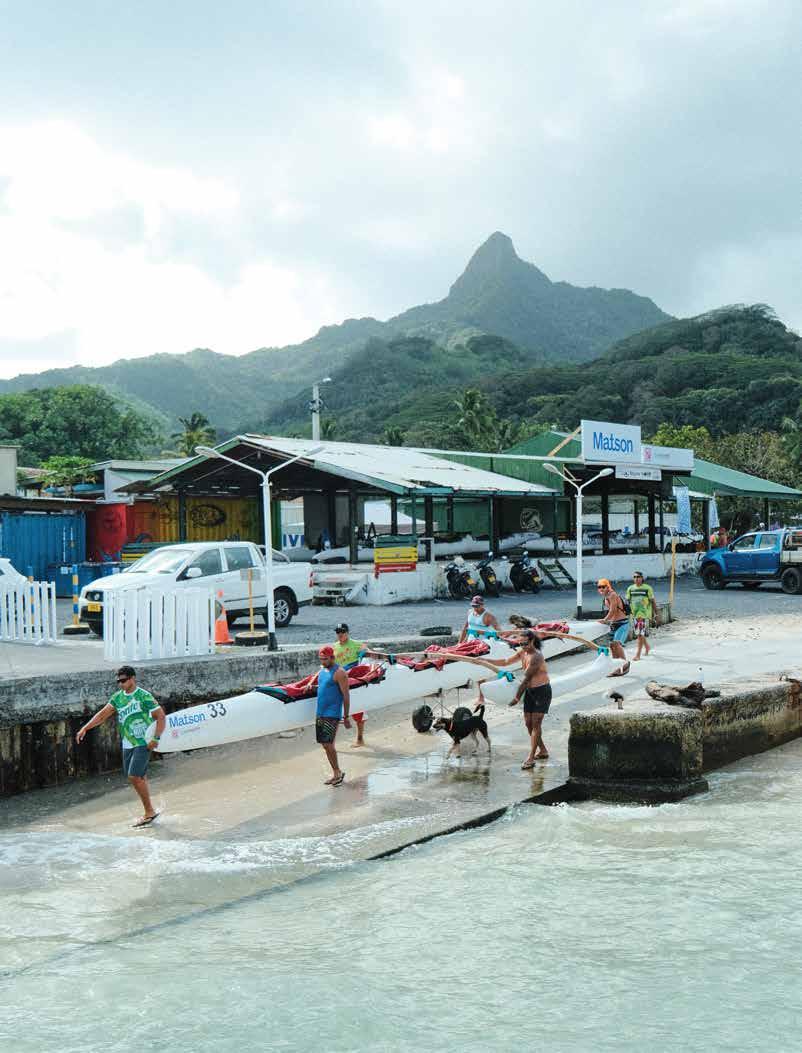

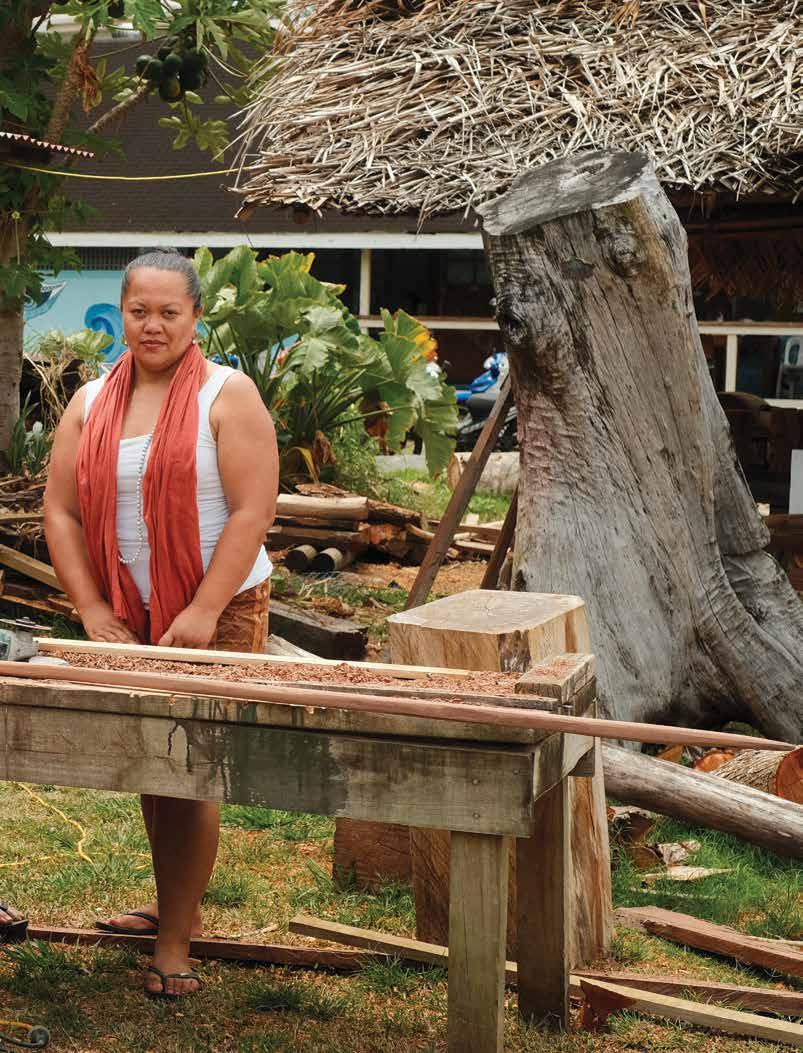
the entire process of producing a traditional feast—it’s an enlightened reversal of the standard Hawaiian tourist lū‘au, where islanders cook and serve. Guests handle everything from meat cleavers to red-hot rocks. The evening is capped off with a fireknife show that includes audience participation—this might be the only place in the world where one can hand a flaming baton to a woman in rayon and urge her to give it a whirl. If it sounds like I’m poking fun, I’m not: I grew up in Hilo, when the drinking age was 18, aerial fireworks were legal and people figured how to mix those things. The Cook Islands echo those times, and I adore it.
You hear it said often that these islands are years “behind” Hawai‘i, and always with pride. If you fly the fifty minutes to Aitutaki and tour the lagoon with Vaka Cruises, tour leader Alistar “Ali” Maao will tell you that Aitutaki’s pristine waters are fifty years behind Hawai‘i, “and we want to keep it that way.” On Atiu, another short hop from Rarotonga, Atiu Villas general manager Jackey Tanga told me that the island, with its population of 383, is somewhere around thirty years behind Rarotonga. “Atiu forces you to go back in time,” she says. And this is a good thing: Going back in time means knowing and caring for each other. Several years ago Roger and Kura Malcolm, the owners of Atiu Villas, began setting aside a percentage of the profit from every room rental. Each year at Christmas time, they divide the fund up equally among every man, woman and child on the island. Since 2012 their “tourist dividend” has paid out more than $100,000.
It’s a beautiful thing, and only part of the Cook’s appeal. “We have no homelessness, negative unemployment, free health, free education, free dental, free water, no real estate taxes,” says Paka. “Foreigners can’t own land, and we’re in control of foreign investment, land and immigration. We’re one of the last countries with no Starbucks, no KFC, no McDonald’s. … You could even
make an argument that we’ve got the highest standard of living in the world. Honestly, you’re probably talking the best country in the world—we’re pretty lucky, no question about that.”
There are two main roads on Rarotonga, the Ara Tapu, or coastal road, which runs the island’s entire twentymile circumference, and the Ara Metua, which covers portions of the island about a quarter-mile inland. Up on Ara Metua, in Avarua’s neighboring district of Avatiu, Gallery Tavioni and Vananga is bustling. Mike Tavioni is on the grass, laying into a log with a chain saw while his wife, Awhitia, is under the eaves, carving a smaller piece by hand. There are roughly two dozen youth scattered between them, carving, cleaning up or just watching. Mike and Awhitia are both renowned artists, though Mike—or, more properly, Mitaera Ngatae Teatuakaro Michael Tavioni BEM— tends to be the more public-facing. (The BEM stands for his most recent recognition: the British Empire Medal, which he was awarded in 2022.)
In the gallery you can buy a variety of modern and traditional art, handmade pareu and other items, some made by Mike or Awhitia, some by other local artists. But that’s all background to the real function of the space. Depending on where you are in the Cooks, vananga translates variously as teaching, talking or sharing knowledge.
Although he works in a variety of media, Mike is best known as a carver and canoe maker. His art is easy to find on Rarotonga: Look toward the ocean as you leave the airport and you’ll see the RSA Memorial Gateway, a commissioned work that he and Awhitia carved in collaboration with New Zealand artist Michel Tuffery, to honor Cook Islanders who served in World War I. He’s also written several books on a variety of topics and is widely acknowledged as a repository of traditional knowledge. Now in his seventies, he devotes most of his time to teaching.


PREVIOUS SPREAD / Mike Tavioni and his niece, Gina Tavioni Bamber, at Gallery Tavioni and Vananga, a gathering place for those who want to learn about Cook Islands arts and culture.
TOP / A contemporary adaptation of a Cook Islands tivaivai (quilt) by an unknown Tahitian artist, with Mike pictured at center in a still from a film in which he had a bit part as a chief. He carved the Atiuan momore (spear) he’s holding, the atamira (chief seat) he is sitting on and made the tapa (bark cloth) he’s wearing.
BOTTOM / Wooden blocks are used throughout Rarotonga to dye pareu (seen on the facing page). Mike and his wife, Awhitia, hand-carve their table-size blocks with the help of apprentices and whoever might be just passing by.


ABOVE & FACING PAGE / Although Rarotonga is the most populous of the Cooks, it is still a mostly rural island, with a pace to match.

“What Uncle has been focusing on is knowledge transmission,” says his niece, Gina Tavioni Bamber, who helps keep things running at the space. “He’s really been investing time into the next generation. Right now he’s got five apprentices, and what we’ve got here is a cultural exchange”—she gestures to the kids working in the yard just outside the gallery. “This is a New Zealand Māori whānau [extended family] group, where they’ve taken their children out of the normal education system and are homeschooling them. There’s more and more of these groups coming through; him and Auntie still make their art, but the real art is the knowledge repository that he’s creating by spending time with anyone and everyone who asks.”
In 2023, Mike finished a monthslong collaboration with CIVS: Te Mana o te Vaka, or, as the CIVS translates it, “the power, prestige and authority of the vaka.” The goal was to use traditional methods to produce six canoes of various design, along with all the necessary components: sails, paddles and sennit for rope; fishing hooks, lines and lures. For Mike the value of the project was more the process than the product.
“My teaching is about traditional life skills,” he explains. “If you ask ‘What is the worst thing that will ever happen?’ it’s food insecurity. Life skills are the crux of everything: It involves the production of food—when to plant relative to the phases of the moon, to high and low tides and the month of the year. It involves when to go fish for what particular fish, what time of night, what moon phase, what time of the year. When to do voyaging, when to stop altogether. Those are the knowledges we are losing—our traditional knowledge that we’ve gained over thousands of years.”
In other words, to build a canoe, one first has to understand how to cultivate all of its component parts. “Canoe making was never dead,” he continues. “So it’s not a revival, but through the encouragement to get more people to learn and participate in canoe making, hopefully they’ll be urged to learn more: maybe more about the cosmos in relation to navigation, and then more about the cosmos in relation to planting and harvesting food, and
obtaining food from the sea. Canoe making revives the art of sennit making; then when you talk about sennit, you talk about the coconut, which becomes its own world of knowledge: The leaves provide the roofs for our houses, the trunks we use for posts and the bark we use for mosquito repellent. The roots we use for fish traps, and then we use certain types of coconut for medicine and for oil, which we can make into almost anything … soap, cooking oil. With the canoe, you touch on all kinds of different things.”
My last night on Rarotonga coincides with the first day of racing for this year’s Vaka Eiva, which means there’s a big party over at the Islander Hotel. Standing in line at the entrance, paddlers present their wristbands, which had been passed out earlier in the day. The ocean had been rough; one paddler held up his naked wrist and said with a laugh, “Tangaroa took mine!” No problem: He was waved in.
The evening turned out to be everything I love about the Cook Islands: good food, good music and loads of fun. During the awards ceremony for the first day’s races, a paddler from New Zealand receives her medal, and a Māori contingent delivers a haka (dance) that has the room cheering. Each time the winner in a different classification is announced, a tini ka‘ara (drum ensemble) fires up a booming, staccato beat: tak tak taki tak, taktaktaktaktaktak. The Cook Islands have a national anthem, but they also have a national rhythm, and this is it. As they approach the stage, medal winners spontaneously break into steps of the lightning-fast ura that’s danced here and farther east in Tahiti: men and women from Tahiti, the Cook Islands, New Zealand, Australia, dancing and celebrating. Paka was right: This is very different.
It all brings to mind a conversation I’d had a few days earlier with Emile Kairua, the newly appointed secretary of the Cook Islands Ministry of Cultural Development. We were initially talking about the ministry’s preparations to send roughly a hundred dancers, musicians and artisans to FESTPAC but drifted back toward talking about canoes and what the dual voyaging
revivals in Hawai‘i and the Cook Islands have in common. Years ago Emile was on Hōkūle‘a when the Polynesian Voyaging Society made one of its early trips from Hawai‘i to the Cook Islands for FESTPAC in 1992.
“We still had our language and a lot of our traditional system,” he mused, speaking of the era when the CIVS was founded. “But taking it back to the vaka—not so much the vessel, but the vaka that is your island, the vaka that is your village, the vaka that is your family. Take it back to the root and you understand that if we are not careful, we could find ourselves in the same vaka that many of our Pacific Island brothers and sisters are in. We will lose our peu our traditions, our identity, our language. Many people say, ‘We can stand on our own and declare our own victories,’ but we also have to be inclusive in celebrating our collective victories as one Pacific people of Moana Nui o Kiva— the blue continent we call home.”
Tak tak taki tak, taktaktaktaktaktak. The drums play on at the Islander, and the party carries into the night. A bunch of rowdy canoe paddlers having a good time? Sure. But there’s more to it. Something of Tangaroa? Perhaps. But definitely something of what Evangeline had said when we met at Trader Jacks: “One of the things about the Cook Islands is that we all come and go. We’ve come and gone for thousands of years: We go to Tahiti, we come back here; we go to Aotearoa, we go here, we go there and come back. This is why the vaka is a core part of our history and the metaphor everyone uses, because we are vaka people—it is a core part of who we are.” hh

 LEILEHUA HIGH SCHOOL, WAHIAWĀ CLASS OF 2019
LEILEHUA HIGH SCHOOL, WAHIAWĀ CLASS OF 2019
To become a high school graduate in Hawai‘i is to also become a walking, talking floral arrangement. Or possibly a staggering, muffled floral arrangement, depending on the weight of all those lei around your neck and how much they block your mouth. The draping of garlands upon the shoulders of honorees is an enduring Hawaiian practice at all sorts of occasions, from weddings, birthdays and guest lectures to anniversaries, funerals and gubernatorial victory parties. But nowhere are more people seen (or unseen) laboring beneath lei stacked to their eyeballs and beyond than at graduations.
For as long as newly minted Hawai‘i scholars have been donning caps and
gowns, their families and friends have been burying them in heaps of flowers and foliage. The larger the family, the higher the heap—which might also contain nuts, seeds, fruit, candy, toys, plaited ribbons, mock vanity plates and snack-size bags of XXTRA Flamin’ Hot Cheetos. So strong is this tradition that even when the Covid pandemic disrupted in-person commencements, the socially distanced Class of 2020 simply adapted its lei ceremonies to the drive-by format.
Hawai‘i’s graduation celebrations have evolved with influences from throughout the Pacific. The commanding Samoan headpieces known as tuiga, adorned with cleverly folded bills of various denominations,
have become a popular style of money crown rich in both South Pacific cultural currency and US paper currency. Other ways to accessorize graduating seniors involve pool floaties, banners, bubble machines and life-size photo cutouts that enable the graduates to pose for pictures with themselves. Some enthusiastic families even put their diploma recipients upon miniature homemade stages equipped with backdrops, spotlights and thumping speakers. Yet no matter how far over the top things go, the intention remains unchanged: to honor the graduates’ accomplishments and wish them well as they face the future—hopeful, open to possibility and appreciative that money crowns don’t grow on trees.

 LEILEHUA HIGH SCHOOL GRADUATION CEREMONY CLASS OF 2019
LEILEHUA HIGH SCHOOL GRADUATION CEREMONY CLASS OF 2019
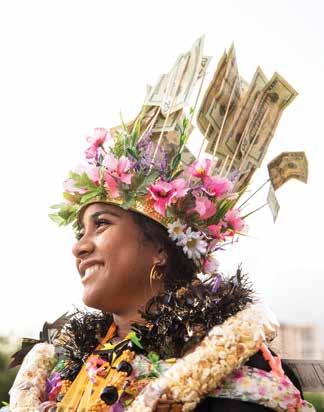
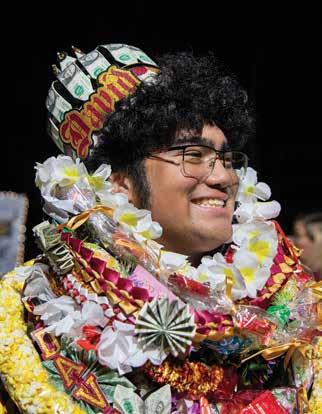

 SIWIAN NICKEPWI, MCKINLEY HIGH SCHOOL, HONOLULU CLASS OF 2023
TAIMANE FALEAFINE-AUWAE, MARYKNOLL HIGH SCHOOL, HONOLULU CLASS OF 2023
DAVID CHIM, MARYKNOLL HIGH SCHOOL, HONOLULU CLASS OF 2023
CHEVELLE TAVAKE, MCKINLEY HIGH SCHOOL, HONOLULU CLASS OF 2019
SIWIAN NICKEPWI, MCKINLEY HIGH SCHOOL, HONOLULU CLASS OF 2023
TAIMANE FALEAFINE-AUWAE, MARYKNOLL HIGH SCHOOL, HONOLULU CLASS OF 2023
DAVID CHIM, MARYKNOLL HIGH SCHOOL, HONOLULU CLASS OF 2023
CHEVELLE TAVAKE, MCKINLEY HIGH SCHOOL, HONOLULU CLASS OF 2019

 TAYLOR NAKASHIMA, MCKINLEY HIGH SCHOOL, HONOLULU CLASS OF 2023
MIA HIRONAKA, MARYKNOLL HIGH SCHOOL, HONOLULU CLASS OF 2023
TAYLOR NAKASHIMA, MCKINLEY HIGH SCHOOL, HONOLULU CLASS OF 2023
MIA HIRONAKA, MARYKNOLL HIGH SCHOOL, HONOLULU CLASS OF 2023
 CHRISTINA TAGO, MCKINLEY HIGH SCHOOL, HONOLULU CLASS OF 2023
CHRISTINA TAGO, MCKINLEY HIGH SCHOOL, HONOLULU CLASS OF 2023
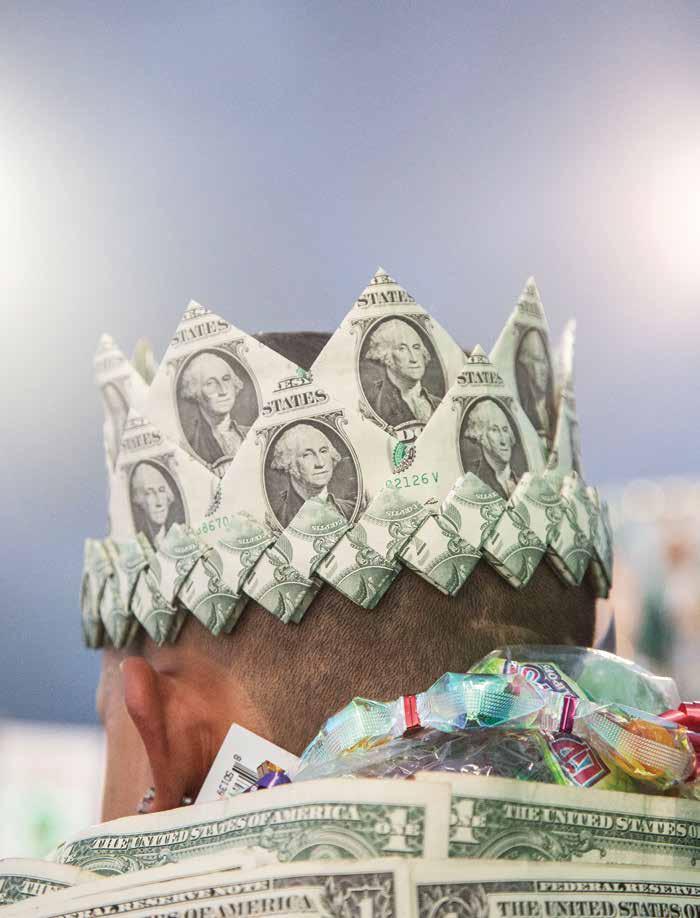 LEILEHUA HIGH SCHOOL, WAHIAWĀ CLASS OF 2019
LEILEHUA HIGH SCHOOL, WAHIAWĀ CLASS OF 2019
 KEALOHA CHARLES, KAILUA HIGH SCHOOL, KAILUA
CLASS OF 2020
KEALOHA CHARLES, KAILUA HIGH SCHOOL, KAILUA
CLASS OF 2020
 LEILEHUA HIGH SCHOOL, WAHIAW Ā CLASS OF 2019
LEILEHUA HIGH SCHOOL, WAHIAW Ā CLASS OF 2019
 SHILEEN LAFAELE, MCKINLEY HIGH SCHOOL, HONOLULU CLASS OF 2023
SHILEEN LAFAELE, MCKINLEY HIGH SCHOOL, HONOLULU CLASS OF 2023
 RUDY BADUA, MCKINLEY HIGH SCHOOL, HONOLULU CLASS OF 2023
RUDY BADUA, MCKINLEY HIGH SCHOOL, HONOLULU CLASS OF 2023
For Moana Jones Wong, Pipeline is more than a wave, it’s a way of life
Moana Jones Wong glows when she talks about the most dangerous surf break on Earth: Banzai Pipeline. Her eyes light up and she flashes a brilliant smile. Moana doesn’t talk about Pipe like she’s describing a place or some inanimate patch of reef—to her it’s a being. “Anyone who surfs Pipe, who truly loves surfing there, will tell you that Pipe is some kind of entity,” she says. “It’s something more than a wave. It’s alive.”
When Moana talks about Pipe, it’s like hearing about a teenage crush— intense, shameless, unmanageable. “Pipeline can make you go crazy over her and make you want to surf out there for the rest of your life,” she says. “It’s like a relationship: The more time you spend with her and get to know her, the closer you get. You understand the ins and outs and moods and what makes her happy or sad.”
Which is rich, because shortly before catching the “wave of her life” at the break in 2023, Moana thought of cutting ties completely. Things had been going well for Moana in 2022; she beat five-time world champion and Olympic gold medalist Carissa Moore to win the




OPENING SPREAD / Moana Jones Wong drops into a career-making monster at the 2023 Da Hui Backdoor Shootout, the wave that established her cred once and for all at Pipeline.
ABOVE / Moana (right) with friend and filmmaker Shannon Hayes, all smiles (as usual) post-win at the 2023 Vans Pipe Masters.
FACING PAGE / “You can see in her eyes how deeply connected she is to the break,” says pro surfer Kala Grace of her childhood friend Moana, seen here at the opening ceremony of the 2023 Eddie Aikau Big Wave Invitational. “She knows exactly what wave she wants and won’t even look at a wave if it’s not ‘the one.’”
Billabong Pro. But during an early heat in the 2022 Vans Pipe Masters, a wave bucked Moana off her board and bounced her on the reef, leaving her with a concussion and doubts about ever surfing the wave again. Was this relationship worth devoting—or losing—her life to?
Then, a week later, at the 2023 Da Hui Backdoor Shootout—a local, highly respected, if-ya-know-ya-know event that takes place every season at Pipeline— Moana was invited to compete on a team with four extremely accomplished surfers, like four-time Pe‘ahi Challenge winner Billy Kemper, Big-Wave World Champion Makua Rothman, Pipeline specialist Kala Grace and Tahiti’s brightest young surf star, Eimeo Czermak. Although still shaken from her wipeout the week before, she couldn’t say no and—just her luck— paddled out into the biggest Pipe she’d ever surfed.
“Third-reefing” is what they call it when the swell is so big that waves break a half-mile out to sea, on Pipeline’s “Third Reef.” They roll through and bury the lineup of surfers sitting fifty yards from shore. “It was the biggest I’d ever been out in, and I was so scared,” she recalls. “I did not want to be out there that afternoon.”
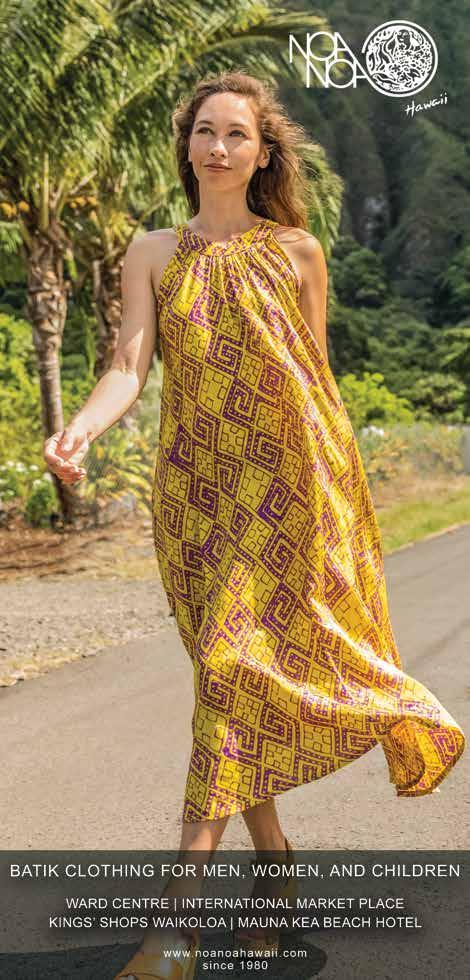

“What keeps me coming back to Pipeline every time is the challenge,” says Moana, pictured above on one of the waves that propelled her to winning the 2023 Vans Pipe Masters. “Even when I’m old and beat up, I’ll still want to surf out there. A wave out there is the greatest high in life.”
The fact that her teammates were dropping like flies didn’t help. Billy was seriously injured in a wipeout and had to be carried in by lifeguards. The next day, Moana watched Makua and Kala get hit by waves so hard their helmets were ripped off. She could hear ambulance sirens wailing down Kamehameha Highway toward ‘Ehukai Beach Park, the red lights flickering through the public access trail. Dodging giant, washthrough sets with only her teammate and childhood friend Kala with her, she thought, “I am not catching a wave today, I’ll just paddle in.”
Just as the horn blew to signal the end of their heat, a perfect ten-foot (Hawaiian-scale, which means wave faces can be twenty feet or so) set came right toward her. She was deeper than Kala, who gave her that “You going?” look. Moana put her head down and stroked into what many would call “the wave of the winter” that season: a solid, experts-only steep drop behind the peak into a deadly tube that spat her violently into the channel.
“All day, everything in my body was telling me don’t go, but that one came through and something said go! That single wave meant more to me than when I won the Championship Tour event and beat world champions—it meant more to
me than anything that ever happened in my life, which is crazy because I literally was going to quit surfing Pipe last week.” Romance, right?
“I watched that legendary wave just after the horn at the Shootout last year, and I was absolutely blown away and inspired,” says Carissa of Moana’s ride. “That wave was so heavy. This tiny human got the best barrel of the day. And not the best for a woman, but for anyone.”
While Moana had been thinking about quitting Pipe, there was a time when she considered giving up surfing entirely. Raised on the North Shore of O‘ahu, the now-24-year-old, like dozens of other surf-obsessed kids on the “Seven Mile Miracle,” competed from an early age. By 15 she’d won four amateur national titles and was already competing against adult women in the World Surf League’s Qualifying Series for a spot on the coveted World Tour.
On her way to the qualification prize, her momentum was thwarted by a nasty MCL tear, a fairly common knee injury among surfers. But during those six months of recovery out of the water, her main sponsor dropped her (another common injury of a different kind among surfers).
Feeling betrayed by a brand that had supported her for years—and an industry that seemed impatient and cold—Moana stepped back from surfing. She enrolled at the University of Hawai‘i West O‘ahu, got off social media, was working three jobs at one point while getting financial assistance and still making barely enough for rent and food. Hardly a year after the accident that sidelined her surf career, life was feeling a little like rock bottom.
“When I was younger I was like, ‘There’s no way I’m going to college. Screw that. I want to be on the Championship Tour, so that’s not happening.’ But then when that all happened I was like, ‘Maybe I’m not supposed to be surfing.’ So then I just transitioned into school and kind of stopped surfing for a little bit. But after my knee eventually healed, something started drawing me to Pipeline.”
Most of the friends Moana grew up with had become Pipe celebrities, but she, like most mortals, had always been terrified of the spot. Sure, she’d surfed there a few times, but until she was 18 she largely avoided it. Until, that is, the woman now known as “Mrs. Pipeline” felt like she had nothing left to lose. She spent the next few winters more or less surfing only that wave, working her way up the pecking order of the world’s most cutthroat lineup. With every session, every wipeout, every incremental improvement, she was falling more in love with the break. “When I got dropped by my sponsor, I felt like I was a nobody,” Moana says. “Then Pipeline made me feel like I was somebody again. I was like, ‘Oh, I’m not down on the ground anymore.’ It was where I found my happiness.”
Moana says that she’s cripplingly shy—which is a problem for someone drawn to the most watched, photographed, webcast, live-streamed, scrutinized wave in the world. During her first couple of years back, she’d paddle out a hundred yards down the beach to avoid the judging eyes of her friends and visitors from the surf industry watching from the beachfront “team houses.” It was as if she wanted to be the invisible surfer. Pretty difficult, as she was scoring some of the best waves a woman had ever caught out there.
“Growing up, there were some women surfing Pipeline, but I never
saw any getting crazy ones, you know?” Moana says. “You can’t really look up to someone who’s just surfing Pipe—you look up to someone who’s excelling, someone getting the same types of waves as the men and making a name for themselves out there. You always hear about the ‘King of Pipeline’—Gerry Lopez—but I never heard about a queen.”
Within a few years Moana certainly made a name for herself out there, simultaneously graduating from university with a new degree in Hawaiian health and healing and a new main sponsor, Volcom, which paid her to surf professionally again. The moniker “Queen of Pipeline” was already being whispered before she was officially crowned in 2022.
Entering as a wildcard in the Billabong Pipe Pro, a sanctioned WSL event for the world’s top twenty-two women surfers, Moana dominated the field and found herself in the final heat against Carissa. Moana beat the Olympic gold medalist handily. After the event, Moana kicked off the competition season as the number-one-ranked woman surfer in the world.
“I really admire Moana’s dedication to mastering a spot like Pipeline,” says Carissa. “Her time and effort out there have helped to pave the way and raise the bar of what’s possible for women in waves of consequence. I have so much respect for what she does for the sport of surfing.”
Today, Moana doesn’t seem at all like a woman who essentially gave up surfing six years ago. If one were to flip on Amazon Prime this past summer, you’d see her face on a banner flash across the screen for Amazon’s Surf Girls series. The four-part reality show focuses on the paths of four Native Hawaiian surfers during the course of a year; Moana was featured on the show. While she says she enjoyed it, she was a little uncomfortable with a film crew and entourage following her everywhere during production. She’d only ever flown solo and under the radar. Actually, not solo-solo. Moana married Tahitian surfer and fisherman Tehotu Wong when she was only 21. I ask Moana if jealousy is ever an issue—Tehotu having to share her with


“Surfing is a huge part of our culture, but so is the language, the dance, the instruments and the music,” says Moana, seen above at the opening ceremony of the prestigious Eddie, into which Moana was invited as an alternate surfer; when she’s not surfing, the “Queen of Pipeline” also dances hula. “Just like hula, surfing for Hawaiians is not just a sport—it’s a cultural expression.”
Pipeline—and if he ever begged her to sit a particularly dangerous session out. “No,” she laughs, almost regretfully. “He never says it’s too big, only eggs me on. I wish he held me back a little … but he loves to see me happy out there.”
Along with her sponsorship obligations, Moana runs the Moana Surf Club. Now in its fourth year, the club is a community outreach/ mentorship program for girls to surf and bond with one another. “It’s awesome because I watched how these
girls have created this supportive girl gang, something I never really had growing up,” Moana says. “I’d be with the boys 24/7, getting rousted, and had to be super tough, so it’s nice seeing this loving environment.”
Preparing for this year’s North Shore season, an El Niño winter during which waves are forecast to be exceptionally active and XL, Moana received both an alternate invite to the prestigious Eddie Aikau Big-Wave Invitational and another to the 2023 Vans Pipe Masters. Running
an updated format for the event, where all competitors in the Pipe Masters surf three non-elimination rounds, with the top three scores from all rounds deciding which four surfers make the final—Moana barely squeaked into the last, stacked heat. Then she did what queens do: She took the throne, bagging two supercritical waves, and outsurfed the three other women— Carissa Moore included. Heart perpetually on her sleeve, Moana broke down when she heard the score proclaiming her the 2023 Pipe






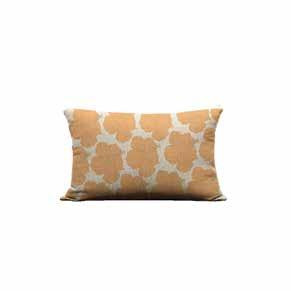




Master and cried unabashed tears of joy, the zillion cameras pointed at her be damned. The $100,000 prize was just icing.
I ask her if that crown feels heavy now, with all the expectations that come with being called the Queen of Pipeline. “Nope,” she shrugs, her eyes twinkling. “I finally feel like I deserve it. Maybe not before that one wave last year at the Shootout, but now I’m like, ‘OK, you can call me that. But only because I feel like I earned it.’” hh






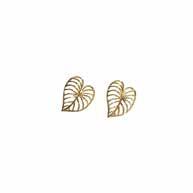




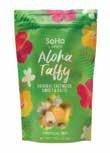
On the morning of August 8, 2023, chef Isaac Bancaco woke early, at 4:30, thinking about the wedding at the restaurant where he worked—Pacific’o on the Beach in Lāhainā—would be hosting for lunch that day. But the electricity was out. There was no hum from the streetlights or air conditioners, only the sound of gusty wind. He hopped on his bike, racing to Pacific’o to secure the walk-in refrigerators and stash ice in coolers to preserve as much food as he could. Trees were down everywhere, and four blocks from the restaurant, a transformer and severed telephone pole hung by their wires.
STORY BY SARAH BURCHARD

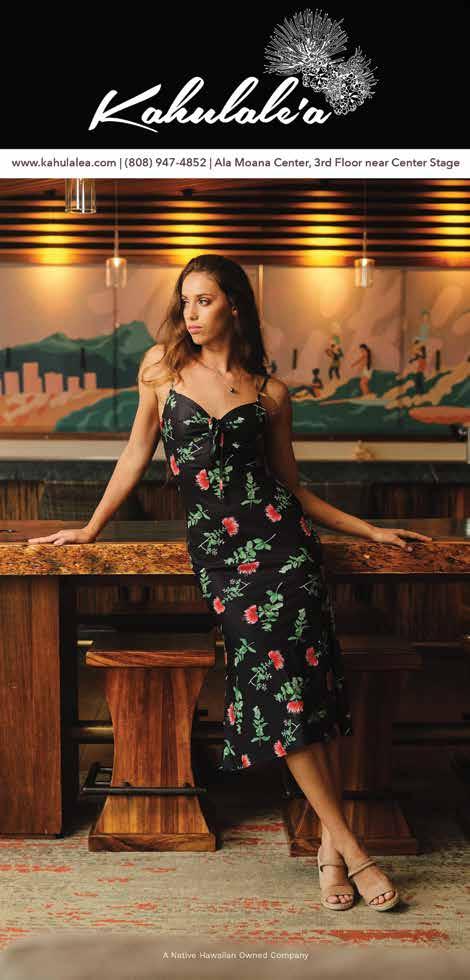
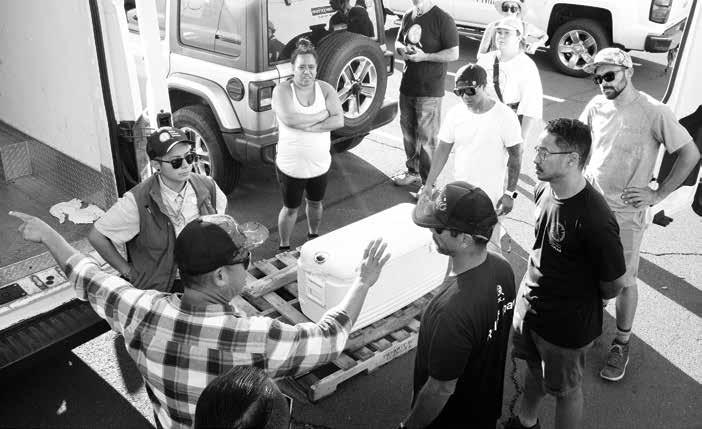
Chef Isaac Bancaco (seen above, gesturing) directs volunteers for Chef Hui, which is helping to feed people displaced by the fire that destroyed Lāhainā on August 8 of last year. “We didn’t have a plan for distribution, really,” says Bancaco of the immediate aftermath of the fire. “All we knew was, there’s six thousand West Side residents who are still out there and have no resources. The initial effort was: Get hot food in containers and let’s figure it out.” On the previous page, Bancaco (left) and chef Sheldon Simeon pack vehicles with venison fried rice for distribution.
Despite the outage, the wedding went ahead. Bancaco and his crew served sixty people cold cuts, bread and iced tea in lieu of a lavish lunch. After the last of the guests trickled out at 1 p.m., Bancaco sent his staff home and called off the dinner crew. Two hours later his dad—a retired fire captain in Lāhainā, where most of Bancaco’s family fished for sustenance—called to see if his son could pinpoint where the smoke outside was coming from. Bancaco drove to a clearing just in time to witness several small tornados heading straight for an area where four firetrucks had just put out a fire.
In a matter of seconds, Bancaco says, it looked like the wind picked up the fire and spread it across a hundred yards of dry brush. “As quickly as the wind was moving, the fire moved,” he says. When he saw homes being engulfed, he fled to his own house on Front Street, packed a couple things and drove to a spot from which he could
watch traffic on the main highway from across a giant field. By the time traffic let up, it was 6:30 p.m. and the fires were raging. Bancaco had to drive his truck over telephone poles and through burning brush to escape. “Once I got out I looked back and could see Front Street on fire,” he says. “Besides my dad, I didn’t know who got out and who didn’t.”
A mile away, on Lahainaluna Road, Luis Fuentes, a former Ritz-Carlton chef who owned a catering business, deli and six food trucks, had already sent his staff home and was waiting in his office for his generator to charge the walk-in refrigerator. When he saw the wind rip the roof off the building next door, he boarded up all his windows and called his wife. Then he smelled smoke. It was coming from the corner of his building. Fuentes tried to flee in his van but got stopped after only one block on Front Street: The fire was approaching from all directions. He jumped out of his van into the thick, black smoke and helped
people out of their cars. “I start telling them, ‘We need to jump in the water, there’s no other place to go!’” he says. Not a minute after rescuing two children and their grandmother from their car and hurrying them into the water, Bubba Gump Shrimp Company exploded. Fuentes filmed himself telling his family how much he loved them, stashed his phone in his backpack, flung it onto a wall, secured it with a rock and dived into the water. He treaded for hours along with hundreds of others, holding a 9-year-old boy, until he heard someone calling, “Help Nana! Help Nana!” He turned to see a man trying to swim with an older Filipino woman in his arms. “I helped carry Nana like a kid, you know, holding her by the waist and carrying her in,” Fuentes says. But cars and more buildings began exploding, forcing them back into the water. “When those cars exploded I went underwater and I couldn’t breathe,” he said. “I don’t know how long it took
me to catch my breath. I had to drink ocean water just trying to clean my throat and mouth; it was full of debris. Once I caught my breath, I started looking for the guy and Nana … and there was no place for them to be found.”
After nine hours treading water, Fuentes was numb from his chest down and burned from his shoulders up. When he decided to leave the raging waters for the uncertainty of the smoldering shore, a woman begged him not to go, fearing he would suffocate. It was past midnight when firemen found him lying in the sand with his face buried in a pile of rocks, gasping. “I looked around and I saw things that I didn’t want to see,” Fuentes says. A head count revealed only thirty-nine people still alive around him.
By now the horror of that day is well known but still hard to comprehend. In a matter of hours, the town of Old Lāhainā essentially disappeared. Few moments will be as enduring in the minds of Hawai‘i residents as the moment we heard, “Lāhainā is gone.” Like 9/11, 8/8 is etched into our existence forever. Losing land to wildfires is not uncommon in the United States, but the number of people relative to land lost on Maui outnumbers all other fires in the past century. Three months later, fires were still burning on Maui, and some people are still missing.
But from day one the entire community organized to meet the disaster, including a group of local chefs who sprang into action to feed those affected. Back on O‘ahu, on the morning after the fire, chef Mark Noguchi woke his wife, Amanda Corby-Noguchi, at 4 a.m., tears streaming down his face. Still groggy, she could not immediately process what he was saying. “Lāhainā is gone, babe,” he cried. “You need to get up. We need to call Sheldon.”
Chef Sheldon Simeon, a former Top Chef contestant and owner of Tin Roof and Tiffany’s on Maui, was already with Bancaco and several others from the hospitality industry at the University of Hawai‘i Maui College (UHMC), turning the culinary program’s kitchen into a feeding hub, when Mark and Amanda Noguchi called. In 2020, Corby-Noguchi had run pandemic response logistics


For many of the displaced, the food Chef Hui delivered were the first hot meals they’d had since before the fire. At its peak, Chef Hui was delivering as many as twelve thousand meals a day to those in the Lāhainā and Kula fire zones. Above, volunteers prepare food in the days immediately following the fire. With cell phone towers down, there was no communication in or out of Lāhainā except for first responders or those who had a two-way radio, so volunteers, including Bancaco, went door-to-door with food.
for Chef Hui––a network of chefs they formed in 2017 to do food education work––helping arrange thousands of meals per week for families in need due to COVID-19. She asked her husband if he wanted to go cook with his fellow chefs. “They have enough people cooking,” she recalls him telling her. “If somebody goes, it’s you.”
Within forty-eight hours CorbyNoguchi was in contact with the Salvation Army, UHMC, Red Cross and county officials to identify needs, manage donations and help organize operations. The UHMC kitchen became Chef Hui’s base, where the hui (Hawaiian for “group” or “organization”) prepared over fifty thousand meals that first week. “What
started as a conversation around a prep table and a stove really evolved into this huge undertaking of managing thousands of pounds of donations, volunteers and distribution,” Bancaco says. Bancaco, who was delivering meals door-to-door in his own car, says the most effective strategy was connecting one-on-one with people to learn what they needed.
Peter Merriman, a veteran chef who helped define Hawai‘i Regional Cuisine in the 1980s, already had a disaster plan in place. His team at Merriman’s Kapalua had been cranking out about 1,400 meals a day since October 9. “We started coordinating with Chef Hui as time went on because it became obvious that the two of us were sort of the main players,”
Merriman says. “The Mainland guys were leaving and we were still here.”
One of Chef Hui’s initiatives was to start sending not only meals but also ingredient boxes so people could cook their own food. Corby-Noguchi said Sheldon and Janice Simeon connected with Filipino farmers, who no longer had a farmers market to sell to, to source culturally appropriate food for Filipino families.
“Chef Hui was the only one who knew what bagoong, sardines in tomato sauce and pastis were,” says Chef Hui hub leader Kiley Adolpho. “People would come from Wailuku just for the condiments.” Bancaco said they wanted to deliver ingredients that families

were used to eating, so they weren’t just eating chili and rice everyday. “Those local families thrive on the ability to cook their own food,” he says. Adolpho, a teacher on leave from Princess Nāhi‘ena‘ena Elementary, is still delivering weekly meals from Tin Roof and Tiffany’s and ingredient boxes––enough food to last the week––to Kelawea neighborhoods. “The chicken tinola is their favorite,” Adolpho says. Most of her deliveries are to kūpuna without jobs or transportation. “Uncle John” has health issues and is on a special diet. “I hope you guys continue,” he told Adolpho, “because it’s so helpful for us folks who get hard time leave the house.” “Uncle Richie” is partially



Chef Greg Shepherd of Paia Bay Coffee Bar views Lāhainā after a long shift delivering food in the fire zone and tracking down victims for welfare check-ins. On the day of the fire, Bancaco had watched from a similar vantage as flames engulfed his neighborhood. “Once I got out I looked back and could see Front Street on fire,” he says. “Besides my dad, I didn’t know who got out and who didn’t.”
blind after debris from the fire flew into his eye. He had trouble processing his disability paperwork and was denied Red Cross and FEMA assistance. He loves the Filipino meals and the produce box, because it allows him to help cook for his family. “The vegetables good,” he says. “That’s the kind we use when we cook.”
There is no running water safe to drink in Lāhainā––an issue officials say could take up to three years to resolve––so hub leaders deliver that, too.
Ryan Carolan, a resident of Kula who works at a wireless carrier a half-mile from Pacific’o, arrived at work at dawn on August 8 to do
monthly inventory. “I’m coming in, dodging these effing tornados,” he says. “I see Windward Aviation helicopters, who had just put out the first fire. I get to the store and start inventory with my headlamp on.”
Two hours later Carolan texted his boss to inform him that without Wi-Fi he couldn’t upload his inventory and recommended closing for the day. “The road to the store is closed due to power lines and poles going down,” he texted. “Wind speeds are very high, branches and rooftops falling from the sky, not to mention the fires.”
Although Carolan’s workplace is still standing, his parents lost their
home in Lāhainā. It was difficult to get lunch because everything was shut down. When a food hub opened at Lahaina Gateway Center, he and his team were grateful to be able to access these chef-made meals. “When we saw the meal we were like, ‘This is the real deal!’” he said. “You could just look at the plate and see how fresh the ingredients were. Poke with microgreens, brown rice, hō‘i‘o salad, kālua pork, poi.”
Bancaco’s home and Pacific’o were only two of the 2,200 structures destroyed in Lāhainā––96 percent of which were residential. Fuentes lost his main kitchen and warehouse. After

delivering food from UHMC for nine weeks, he turned his food trucks into food hubs, too. He and his team continue to cook meals for the Red Cross out of his food trucks, but Fuentes fears it’s not enough. He still gets calls asking if he is coming with food. “I tell you one thing,” Fuentes says about his terrifying hours treading water. “It was the worst day of my life, but the worst part of that day was choosing who to help. I don’t want to choose anymore.”
There are roughly seven thousand people still displaced. Fuentes worries that as media attention dwindles, they’ll be forgotten. “Maui still needs help,” he says. hh





Hawai‘i Adaptive Surfing Championships
Sunday through Thursday
A modern take on the historic Kodak Hula Show featuring mele (songs) that honor Waikīkī, and dancers from six awardwinning hālau across Hawai‘i. Presented by the Council for Native Hawaiian Advancement. Free. 9:30 a.m. Waikīkī Shell, (808) 768-5400
Third Thursdays
A monthly dinner concert series featuring jazz artists, fine dining, fine wine and spirits. Reservations recommended. 6 to 9 p.m. Formaggio Grill, (808) 254-8888
AFTER HOURS
Second Fridays
Museum exhibits are open for viewing from 5:30 to 9 p.m., along with cultural demonstrations, keiki activities and a night market with food trucks and local vendors. Bishop Museum, (808) 847-3511
Every Friday and Saturday Honolulu Museum of Art remains open until 9 p.m. with opportunities to explore the galleries, stargaze in the courtyards and enjoy live art experiences and music. Honolulu Museum of Art, (808) 532-8700
Every third Saturday and Sunday Support dozens of small local businesses selling handcrafted jewelry, baked goods, unique apparel, charms and more. 10 a.m. to 5 p.m. Free. Pearlridge Center, (808) 689-9091
Through 4/28
Beretania Snapshots is full of nostalgic references to plays and people from Honolulu’s recent past and reminds us to treasure one another before the memories fade. Written by Sean-Joseph Choo. Kumu Kahua Theatre, (808) 536-4441
Through 8/4
This exhibition celebrates the important publication of the same name by Samuel M ā naiakalani Kamakau. On view will be 19th-century drawings, prints and paintings that appear in the book and that tell layered, complex stories. Honolulu Museum of Art, (808) 532-8700
4/6
Emmy-winning, fourteen-time nominated stand-up comic, writer, actress and producer Wanda Sykes performs her latest material. Hawai‘i Theatre Center, (808) 528-0506

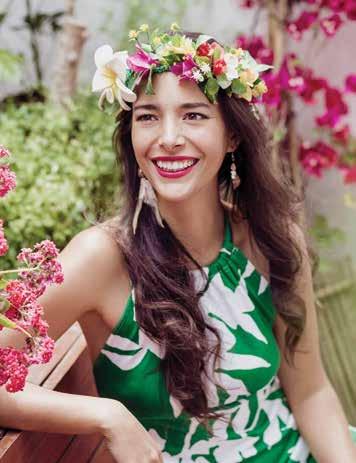
Beethovenfest–Mahani Teave
4/6 & 7
This annual festival features Highland games and dancing, entertainment and Scottish food. Jefferson Elementary School, (808) 741-2749
4/12 & 13
Initially known as Project Soul, the R&B funk icon group now known as Con Funk Shun, has been pleasing fans for over fifty years. Blue Note Hawaii, (808) 777-4890
4/12–8/18
Fashioning Aloha traces the evolution of aloha wear, from the 1930s to the present. Garments are paired with their textile motifs’ source materials from the museum’s collection, such as kapa (bark cloth), Japanese kimono and a Chinese dragon robe. Honolulu Museum of Art, (808) 532-8700
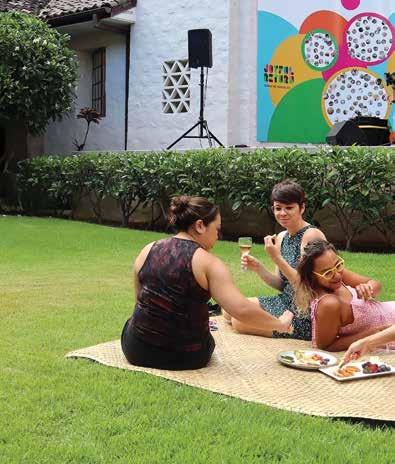
4/13
Two-time Emmy and GRAMMY Awardwinning comedian Kathy Griffin performs her latest material. Hawai‘i Theatre Center, (808) 528-0506
4/19
Sasha Colby is a drag performer, actress, dancer, trans advocate and activist, and the Season 15 crowned winner of RuPaul’s Drag Race, making her the first Native Hawaiian trans person to ever win on the show. Hawai‘i Theatre Center, (808) 528-0506
4/19 & 20
A weekend of family fun with games, rides, crafts, keiki activities and food. Proceeds from the fair benefit students’ travel opportunities. Noon to 10 p.m. ‘Iolani School, (808) 949-2339
4/20
An Earth Day festival featuring activities, workshops, presentations and performances with scientists, cultural practitioners and community organizers on the front lines of research and conservation in Hawai‘i. Bishop Museum, (808) 847-3511
4/20
Waimea Valley is offering several volunteer service projects and fun activities, live music, hālau performance, Hawaiian games and food for sale. Waimea Valley, waimeavalley.net

HAPASYMPHONY FEATURING
ROBERT CAZIMERO
4/20
Grammy-nominated and 25-time Nā Hōkū Hanohano winner, Robert Cazimero reunites with Hawai‘i Symphony Orchestra to perform some of his greatest hits and new tunes. Hawai‘i Theatre Center, (808) 528-0506
LARRY CARLTON: FINAL WORLD TOUR
4/20 & 21
GRAMMY Award-winning jazz guitarist Larry Carlton performs. Blue Note Hawaii, (808) 777-4890
H o MA FAMILY SUNDAY
4/21
HoMA offers creative activities for keiki of all ages, community-focused programming and entertainment. Free museum admission for local residents. 10 a.m. to 6 p.m. Honolulu Museum of Art, (808) 532-8700



WAITIKI 7
4/21
Pioneering Hawai‘i-born, Rapa Nui pianist Mahani Teave joins Hawai‘i Symphony Orchestra for Beethoven’s Piano Concerto No. 1, Symphony No. 5, and Iman Habibi’s Beethoven-inspired Jeder Baum Spricht (Every Tree Speaks). Hawai‘i Theatre Center, (808) 528-0506
4/26 & 28
Four young Parisians dedicate their lives to art and love. Hawai‘i Opera Theatre’s production features an all-Asian principal cast that celebrates the diversity of talent the opera world has to offer. Waikīkī Shell, (808) 768-5400
4/27
This annual festival explores Hawai‘i’s curious love for the canned meat. Food kiosks, live entertainment stations and Hawaiian craft vendors line Kalākaua Avenue. Free. Waikīkī, spamjamhawaii.com
4/28
An annual celebration of Kailua town with food, shopping, arts and crafts, plant sales and keiki activities. Kailua, LKOC.org
4/29
Hawai‘i Symphony Orchestra presents an evening with Michael Giacchino conducting his music from the made-inHawai‘i television show LOST along with video clips and special guests. Hawai‘i Theatre Center, (808) 528-0506
MAY
5/1
The city’s annual Lei Day Celebration, begun in 1928, features the Lei Day queen or king and their court, entertainment, hula, food vendors and, of course, some of the most exquisite lei in the world. Kapi‘olani Park, (808) 768-3003

Waikīkī SPAM JAM
HAWAIIAN AIRLINES
MAY DAY 2024
5/1
The Brothers Cazimero with Keauhou, the 17-time Nā Hōkū Hanohano Award-winning group, perform live on Bishop Museum’s Great Lawn. Bishop Museum, (808) 847-3511
MOTHER’S DAY BRUNCH WITH FRANK DELIMA
5/12
Frank DeLima is one of Hawai‘i’s most popular and beloved comedians, turning current events, fads, attitudes and people into musical parodies. Blue Note Hawaii, (808) 777-4890
5/13–16
The first stop of the inaugural Adaptive Surfing Professionals World Championship Tour with a range categories. Waikīkī Beach, (808) 236-4200
5/19
Athletes from around the world converge at Magic Island in Ala Moana Beach Park for olympic, sprint and youth triathlons as well as a 10k run. Ala Moana Beach Park, honolulutriathlon.com
5/19
HoMA offers creative activities for keiki of all ages, community-focused programming and entertainment. Free museum admission for local residents. 10 a.m. to 6 p.m. Honolulu Museum of Art, (808) 532-8700
5/19
Pianist Michelle Cann joins Hawai‘i Symphony Orchestra for Florence Price’s Piano Concerto, Margaret Bond’s Montgomery Variations , and Shostakovich’s Symphony No. 5. Hawai‘i Theatre Center, (808) 528-0506

5/24 & 25
The WAITIKI 7, an exotica septet of jazz, Latin and chamber musicians, returns to Waikīkī’s famed House Without a Key restaurant. Halekulani Hotel, (808) 518-2019
5/24 & 25
Catherine Cohen is best known for her hit Netflix comedy special The Twist ... ? She’s Gorgeous , and was named Best Newcomer at the Edinburgh Comedy Festival in 2019. Blue Note Hawaii, (808) 777-4890
5/25
EDM artist INZO performs along with special guests Tape 8 and additional support from Dreamers Delight and Blookah. The Republik, (808) 941-7469
5/27
This annual ceremony brings together more than fifty thousand residents and visitors, who set afloat more than six thousand candlelit lanterns bearing remembrances and prayers. 6:30 p.m. Magic Island, Ala Moana Beach Park, lanternfloatinghawaii.com
5/30–6/30
Exploring the concepts of aloha and kuleana (responsibility), this trilogy of plays from Alani Apio follows three cousins raised in their family’s beachside home and their struggle to care for the land. Kumu Kahua Theatre, (808) 536-4441
5/31 & 6/1
American pop musician Taylor Dayne’s career spans three decades, starting with her debut single “Tell It to My Heart” in 1987. Blue Note Hawaii, (808) 777-4890
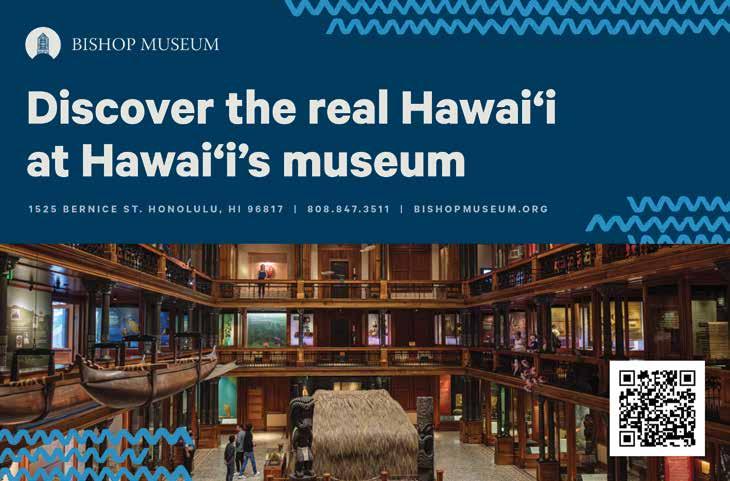

Complete your Pearl Harbor experience. The USS Missouri is no ordinary ship—it is America’s most historic battleship. Home to 2,700 sailors, nine 66-foot-long guns, 1,220 projectiles and a deck big enough to host a surrender ceremony presided over by General Douglas MacArthur. Ask about the new Captain’s Tour and Chief Engineer’s Tour. Shuttle service from the Pearl Harbor National Memorial visitors center included with admission.

(808) 455-1600
ussmissouri.org

Kaka‘ako, Pearlridge Center, Kailua Town, Hale‘iwa
Immerse yourself in local food culture at any one of our Farmers Markets. Taste the true Hawai‘i. Experience our local farmers, culinary masters and artisans, locally-grown produce and tropical fruits and vegetables. Come hungry! Leave happy. Our chefs cook healthy, Island-style grindz. Need a gift? Our local artisans have you covered. Kaka‘ako (Sat), Pearlridge (Sat), Kailua Town (Sun), Hale‘iwa (Thurs).
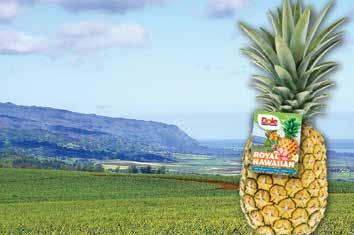
Bring home a bite of paradise! The exotic pineapple has been associated with Hawai‘i & the DOLE® brand for over 100 years. The fertile, volcanic soils of O ’ahu are kissed with Hawaiian sunshine, warm tropical rain and gentle tradewinds, creating the sweeter, juicier DOLE® Royal Hawaiian® Pineapple.

(808) 847-3234 dolefruithawaii.com


Turn any space into an escape. With Jules & Gem Hawai‘i products, our goal is to bring you back to happy memories of Hawai‘i and bring paradise to wherever you are. We pride ourselves on being locally handmade, right on O‘ahu. Shop our products at multiple resorts and retailers on O‘ahu, Kaua‘i, Maui and Hawai‘i Island—or get them shipped straight to your door by shopping online!
(808) 772-4060
julesandgemhawaii.com

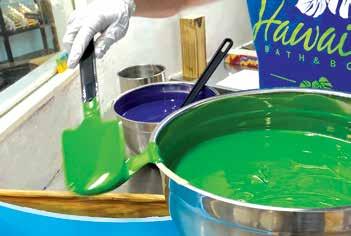
Native Hawaiian lifestyle company creating jewelry, clothing and home decor that perpetuates Native Hawaiian culture through modern fashion. Laha’ole shares stories and original designs inspired by Native Hawaiian flora and oral history. Our pieces reflect the island’s beauty and culture. Stand out with meaningful jewelry that shares the spirit of Hawai’i, handcrafted with love.
(808) 349-7794
lahaolehawaii.com

67-330 Kamehameha Highway, Hale‘iwa
Experience the “fresh-roasted difference” of Hawai‘i macadamia nuts at the North Shore Macadamia Nut Company. Established in 1971, this family-operated macadamia nut farm is located at the north end of Hale‘iwa town. Open daily from 10 a.m. to 5 p.m. You can enjoy free samples of the freshest Island macadamia nuts and premium coffees, available for purchase at the best prices!

(808) 637-4733
northshoremacnut.com
Watch our master soap maker when you visit North Shore Soap Factory! Come for the soap, stay for the stamping. Customize your bar at our stamping station. Book a Behind-the-Scenes Tour* to see how we handcraft Hawaiian Bath & Body® soaps and skin care products. Local art, gifts and more. Find us in the big, coneshaped building! 67-106 Kealohanui Street, Waialua
(808) 637-8400
northshoresoapfactory.com

819 Moowaa St., Ste. 202, Honolulu
Fresh Hawaiian Lei - Inspired by the tradition and custom of lei giving in Hawai‘i, we create lei using years of tradition from Thailand and the Fiji Islands. An assortment of standard, deluxe or signature prestige premium lei using Hawaiian patterns are available at our factory and at Hale O Na Lei at 2169 Kalia Rd. in Waikīkī. Shipping within Hawai‘i or to the U.S. Mainland also available.
(808) 847-1107

Kapahulu, Kalihi, Pearlridge, ’Ewa
Family owned since 1961, Rainbow Drive-In is known for their generous portions of simple, hearty Hawai‘i comfort food. Stop by one of four locations for the best Loco Moco or a delicious plate lunch. After enjoying a famtous Slush Float for dessert, leave with one of our exclusive logo-emblazoned merch items from the Rainbow Tiki shop.
(808) 737-0177

Ultimate Circle Island Tours prides itself in providing custom client relationships through our 16-Location boutique family-style tours. We are one of only a few Oahu circle island tours that include the chance to swim with the noble Hawaiian green sea turtles on Oahu’s North Shore. Come with us to enjoy a full day of exploring Oahu.

685 Auahi St Building 2 Suite 121, Honolulu
Waikiki, Hawaii ultimatecircleislandtours.com

(808) 460-6163 rainbowdrivein.com

59-864 Kamehameha Highway, Hale‘iwa
Waimea Valley is a wahi pana (storied place) deeply rooted in Hawaiian culture. Today Waimea is home to six cultural sites and 5,000 unique plants from all over the world. Allow the wonders of Waimea to speak to you as you walk through this place of healing. Experience the tranquility and the sites that hark back to a bygone era in Hawai‘i’s history.
(808) 376-4800
Laidback yet refined, vein at KAKA‘AKO features a modern Mediterranean with Japanese influence created by Executive Chef Dell Valadez. The dishes, such as the Lamb “Scottadito” with Pickled Plum Tapenade and Pistachio pasta topped with Prosciutto di Parma, are intriguing in descriptions and enticing in flavor, making vein the ideal locale for a unique and exceptional dining experience. veinatkakaako.com

(808) 638-7766
waimeavalley.net



WILDLIFE WEDNESDAYS
Wednesdays
Join naturalists from the Hawai‘i Wildlife Discovery Center every Wednesday and learn about humpback whales, monk seals and more Maui wildlife. 10 a.m. to noon. Whalers Village, (808) 661-4567
JOHN CRUZ
“ISLAND STYLE” SERIES
First and Third Wednesdays
Nā Hōkū Hanohano Award-winning singer-songwriter John Cruz has built his career telling stories through songs about everyday people and experiences. His ongoing Island Style series celebrates the ties that bind. 7 p.m. ProArts Playhouse, proartsmaui.org
Fridays
Locally grown produce and products from East Maui. Free. 65-and-over shopping starts at 2:30, general admission from 3 to 5 p.m. Hāna Town Center, (808) 378-0084
Third Fridays
A free monthly concert highlighting Hawai‘i’s homegrown talent. Queen Ka‘ahumanu Center, (808) 877-3369
KĪHEI FOURTH FRIDAY
Fourth Fridays
A monthly community street party with food trucks, entertainment, crafters and kids’ games. 6 to 9 p.m. Free. Azeka Shopping Center, kiheifridays.com
Saturdays
Locally grown produce, fish, prepared food and products. Free. 7 to 11 a.m. Kulamalu Town Center, (808) 572-8122
QKC KEIKI CLUB
Third Saturdays
Monthly keiki activities focused on Hawaiian language and culture with Luana Kawa‘a of Morning Mana‘o at the QKC keiki play area. Enter to win giveaways and enjoy family-friendly festivities. 10 to 11 a.m. Queen Ka‘ahumanu Center, (808) 877-3369

Wanda Sykes Please & Thank You Tour
Sundays
An evening marketplace with local food and product vendors and live entertainment. Free. 4 to 8 p.m. Kahului Shopping Center, (888) 948-6382
Last Sundays
Beginner and experienced performers improvise live theater on stage. 6:30 p.m. ProArts Playhouse, proartsmaui.org
Through 4/7
The bighearted musical extravaganza that won six Tony awards including Best Musical, a GRAMMY for Best Musical Theatre album and London’s Olivier Award for Best Musical. ProArts Playhouse, proartsmaui.org
SOLO ART EXHIBITION 2024
Through 5/17
Maui-based artists Sachelle Dae and Zenobia Lakdawalla will present two concurrent solo exhibits. Hui No‘eau Visual Arts Center, (808) 572-6560
WANDA SYKES PLEASE & THANK YOU TOUR
4/5
Emmy-winning, fourteen-time nominated stand-up comic, writer, actress and producer Wanda Sykes performs her latest material. Maui Arts and Cultural Center (MACC) Castle Theater, mauiarts.org


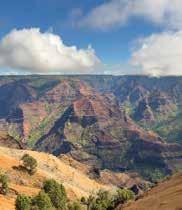



4/21
Full marathon, half marathon, 10K & 5K courses along West Maui’s best beaches. Kaanapali Parkway, mauimarathonsignup.com
5/1
Hosted by the Maui Historical Society, this festival celebrates the art of lei making with cultural workshops, live Hawaiian music, local Maui entertainment and more. 10 a.m. to 2 p.m. Bailey House, Wailuku, (808) 244-3326
5/5
Music legend James Taylor returns to Maui with his All-Star Band for a special concert outdoors under the stars. MACC, mauiarts.org
5/11
Artisans and crafters, food, live entertainment, keiki activities, a silent auction, a rummage sale and a plant sale to benefit Seabury Hall’s financial aid program. 9 a.m. to 3 p.m. Seabury Hall, seaburyhall.org
5/12
Maui’s only all-women’s race benefits the Kelly Watanabe Scholarship Fund at UHMC. University of Hawai‘i Maui College, virr.com
5/17–26
Musicians from around the world perform in some of Maui’s most beautiful and historic sites. Various locations, mauiclassicalmusicfestival.org
MAUI BREWERS FESTIVAL
5/18
Beer tastings from the best craft breweries in Hawai‘i and beyond, live music, a home-brew competition and appetizers from Maui restaurants and food trucks. MACC, mauiarts.org
5/18
Free multicultural entertainment, handson activities and crafts for keiki, STEM demonstrations. 10 a.m. to 1 p.m. Queen Ka‘ahumanu Center, mauimatsuri.com
MAUI MATSURI FESTIVAL
5/25
A Japanese festival offering free entertainment, crafters, food booths and trucks, contests, craft activities, exhibits, giveaways and ending with a obon dance. 3 to 9 p.m. University of Hawai‘i Maui College, mauimatsuri.com
Maui Brewers Festival

Olinda Road, Makawao, HI 96768
Anuhea Flowers is proud to be a female-owned-and-operated small business. We are located on a 12-acre farm in Upcountry, Maui where we grow, prepare, and ship all our protea flowers. We offer long-stem gift boxes, arrangements, and wreaths harvested fresh and made with Aloha. Year-round, we sell and ship our farmfresh flowers throughout Hawai’i and the United States.
anuheaflowers.com (808) 572-6877
Located in Upcountry Maui at the historic Kaluanui Estate, Hui No‘eau Visual Arts Center is a nonprofit, community arts center offering art classes, cultural workshops, exhibitions, and events. Explore the 100-year-old Kaluanui home, enjoy artwork by local artists, or take a self-guided tour of the scenic 25-acre grounds. Supported in part by the County of Maui.



(808) 572-6560
huinoeau.com





APRIL
Mondays
A one-hour nature walk through an oldgrowth Hawai‘i rainforest on an easy loop trail. Walkers are introduced to the native plants and birds of Kīlauea volcano. Free. 9:30 a.m. Volcano Art Center’s Niaulani Campus, (808) 967-8222
Thursdays
Observe the traditional art of baking Portuguese bread in a large wood-fired stone oven, or forno. Bread sales begin at 1 p.m. Program begins at 10 a.m. Kona Historical Society, (808) 323-3222
Fridays
Take a walk back in time to 1912 and meet the founder of the Hawaiian Volcano Observatory, Thomas A. Jaggar, at the edge of Kīlauea volcano. Free. 10 a.m. to noon. Hawai‘i Volcanoes National Park, (808) 985-6000
Second and Fourth Fridays
Live music, food trucks and dozens of local vendors with Hawai‘i Island products, artwork and other artisanal goods. 4 to 8 p.m. Kings’ Shops in Waikoloa, (808) 886-8811
First Saturdays
Craft and art vendors, keiki entrepreneurs, fresh food, ‘ohanacentered outreach, sustainable-living resources and live music. Free. 9 a.m. to 2 p.m. Kona Grill House, (808) 960-7728
Second Saturdays
Crafters and makers selling gifts, art, crafts and food. 9:30 a.m. to 3:30 p.m. Kona Commons Shopping Center, (808) 854-1439
3/31–4/6
A week of Hawaiian cultural events centered around Hawai‘i’s most prestigious hula competition. Exhibits, music, arts and crafts, as well as the Miss Aloha Hula, kahiko (ancient) hula and ‘auana (modern) hula competitions. Edith Kanaka‘ole Stadium, merriemonarch.com
4/3–6
Held in conjunction with the Merrie Monarch Festival, this event offers daily Hawaiian entertainment, artisans, crafters and food vendors from around the Islands and across the Pacific. Free admission. Afook-Chinen Civic Auditorium, merriemonarch.com
ARTS, CRAFTS & FOOD FESTIVAL
4/4–6
An annual festival during Merrie Monarch Week that celebrates Hawai‘i’s cultural diversity with music, entertainment, performances and food. Free. 9 a.m. to 4 p.m. Nani Mau Gardens, (808) 981-0518
QUATUOR AGATE
4/6
The award-winning French string quartet performs pieces by Mozart, Shostakovich and Dvořák. Kahilu Theatre, (808) 885-6868
4/13
Hula and chant on a sacred site near the Volcano Art Center with Hālau o Maunalei. Call ahead to confirm the monthly event. 10:30 to 11:30 a.m. Volcano Art Center Gallery, (808) 967-7565
KAHILU DANCE NIGHT
4/13
Greg Shirley’s Big Swing offers listeners and dancers alike everything from Lindy Hop and East Coast Swing to Salsa and Cha Cha. Kahilu Theatre, (808) 885-6868



4/18–5/26
An annual exhibition hosting artworks by students enrolled in kindergarten through high school in Waimea. Simperman & Hāmākua Galleries, kahilu.org
4/21 & 5/19
Ali‘i Drive transforms into a festive, pedestrian-only marketplace filled with music and art. At 4 p.m. there is a free Hawaiian music concert at Hulihe‘e Palace. 1 to 6 p.m. Kailua-Kona, (808) 936-9202
4/25
A celebration of Hawaiian culture with music, crafts, games, food and a silent auction. 10 a.m. to 4 p.m. Laupāhoehoe Point Beach Park, laupahoehoemusicfestival.org
4/26 & 27
The festival includes farm tours, agricultural seminars, demonstrations by pastry experts and a gala with sweet and savory stations, live entertainment, dancing and a silent auction. Waikoloa Beach Marriott Resort & Spa, bigislandchocolatefestival.com
4/27
An epic mele and hula extravaganza featuring some of the most talented māhū (trans) artists in Hawai‘i today: Hinaleimoana Wong-Kalu, Kuini & Kaumaka‘iwa Kanaka‘ole. Kahilu Theatre, (808) 885-6868
MAY
5/1
Learn techniques and protocol from master lei makers with plant materials provided by the Volcano Art Center Gallery, accompanied by live music. Free with entrance fee. VAC Gallery at Hawai‘i Volcanoes National Park, (808) 967-8222
KAMUELA
PHILHARMONIC: POPS!
5/5
A concert of famous classical works intermixed with selections from the stage and silver screen that will have every generation saying, “I Know That One!” Kahilu Theatre, (808) 885-6868
5/11
This bimonthly series highlights local musicians at the Dietrich Varez Hall surrounded by native Hawaiian rainforest. May’s concert is themed “Shake, Rattle, and Roll.” Volcano Art Center’s Niaulani Campus, (808) 967-8222
5/11
Kona Orchid Society’s annual sale features a variety of flowers and plants, crafts and gifts. Free. 9 a.m. to 2 p.m. Old Kona Airport Park Event Pavilion, konaorchidsociety.org
5/11
Hula and chant on a sacred site near the Volcano Art Center with Pāhoa Middle School. Call ahead to confirm the monthly event. 10:30 to 11:30 a.m. Volcano Art Center Gallery, (808) 967-7565
5/18–27
Honoka‘a residents celebrate the town’s ranching and agricultural history with paniolo (cowboy)-themed activities, including a block party and a rodeo during Memorial Day weekend. Honoka‘a, honokaawesternweek.org
5/25
Hawai‘i’s beloved kumu hula, singer, songwriter and entertainer, Robert Cazimero, will continue his 38-year tradition of performing live in Waimea with an evening of music, hula and storytelling. Kahilu Theatre, (808) 885-6868
5/26
A free community event featuring a lantern floating ceremony to honor lost loved ones, live music, food and drinks. 3:30 to 7:30 p.m. Reeds Bay Beach, Hilo, hawaiicarechoices.org

45-3279 Mamane Street, Honoka‘a

University of Hawai‘i at Hilo 600 ‘Imiloa Place, Hilo
Embark on a uniquely Hawaiian voyage at ‘Imiloa in Hilo! Immerse yourself in our cutting-edge Planetarium, traverse our interactive Exhibit Hall, and wander through our lush outdoor native garden. ‘Imiloa is ideal for family visits, educational experiences, farm-to-table dining, and unforgettable events. Inquire about our membership discounts to make the most of your journey!


177 Kaumana Drive, Hilo
(808) 775-1821
Stop by “The Nuthouse” and see what’s crackin’! Ā hualoa Family Farms grows, processes, and produces delicious 100% Hawaiian macadamia nuts and 100% H ā m ā kua coffee in Historic Honoka‘a town, the gateway to Waipi‘o Valley. Come in for free samples, relax on the l ā nai, enjoy a cup of coffee and take home your favorite macadamia nut flavor. See you at The Nuthouse! ahualoafamilyfarms.com
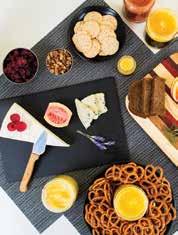

Liko Lehua gourmet butters are handcrafted in small batches with fresh fruit from our family farm. Visit our Café in the bright yellow building above Hilo town for a burger and milkshake drizzled with Lilikoi Butter. Ask to sample all seven delicious flavors. Gift a jar to your ‘Ohana. Liko Lehua is “spreading Aloha across the world” since 1996!

(808) 315-8484
@likolehuacafe
(808) 932-8901
imiloahawaii.org

Volcano, Hawai‘i
Volcano Art Center promotes, develops and perpetuates the artistic, cultural and environmental heritage of Hawai’i through art and education. Celebrate the Past, Present and Future of the Arts as VAC turns 50 in 2024! Become a member to experience exhibits, classes, concerts and ongoing signature programs including Hula Arts At Kīlauea, the Cultural Connections Initiative and Free Guided Forest Tours.
(808) 967-8222
volcanoartcenter.org



Tuesdays, Thursdays and Saturdays
Walking tours through the Waimea Plantation Cottages and the Waimea Sugar Company “camp” houses, which date from the turn of the twentieth century. Waimea Town, (808) 337-1005
Wednesdays
A weekly farmers market featuring fruits, vegetables, flowers and a cooking demonstration. 3:30 to 6 p.m. The Shops at Kukui‘ula, (808) 742-9545
Wednesdays
A weekly gathering with performances by local musicians and an assortment of handmade jewelry, crafts, art and more. Free. 1 p.m. to 5 p.m. Princeville—Makai Lawn, (808) 318-7338
Thursdays
Everything from fresh fruits and vegetables to noodles, spices and treats, along with jewelry, clothing, art and more. Hula performance at 12:30 p.m. every week. Free. 10 a.m. to 2 p.m. NTBG South Shore Visitor Center, (808) 742-2623
ALOHA FRIDAY ART NIGHTS
Fridays
Each Friday night Kress Street fills with live art demonstrations. From music to murals, artists share their craft with the community. Kress Street, Līhu‘e, (808) 652-1442
HANAPĒPĒ ART NIGHT
Fridays
Hanapēpē town comes to life with food trucks, street performers, live music and opportunities to talk story with local artists and gallery owners. Free. 5 to 8 p.m. Hanapēpē, hanapepe.org
OLD KAPA‘A TOWN ART WALK
First Saturdays
Food vendors, crafts and treasures from local artisans, and services from local nonprofit organizations along with live multicultural performances. Old Kapa‘a Town, kbakauai.org
HANALEI FARMERS MARKET
Saturdays
Locally grown fruits and vegetables from Kaua‘i’s North Shore along with freshsqueezed juices, honey, fresh-baked goods and arts and crafts. 9 a.m. for seniors, 9:30 a.m. to noon for general admission. Hale Halawai ‘Ohana O Hanalei, (808) 826-1011
ANAHOLA NIGHT MARKET
Last Saturdays
Live music, food and handmade products from over twenty local vendors. 4 to 9 p.m. Anahola Marketplace, (808) 320-7846
PRINCEVILLE FARMERS & ARTS MARKET
Saturdays
Farm-fresh fruits and veggies, along with artisans, vintage treasures, live music and more. 9:30 a.m. to 12:30 p.m. Princeville Community Center, bloomandprosperhawaii.com
ALAKOKO PLANT SWAP
Sundays
This weekly market offers plant lovers the chance to buy, sell or trade a variety of greenery. Free. 10 a.m. to 1 p.m. Alakoko Shop, (808) 652-1442
First Sundays
An outdoor market showcasing products from artisans, crafters, food trucks, bakers and vintage vendors. 9 a.m. to 2 p.m. Kaua‘i Veterans Center, (808) 635-4314
WAILUA BAY CREATORS FAIR
Fourth Sundays
Artisan goods, clothing, accessories, handsewn items, jewelry, photography, wood carvings, home decor and more accompanied by live music and food vendors. 8:30 a.m. to 1 p.m. Hilton Garden Inn, Kaua‘i, Wailua Bay, (808) 746-2162
Through 4/14
As truths and lies intertwine, this gripping drama challenges our perceptions and forces us to question the boundaries of our own lives. Puhi Theatrical Warehouse, (808) 245-7700
4/6
NHRA drag racing featuring some of the state’s fastest cars. 2 p.m. Kauai Raceway Park, dragracekauai.com
4/13
Crafts, gifts, food trucks, baked goods, live entertainment and more. Featuring more than fifty vendors each month. Free. 4 to 8 p.m. Kress Street, Līhu‘e, (808) 652-1442
4/14
This monthly festival features live music, pottery, paintings, apparel, jewelry and more than forty artisans. Free. 4 to 8 p.m. Princeville Shopping Center, (808) 635-2572
4/19-21
Leftover Salmon is an American jam band with a signature blend of bluegrass, rock, country and zydeco. Anaina Hou Porter Pavilion, anainahou.org
4/20
Featuring over thirty beers, dishes from local restaurants, live music and games. 2 to 6 p.m. Kauai Philippine Cultural Center, kauaibrewersfestival.com

5/1
Kaua‘i Museum holds its annual lei contest, followed by a silent auction to bid on the winning designs, giveaways and more. 10 a.m. Royal Sonesta Kaua‘i Resort, (808) 245-6931
5/4
NHRA drag racing featuring some of the state’s fastest cars and a special 4x4 Truck-off. Track opens at 9 a.m. with qualifying races at 2 p.m. Kauai Raceway Park, dragracekauai.com
5/10–26
Suffering from a disease that causes her to age four and a half times as fast as normal, a teenage girl must also navigate a dysfunctional family, high school and love. A unique and often hilarious perspective on life. Puhi Theatrical Warehouse, (808) 245-7700
5/11
Crafts, gifts, food trucks, baked goods, live entertainment and more. Featuring more than fifty vendors each month. Free. 4 to 8 p.m. Kress Street, Līhu‘e, (808) 652-1442
5/11
A 34-mile coastal paddling relay for OC1 and OC2 canoes, surf skis and standup paddleboards starting at Wailua Beach Park and finishing at Salt Pond Beach Park, with entertainment, cultural activities and an awards party. Līhu‘e, kauaihoewaa.org
5/12
This monthly festival features live music, pottery, paintings, apparel, jewelry and more than forty artisans. Free. 4 to 8 p.m. Princeville Shopping Center, (808) 635-2572

4900 Kuawa Rd, Kīlauea
A culinary experience unlike any other, Common Ground’s Farm and Food Experience showcases the very best of Hawai‘i’s ingredients. Enjoy a tour through our regenerative food forest followed by an incredible meal prepared by our chefs, featuring 100% local ingredients. Spend an evening on our magical campus. Enjoy the beautiful farm setting and a delicious one of a kind meal.

(808) 828-6368 commongroundkauai.com

5/26
A 15.75-mile USA Cycling-sanctioned hill climb race along the Waimea Canyon rim up to the Kanaloahuluhulu Meadow in Kōke‘e State Park. Kekaha, pedaltothemeadow.com

Raw denim, leather boots, palm leaf hats, snap button palaka, leather saddles, waxed ropes and horse shampoo. While you’re here trying on new boots, discover our rare vinyl records, vintage mu‘umu‘u, forged garden tools and NATO fuel cans. 4427 Papalina, Kalāheo


4-1400 Kuhio Highway, Kapa‘a
At Kela’s Glass Gallery, it’s all about the glass art. See for yourself the stunning Color Changing Jewelry by the owner Mimi. This impressive gallery features the works of over 150 fine glass artists. Apparently the specialization works. Kela’s Glass Gallery won the prestigious Top Retailer Award from NICHE Magazine voted on by over 10,000 American artists.
(808) 822-4527
glass-art.com

Watch a curated selection of films and series on the in-seat media player or Hawaiian Airlines app.
4-1316 Kūhiō Hwy, Kapa ‘a
A celebration of the simple, the beautiful, the unique. KIKO honors the handmade over the mass-produced, natural over glitzy, useful over useless, fair trade over exploited, one-of-a-kind over you’veseen-it-everywhere. Clothing, art, jewelry, books, housewares & art supplies in the heart of old Kapa ’a Town. A little bit of everything. @kikokauai
(808) 822-5096

1-3529 Kaumuali‘i Highway Unit 2B, Hanapēpē
Salty Wahine Gourmet Hawaiian Sea Salts is a family-owned Kaua ‘ i Made Company that specializes in Kosher Hawaiian Sea salts, seasonings, and tropical sugars using fruit infusions like mango, coconut, guava, passionfruit, dragonfruit, and pineapple. All products are made by hand with Aloha in our Salty Wahine commercial kitchen/factory in Hanap ē p ē , Kaua ‘ i.
(808) 378-4089
saltywahine.com

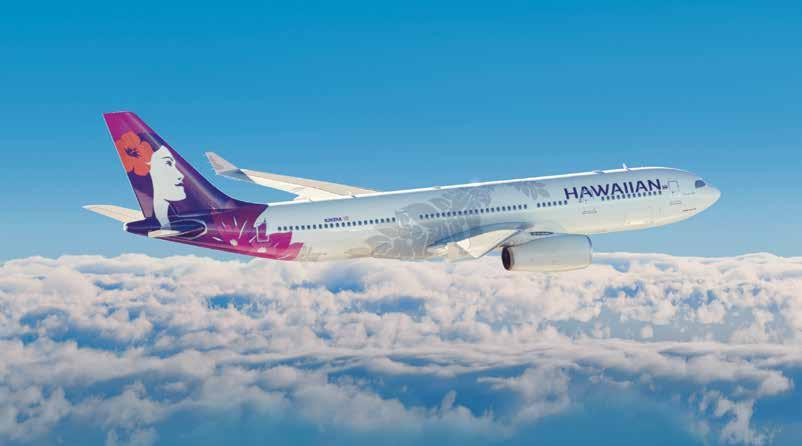
E nanea i kā mākou ho‘okipa, a e luana i ka lele ‘ana!
Please enjoy our hospitality, and have a relaxing flight!
In Hawaiian culture, mea ho‘okipa means "I am your host." This phrase expresses the spirit of hospitality you'll find on our flights, whether you're traveling to the Neighbor Islands, between Hawai‘i and North America or within the Asia-Pacific region. If there is anything that we can do to make your flight more enjoyable, please don't hesitate to let us know.
136 / In-Flight Meals
137 / Streaming Entertainment on A321neo Aircraft
138 / In-Flight Snacks, Souvenirs and Beverages
140 / Terminal Maps
142 / HawaiianMiles Partners
144 / Route Map
146 / The ‘Ohana Pages
It’s true. We’re one of the only airlines left in the country to serve you a complimentary meal at mealtime in the Main Cabin. You’ll find Hawai‘i-inspired meals on select flights to and from Hawai‘i, always served with our unique brand of Hawaiian hospitality.


Above top: Wade Ueoka and Michelle Karr-Ueoka
Bottom: Chuck Furuya
Left to right: Chef Eric Oto of Hoku’s at the Kahala Resort and Spa, Chef Robynne Maii of Fete Hawaii, Chef Dell Valdez of vein at Kaka‘ako, Executive Chefs Wade Ueoka and Michelle Karr-Ueoka of MW Restaurant, Chef Chris Kajioka of Miro Kaimuki and Chef Jason Yamaguchi of Mugen Waikiki.
Hawaiian Airlines’ in-flight service shares the sights, sounds and tastes of Hawai‘i, and when it comes to our First Class meal service, that means exciting, varied Pacific Rim cuisine with our Featured Chef Series. This esteemed collaboration showcases some of Hawai‘i’s most dynamic chefs creating menus for meals served in our forward cabin.
The Featured Chef Series is overseen by Hawaiian Airlines Executive Chefs Wade Ueoka and Michelle Karr-Ueoka.
Sit back and enjoy Hawai‘i’s vibrant food culture and our distinct onboard experience.
Executive Chefs Wade Ueoka and Michelle Karr-Ueoka opened MW Restaurant in Honolulu in 2013. Their cuisine combines inspirations from travels around the world with Hawai‘i’s culinary traditions and local bounty. To sample MW’s latest creations visit their new location at 888 Kapi‘olani Boulevard in Honolulu.
MWRestaurant.com
Chuck Furuya has a passion for the world’s oldest fermented beverage and holds the distinction of becoming only the tenth person in the United States to pass the rigorous Master Sommelier examination, in 1988. You can find Chuck at Chuck Furuya Uncorked on YouTube.

Our A321neo Aircraft are now being equipped with Starlink Internet. It is fast, free internet available for everyone right when you step on board. Switch to Airplane Mode and
• Connect to “ Starlink WiFi on HawaiianAir ”
Please note: Rollout of Starlink Internet across our Aircraft is currently underwaynot all A321neo aircraft include this service. Look for the Starlink In-Flight WiFi logo at the door to know if your aircraft is equipped with this new service.
The following is not permitted with our in-flight internet service:
• No voice or video calls
• No Livestream broadcasting
• No viewing obscene/offensive content
Guests on our A321 aircraft are also able to stream complimentary entertainment on their personal electronic devices.
IN THE HAWAIIAN AIRLINES APP ˙
1. Once onboard:
• Switch to Airplane Mode
• Connect to “Movies on HawaiianAir” WiFi network
2. Open the Hawaiian Airlines app:
• Select “More” » Select “In-Flight Entertainment”
IN A BROWSER ˙˙
1. Connect to “Movies on HawaiianAir” WiFi network
2. Open browser and type in URL: HawaiianAirWifi.com
3. Choose from the menu and enjoy!
˙ Supported on IOS 13+ and on Android 8.0+
˙˙ Internet Explorer and Edge browsers are not supported at this time
Hawaiian Airlines offers DJ-hosted, curated audio programming devoted to musical styles from across the globe, ranging from award-winning Hawaiian music to jazz and K-Pop.*
FEATURED CHANNELS INCLUDE:
Paradise Lounge
Happy hour music with an Island twist, served up by Raiatea Helm and a host of others.
‘Ukulele Wizards
A celebration of Hawai‘i’s iconic instrument and those who use it to make musical magic, including Taimane Gardner and Andrew Molina.
Island Favorites
From the latest award-winning songs to the all-time classics, Island Favorites surveys the best in Hawaiian music.
Slack Key Serenity
Darin Leong is among the kī ho‘alu masters who present varied interpretations of the Hawai‘i-born slack-key guitar style.
*Available only on A330 and A321neo aircraft.


Noho Home x Hawaiian Airlines
We are proud to partner with Noho Home by Jalene Kanani on the limited edition Leihōkū Collection. Products are available while supplies last.
Products may also be available at NohoHomeHawaii.com. Prices may vary.

Travel Blanket ˙˙
Reusable Cleaning Cloths (3)
Chopsticks (5 pairs)
Travel Wrap


Keepsake blanket, popular local snacks, souvenirs and sundries are available from the Pau Hana Snack Cart. Cabin crew will advise when the cart is heading down the aisle on domestic flights or is open in the galley on Australia and New Zealand flights.
Selections and quantities are limited and may vary. To print receipts of in-flight purchases, visit HawaiianAirlines.com/receipts.
Popular Local Snacks
Mananalu Water in Keepsake Hawaiian Airlines Reusable Aluminum Bottle, 22 oz ˙˙
Hawaiian Chip Company Taro and Sweet Potato Chips
Island Princess Caramel Macadamia Nut Popcorn
Kona Chips Furikake Chips
Samurai Furikake Popcorn
Snack Packs ˙
Made in Hawai‘i Snack Sampler K
Choco Caramel Popcorn, Choco Mochi, Lightly Salted and Maui Onion Macadamia Nuts, Mele Mac
Classic Snack Box GF Crackers, Chickpeas, Turkey Stick, Hummus, Gummies, Sweet Treat
Keiki (Child) Snack Box GF Cheese Puffs, Granola Minis, Turkey Stick, Applesauce, Gummies, Sweet Treat
‘Ono Snack Box GF Salami, Cheese Spread, Dried Fruit, Olives, Crackers, Sweet Treat
Cheese Tray with Crackers and Dried Fruit
Classic Snacks
M & M’s Peanut
Maruchan Cup Ramen Chicken
Pringles K
Noho Home Travel Blanket ˙˙
Ear Buds with Hawaiian Airlines Zipper Case
Hawaiian Airlines Blanket and Pillow
Juices
Passion-Orange-Guava* (POG)
Pineapple Orange Nectar / Apple / Orange
Mott’s Tomato / Mr. & Mrs. T Bloody Mary Mix
Hot beverages
Lion Coffee* / Tea
Soft drinks
Coke / Diet Coke / Sprite
Diamond Head Strawberry Soda
Canada Dry Ginger Ale
Milk (Lowfat or Whole)
Club Soda / Tonic Water / Flavored Sparkling Water
Cocktails
Mai Tai (Kō Hana)
Pineapple Daiquiri** (Kō Hana)
Aviation** (On the Rocks)
Old Fashioned** (On the Rocks)
Spirits
Rum (Koloa Rum)
Vodka (Ocean)
Scotch (Dewars)
Whiskey (Jack Daniel’s)
Gin (Tanqueray)
Hard Seltzer Dragon Fruit** (Maui Brewing Co.)
Koloa Pineapple Passion*** (Koloa Rum)


Wines & Champagne
Mionetto Prosecco Sparkling Wine Split
Woodbridge Cabernet Red Wine Split**
Benton Hills Cabernet Red Wine Half Bottle
Woodbridge Chardonnay White Wine Split**
Benton Hills Chardonnay White Wine Half Bottle
Complimentary beverages provided by
*Complimentary on Neighbor Island flights. **Available for purchase on Neighbor Island flights. ***Complimentary glass on flights to/from Hawai‘i and West Coast North American cities. $6 per glass thereafter.
All beer, wine, champagne and spirits available for purchase on North American flights. Complimentary in First/Business Class.
Alcoholic Beverages
Only alcoholic beverages provided by Hawaiian Airlines and served by Flight Attendants may be consumed on board the aircraft. No alcoholic beverages will be served to persons who appear intoxicated or to those under 21 years of age.
Hawaiian Airlines’ complimentary items may change or vary from time to time, and availability can be affected by aircraft schedule changes.
Beverage menu is subject to change. Some items may not be available on all flights and/or classes of service. Beverage availability is limited. Beers, wines, spirits, snacks and sundries are available for purchase with major credit/debit cards only.
˙ Snack box components are subject to availability. Please see snack box for list of included items.
˙˙ Available on select North America flights only.
GF Gluten-Free
K Kosher




A mile flown is a mile earned. HawaiianMiles members earn miles every time you fly with us to one of our many domestic and international destinations. Members can redeem those miles for flights, car rentals and more.
Whether you’re traveling, out on the town, or on your computer, there are mileage earning opportunities everywhere. Earn miles with our airline, hotel, car rental, and shopping and dining partners. To learn about more ways to earn, visit HawaiianAirlines.com/HawaiianMiles/Earn
Use your miles to book flight awards with Hawaiian Airlines, our airline partners and more. Redeem your miles at HawaiianAirlines.com/HawaiianMiles/Redeem

Fly with our partner airlines and earn miles. Make sure your HawaiianMiles number is included with your reservation when booking or checking in with an agent. You can also redeem miles with our partner airlines to fly to exciting destinations for the vacation of a lifetime.
To learn more about our partnership programs, please visit HawaiianAirlines.com/HawaiianMiles


As a HawaiianMiles member, you can transfer Boyd Rewards points to miles. You can also redeem miles for Boyd Rewards points – a great way to enjoy Boyd Rewards’ tier benefits and experiences.
And as an exclusive benefit, Pualani Elite members can status match with Boyd Rewards All Access tier to receive exclusive VIP benefits while visiting any Boyd destination.
Visit HawaiianAirlines.com/HawaiianMiles/Partners

Earn up to 2 miles per $1 spent at hotels participating in the Marriott Bonvoy program including:
• The Ritz-Carlton®
• The Luxury Collection®
• Autograph Collection®,
• Marriott Hotels®
• Marriott Vacation Club®
• Sheraton®
• Westin® and more.
Plus, HawaiianMiles members can redeem miles for Marriott Bonvoy points to experience all that Marriott Bonvoy offers.
Visit HawaiianAirlines.com/HawaiianMiles/Partners.

Lihue
Kona

Late last year, Alaska Air Group, Inc. and Hawaiian Holdings, Inc. announced that they have entered into an agreement under which Alaska Airlines will purchase Hawaiian Airlines. The combined company will unlock more destinations for consumers and expand choice of critical air service options and access throughout the Pacific region, Continental United States and globally. The transaction is also expected to enable a stronger platform for growth and competition in the United States, as well as long-term job opportunities for employees, continued investment in local communities and environmental stewardship.
As airlines rooted in the forty-ninth and fiftieth US states—both of which are uniquely reliant on air travel—Alaska Airlines and Hawaiian Airlines share a deep commitment to their employees, guests and communities. This combination will build on the ninety-plusyear legacies and cultures of our two airlines, preserve both beloved brands on a single operating platform and protect
and grow union-represented jobs and economic development opportunities in Hawai‘i, with a combined network that will provide more options and added international connectivity for travelers through airline partners including the oneworld Alliance.
“This is an exciting next step in our collective journey to provide a better travel experience for our guests and expand options for West Coast and Hawai‘i travelers,” said Ben Minicucci, Alaska Airlines CEO. “We have a longstanding and deep respect for Hawaiian Airlines, for their role as a top employer in Hawai‘i, and for how their brand and people carry the warm culture of aloha around the globe.”
“Since 1929, Hawaiian Airlines has been an integral part of life in Hawai‘i, and together with Alaska Airlines we will be able to deliver more for our guests, employees and the communities that we serve,” said Peter Ingram, Hawaiian Airlines President and CEO. “In Alaska Airlines, we are joining an airline that has long served Hawai‘i and has a complementary network and a shared
culture of service. With the additional scale and resources that this transaction with Alaska Airlines brings, we will be able to accelerate investments in our guest experience and technology, while maintaining the Hawaiian Airlines brand.”
At the time of this writing, the transaction agreement has been approved by both boards. The acquisition is conditioned on required regulatory approvals, approval by Hawaiian Holdings, Inc. shareholders and other customary closing conditions, all of which are expected to take from twelve to eighteen months. Additional information can be found at localcareglobalreach.com
Last January, in the early hours of a cloudless Honolulu day, a group of Hawaiian Airlines employees and their children lined up at the edge of the Ala Wai Canal and took a pitching stance. In each hand was a Genki Ball—a tennis ball-sized round of cured mud, rich with microorganisms, that is helping restore the polluted waterway.

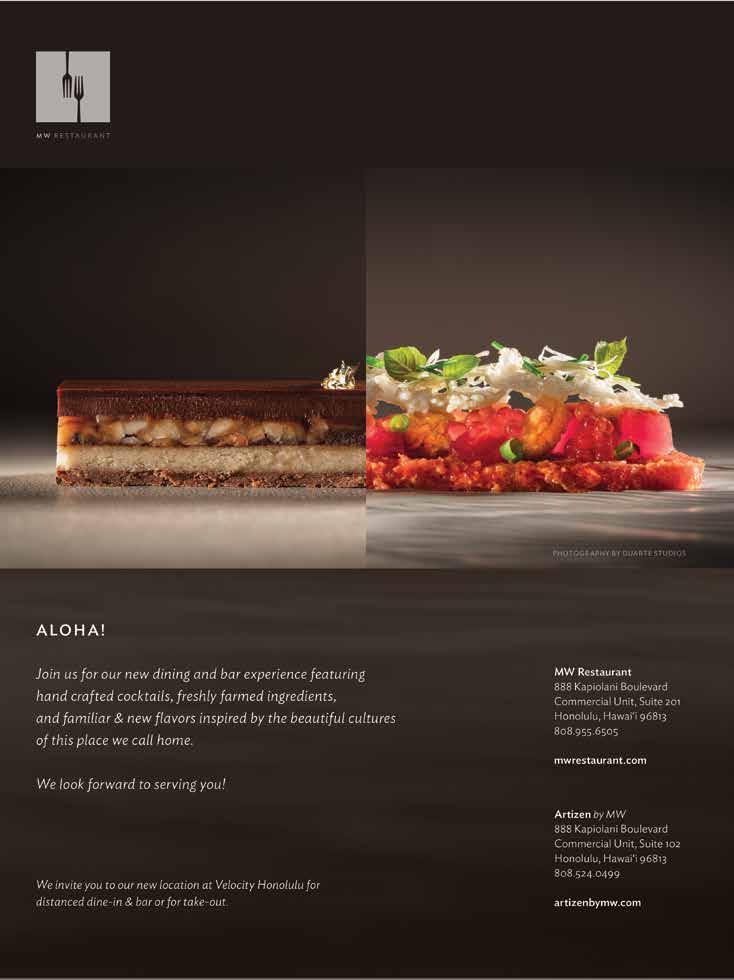
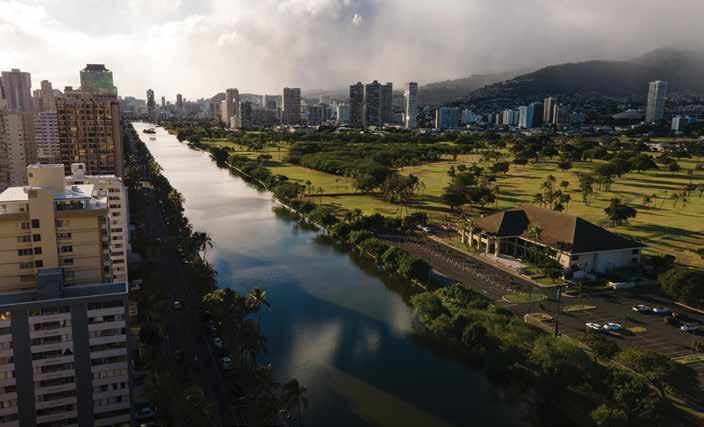
The Ala Wai Canal is a Waikīkī landmark, but has long been plagued by urban runoff. The Genki Ala Wai Project is using bioremediation to restore the waters, with the ultimate goal being to make the canal safe for fishing and swimming.
The volunteers threw and reloaded and threw again until 2,625 balls had been tossed. Upon sinking to the canal floor, the balls began digesting layers of harmful contaminants and thick sludge that have built up over decades, restricting the water’s oxygen levels.
The Genki Ala Wai Project, a nonprofit group formed in 2019, has gathered community partners—including Hawaiian Airlines—to accomplish one goal: Make the Ala Wai Canal safe for fishing and swimming by 2026. The science applied is called bioremediation, which is the use of living organisms to remove pollutants from soil and water. “This is the first project of its kind in the country and allows children and adults to work together toward an easy solution for a big problem,” said Hiromichi Nago, project advisor and president of EM Hawaii, LLC, the distributor of the specific microbial mixture used to make the Genki Balls.
Hawaiian Airlines has supported the Genki Ala Wai Project through financial
donations and volunteers since 2022. For example, thousands of our employees made and tossed about 10,490 Genki Balls into the Ala Wai during a company-wide purpose and values retreat last fall. Our various workgroups have also leveraged the tossing events for team bonding.
“Restoring the Ala Wai has long been a challenge for our community, but over the past few years, there has been this collective understanding that returning those waters to a healthy state is a critical step in creating a more resilient and sustainable Hawai‘i,” explained Debbie Nakanelua-Richards, director of community and cultural relations at Hawaiian. “The Genki Ala Wai Project has helped people rise and find a role in what seemed like an unsolvable problem.”
A $109,500 grant given by the Hawaiian Airlines Foundation to Kāko‘o ‘Ōiwi has
been used to construct the Windward O‘ahu nonprofit's new Ho‘olauana Wash Pack Station. The 4,000-square-foot building is fully equipped with washtubs and tumblers, airtight storage spaces and temperature-controlled chillers. The doorless entrances invite the breeze from the Ko‘olau Mountains and offer expansive views of the 405 acres of land that Kāko‘o ‘Ōiwi manages.
Kāko‘o ‘Ōiwi Executive Director Jonathan Kanekoa Kukea Shultz explained that the Ho‘olauana Wash Pack Station will play a critical role in improving the efficiency of community food production efforts. “A few years ago, we opened a commercial kitchen and poi mill to prepare our product. But when you have a 405-acre farm, those kitchens get overwhelmed pretty quickly—especially when other farms and friends are asking to use them too. With the support of the Hawaiian Airlines Foundation, we were able to build this wash pack area, which will allow us to free up space, streamline
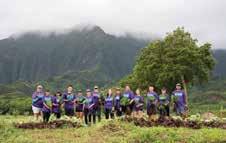
Last December, members of Hawaiian Airlines’ Team Kōkua employee volunteer group helped harvest kalo (taro) to celebrate the completion of Kāko‘o ‘Ōiwi’s Ho‘olauana Wash Pack Station.
our production and process not only our materials but other small farms’ too.”
The Ho‘olauana Wash Pack Station will also make it easier for farmers to sell their products by acting as a hub of sorts. Kāko‘o ‘Ōiwi is situated in the ahupua‘a (land division) of He‘eia and is accessible by four major transportation arteries— the Likelike Highway, the Pali Highway, Interstate H-3 and the Kamehameha Highway. When traffic is mellow, the farm is only about a 30-minute drive from O‘ahu’s urban neighborhoods.
“Instead of having farmers from fartheraway communities drive, they can just drop off at Kāko‘o,” said Shultz. “We can then aggregate, and hotels, restaurants and others can pick up here.”
Kō Hana Takes Off
A Hawai‘i rum maker’s modern take on cocktail classics are now available for purchase in the main cabin of our flights between Hawai‘i and North America, American Sāmoa, the Cook Islands and Tahiti. The Kō Hana Rum craft cocktails, including a tangy Pineapple Daiquiri and a reimagined Mai Tai, are both made with fresh ingredients and Hawaiian Agricole rum farmed in the heart of O‘ahu.
The Mai Tai is made with two Kō Hana rums, bright orange and lime flavors and a hint of orgeat. The Pineapple Daiquiri includes notes of fresh pineapple, lime and a Kō Hana white rum.
“At Kō Hana, we have always cherished the spirit of collaboration with local businesses, but partnering with Hawaiian Airlines takes our
commitment to a whole new altitude,” says Tiffany Tubon, brand manager at Kō Hana Rum. “This collaboration not only elevates the in-flight experience but also celebrates the essence of Hawai‘i and creates unforgettable memories from departure to arrival.”
Our partnership with Kō Hana supports our goal to increase local sourcing of food and beverages. Last year, 32 percent of our catering budget was spent on Hawai‘i-produced items served on flights departing the Islands, and we are aiming to bring this number up to 40 percent by 2025. Those exploring O‘ahu can add a tour of Kō Hana Rum’s distillery, farm and tasting room to their itinerary by visiting KoHanaRum. com. To see our full menu and learn more about our other local in-flight products, visit HawaiianAirlines.com/ our-services/in-flight-services/diningand-drinks.
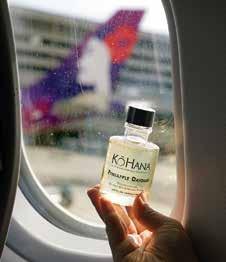
Kō Hana Distillers’ Pineapple Daiquiri (pictured) and Mai Tai are available for purchase on select Hawaiian Airlines flights as part of our ongoing effort to increase local sourcing of food and beverages.
Starting May 15, we will welcome guests flying between Salt Lake City, Utah, and Honolulu onboard our 189-seat Airbus A321neo aircraft. “We know this new route will excite travelers in both Utah and Hawai‘i given our tourism and education ties, and shared Pacific Island communities,”
said Hawaiian Airlines President and CEO Peter Ingram. “We are eager to strengthen these relationships when we launch the new service.”
Utah has one of the highest concentrations of Pacific Islanders in the country with about 60,000 residing in the state. Salt Lake City becomes Hawaiian’s sixteenth gateway city in the continental United States, the most of any carrier serving the Islands.
HA84 will depart Honolulu at 6:50 p.m. and arrive at Salt Lake City at 5:15 a.m. the following day, while HA83 departs Utah at 7:00 a.m. with a 9:55 a.m. arrival in Honolulu. This will allow guests to maximize their first day at either destination.
“Hawaiian Airlines’ expanded service is a response to meaningful demand from one of our top twenty US markets, and provides more opportunities for our kama‘āina to travel and for friends and family members to return to Hawai‘i,” said Daniel Nāho‘opi‘i, Hawai‘i Tourism Authority’s interim president and CEO. “We appreciate the airline’s longstanding commitment to serving the people of Hawai‘i and bringing mindful visitors to our state.”
Guests onboard Hawaiian’s A321neos will enjoy authentic Hawaiian hospitality, including complimentary meals and superior comfort with 16 luxurious leather recliners in the Premium Cabin, 45 Extra Comfort premium economy seats and 128 Economy seats. Guests will also have access to wireless streaming entertainment, USB outlets and additional overhead stowage space. Hawaiian is currently equipping its fleet of 18 A321neos with high-speed Starlink internet, which we launched earlier this year on outfitted aircraft.
For more news and information about our airline ‘ohana, visit newsroom.hawaiianairlines.com



Marshmallow marauders, puff daddies, goofs on loofas—call them what you may, soft-top surfers are totally … well, softcore. It’s the craze that’s taken the surfing world by Wavestorm over the last decade or so: bloatillas of mass-produced boards with soft foam tops, known colloquially as “foamies,” churned out by the gazillion to choke lineups like herds of polystyrene manatees.
Given my bad attitude about the muffin-top revolution, perhaps the last place you might expect to find me is competing in the Red Bull Foam Wreckers, a novelty surfing event intended to showcase foamies’ alleged boundless capacity for fun. Yet here I am, waiting my turn to spin the gameshow-style “Wheel o’ Shred” to find out which model of foamie I’ll be riding in my heat at O‘ahu’s notorious Sandy Beach shore-slam.
Admittedly, I had heretofore eschewed soft boards as terminally dorky, but apparently that’s the point. “When I first started taking soft-tops out, I kind of weirdly liked it that everyone was so anti about them,” says Foam Wrecker host Jamie O’Brien, or “J.O.B.,” the celebrated Pipeline charger who has become the Sultan of Sponge thanks
to his wildly popular foamie antics on YouTube. “The next thing you know, I was getting huge waves on these soft boards and pushing boundaries that no one even knew were there.”
Today’s soft-top tsunami first broke back in 2006, when the Wavestorm brand of full-length foamies launched. Famously hawked at Costco for just $99, the Wavestorm became the most popular surfboard in history by orders of magnitude. It wasn’t long before the pros went soft too, spurred on by the higher-performance Catch Surf brand hyped by bigger-than-life stars—J.O.B. at the lead—forging a whole new kind of surfing career as personality-driven daredevil vloggers.
Which brings us back to Foam Wreckers, which Red Bull touts as “the anti-surf contest surf contest” featuring “minimal rules and maximum fun.”
Anyone can sign up and boards are provided, so when my shreditor rang to ask if I would cover the event for the Hou, I figured it was finally my time to join the foam party.
An unexpected late-season swell is hitting, and some of the better contestants are pulling crazy stunt moves. As one young ripper rides tall into a no-exit shore grinder, he
Special correspondent Derek Ferrar (right) grabs his Wheel o’ Shred-assigned soft-top for the Red Bull Foam Wreckers competition while host Jamie O’Brien (far left) emcees.
casually pulls a Red Bull can out of his boardshorts and mock-chugs it into oblivion. “You’re sponsored!” bellows the announcer.
With Jamie on the mic, I give the wheel a spin and draw a stubby model that would be a better match for some shredder kid a third my age, half my weight and five times my ability. But them’s the breaks when you’re a Foam Wrecker. Since the Halloween-time event encouraged costumes, I paddle out in classic journo getup: action slacks, bush shirt and a rattan fedora fitted with a homemade waterproof press card. I figure what I lack in talent I can make up for with style.
Thankfully, our heat is slow, with the bigger sets taking a breather. When I’m finally able to scratch into one, it’s a sure trip over the falls. But it does yield one fleeting photographic moment: me perched at the top of the wave, committed to the drop, press hat intact and safari shirt flapping. It even earns me enough points not to finish dead last—bonus!
When all is done and dusted, first-place goes to underground ripper Connor Caldwell, who entered only after he saw how good the waves were. He crushed the final on a small, finless Beater model, sideslipping into deep tubes, then streaking out into a series of effortless spins. At the podium he says only, “I like barrels.”
So yeah, Foam Wreckers was indeed maximum fun. I’ve even softened a little on soft-tops. Like my foamie homey J.O.B. told me: “It’s all about being able to ride anything and having no expectations. That way, it’s easy to exceed them.”hh



